AXANI
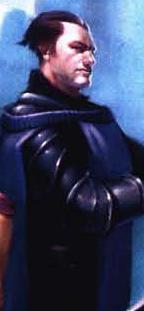
Axani typically have overly neat, orderly appearances. They favor simple but elegant clothing and hairstyles. They are often quite attractive, with well-formed, symmetrical features. Some axani have a metallic tint to their skin or hair, but this is rare. Like elves, Axani have no facial or body hair. As their lineage indicates, most are lawful neutral, with lawful good and lawful evil as roughly equal minorities. Neutral axani are extremely rare, and chaotic axani are almost unheard of. Axani are drawn to the ordered, principled life of the monk, but any profession with a structured environment, such as soldiering, suits them.
AXANI RACIAL TRAITS
-
+2 Intelligence, +2 Wisdom: Axani are logical and calculating, but tend to be cold and emotionless.
-
Outsider: Axani are native outsiders.
-
Medium-size.
-
Axani base speed is 30 feet.
-
Darkvision up to 60 feet.
-
Cold and sonic resistance 5.
-
Calm Emotions (Sp): Axani can cast the calm emotions spell once per day as a cleric of their character level.
-
+2 racial bonus to Diplomacy and Spot checks: Axani are good at arguing their points logically, and they are perceptive to disturbances in their environment.
-
Automatic Languages: Common. Bonus Languages: Any (except secret languages, like Druidic).
-
Favored Class: Monk.
-
Level Adjustment: +1. Axani are slightly more powerful and gain levels more slowly than most other common races.
CANSIN
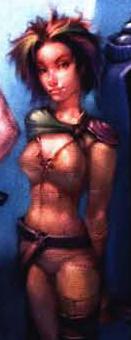
Children of randomness and entropy, cansin are most often descended from the inhabitants of Limbo, the plane of chaos. Cansin generally appear disheveled and disorganized. Their clothing is mismatched, their hair is mussed, and their caps perch at odd angles. Cansin typically have at least one, but possibly several, minor physical traits that reflect their origins. Some have eyes that randomly change color (not necessarily in sync), others have slightly irregular features, and still others carry around an aura of randomnes that causes strange things to happen in the cansin's presence. This aura does not affect dice rolls in any way, of course, but it can affect insignificant events such as chance meetings, minor accidents, and strange but harmless occurances. Naturally, most cansin are chaotic, but their very unpredictability makes neutral and even lawful cansin more common than good tieflings, evil aasimar, or chaotic axani.
CANSIN RACIAL TRAITS
-
+2 Intelligence, +2 Charisma: Cansin are flamboyant and vivacious, capable of stunning leaps of deductive reasoning, and others often find their impulsiveness intriguing.
-
Outsider: Cansin are native outsiders.
-
Medium-size.
-
Cansin base speed is 30 feet.
-
Darkvision up to 60 feet.
-
Acid and fire resistance 5.
-
Entropic Shield (Sp): Cansin can cast entropic shield once per day as a cleric of their character level.
-
+2 racial bonus to Bluff and Search checks: Cansin are good at coming up with involved fabrications on the spot, and they often find what they are looking for by chance.
-
Automatic Languages: Common. Bonus Languages: Any (except secret languages, like Druidic).
-
Favored Class: Sorcerer.
-
Level Adjustment: +1. Cansin are slightly more powerful and gain levels more slowly than most other common races.
DUST PARA-GENASI
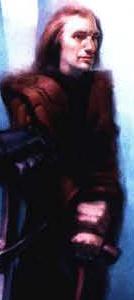
Dust para-genasi tend to be morbid and sarcastic. They are most often neutral, but many of them have a slightly chaotic bent. They are pale and gaunt, with hollow cheeks and dark circles under their eyes. They usually have at least one or two traits that hint at their ancestry, such as perpetually dry skin or a cloud of dust that clings to them wherever they go. They almost always dress in black, and more often than not they wear funeral garb, even when such garb would be highly inappropriate.
DUST PARA-GENASI RACIAL TRAITS
-
+4 Dexterity, +2 Intelligence, -2 Constitution, -2 Charisma: Dust para-genasi are surprisingly nimble and sharp, but they are often sickly, and their morbid fascination with death and decay is off-putting.
-
Outsider: Dust para-genasi are native outsiders.
-
Medium-size.
-
Dust para-genasi base speed is 30 feet.
-
Darkvision up to 60 ft.
-
+1 racial bonus on saving throws against dust spells and effects (such as dust of dryness or a dust mephit's breath weapon). This bonus increases by +1 for every five character levels the para-genasi attains.
-
Dust Cloud (Su): Once per day, a dust para-genasi can create a 20-foot radius cloud of dust, centered on himself. This cloud grants concealment (20% miss chance) to any creature more than 5 feet away from another within the cloud, and all creatures except the dust para-genasi must make a Fortitude save (DC 10 + 1/2 level + Charisma modifier) or begin coughing uncontrollably. This coughing imposes a -2 penalty to attacks and skill checks, and it lasts until the victim leaves the cloud. The dust cloud lasts for 5 minutes.
-
Breathless (Ex): Dust para-genasi do not breathe, so they are immune to drowning, suffocation, and attacks that require inhalation (such as some types of poison).
-
Clerical Focus: A dust para-genasi cleric must choose a deity who grants access to either the Air or Earth domains and must choose either Air or Earth as one of his two domains.
-
Automatic Languages: Common. Bonus Languages: Any (excluding secret languages, like Druidic).
-
Favored Class: Rogue.
-
Level Adjustment: +1. Dust para-genasi are slightly more powerful and gain levels more slowly than most other common races.
ICE PARA-GENASI
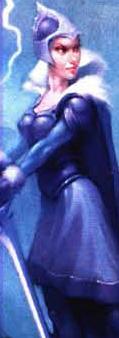
Ice para-genasi are cold, emotionless beings. Like most genasi, they tend toward neutrality. They appear human, but their features are often sharper and more chiseled than normal, and their skin is paler than the norm for their race. In addition, they have one or two minor supernatural traits that hint at their heritage, such as breath that frosts in even the hottest weather or frost-caked hair. They prefer loose, light clothing in whites and pale blues, even in cool climates.
ICE PARA-GENASI RACIAL TRAITS
-
+4 Constitution, +2 Wisdom, -2 Dexterity, -2 Charisma: Ice para-genasi are hearty and observant, but they are sluggish and often seem uncarring.
-
Outsider: Ice para-genasi are native outsiders.
-
Medium-size.
-
Ice para-genasi base speed is 30 feet.
-
Darkvision up to 60 ft.
-
+1 racial bonus on saving throws against cold effects. This bonus increases by +1 for every five character levels the para-genasi attains.
-
Chill Metal (Sp): Ice genasi can use chill metal once per day as a druid of their character level.
-
Clerical Focus: An ice para-genasi cleric must choose a deity who grants the Air, Cold, or Water domain and must select either Air, Cold, or Water as one of her two domains.
-
Automatic Languages: Common. Bonus Languages: Any (except secret languages, like Druidic).
-
Favored Class: Fighter.
-
Level Adjustment: +1. Ice para-genasi are slightly more powerful and gain levels more slowly than most other common races.
MAGMA PARA-GENASI
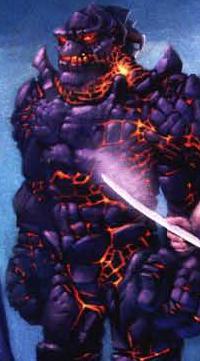
Ponderous but powerful, magma para-genasi combine many of the traits of their earthen and fiery ancestors. Like all para-genasi, they tend toward neutrality. They are usually short and stocky, sometimes to the point of resembling tall dwarves. They usually have dark skin, and they typically possess waits that mark them as unusual. They might have a reddish glow to their skin or eyes, feel unusually hot to the touch, or have hair that ripples like fire. They tend toward simple, utilitarian clothes, which often seem disturbingly close to smoldering.
MAGMA PARA-GENASI RACIAL TRAITS
-
+2 Constitution, +2 Strength, -2 Intelligence, -2 Wisdom: Magma para-genasi are strong and tough, but they think slowly and uncertainly.
-
Outsider: Magma para-genasi are native outsiders.
-
Medium-size.
-
Magma para-genasi base speed is 30 feet.
-
Darkvision up to 60 ft.
-
+1 racial bonus to saving throws against fire spells and effects. This bonus increases by +1 for every five character levels the para-genasi attains.
-
Heat Metal (Sp): Once per day, magma para-genasi can cast heat metal as a sorcerer of their character level.
-
Cleric Focus: A magma para-genasi cleric must choose a deity who grants access to the Earth or Fire domains and must choose Earth or Fire as one of his domains.
-
Automatic Languages: Common. Bonus Languages: Any (except secret languages, like Druidic).
-
Favored Class: Fighter.
-
Level Adjustment: +1. Magma para-genasi are slightly more powerful and gain levels more slowly than most other common races.
OOZE PARA-GENASI
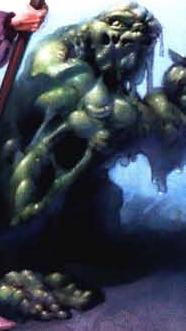
Ooze para-genasi are repulsive and slimy (both physically and in personality). They are most often neutral, but they have a slight tendency toward evil. They are usually heavyset, with flabby bodies and sallow skin. Most exhibit a small number of traits that hint at their ancestry, such as greasy skin or unusually flexible limbs. They wear dark earth tones, and their clothing is often soiled and foul smelling. They are, on a whole, utterly revolting.
OOZE PARA-GENASI RACIAL TRAITS
-
+4 Constitution, -2 Charisma: Ooze para-genasi are hardy and resilient, but many other races find them repulsive.
-
Outsider: Ooze para-genasi are native outsiders.
-
Medium-size.
-
Ooze para-genasi base speed is 30 feet.
-
Darkvision up to 60 feet.
-
+1 racial bonus on saving throws against acid spells and effects. This bonus increases by +1 for every five character levels the genasi attains.
-
Grease (Sp): Ooze para-genasi can use grease once per day as a sorcerer of their character level.
-
Clerical Focus: A ooze para-genasi cleric must choose a deity who grants access to the Earth, Slime, or Water domains and must choose Earth, Slime, or Water as one of his domains.
-
Automatic Languages: Common. Bonus Languages: Any (except secret languages, like Druidic).
-
Favored Class: Fighter.
-
Level Adjustment: +1. Ooze para-genasi are slightly more powerful and gain levels more slowly than most other common races.
SMOKE PARA-GENASI
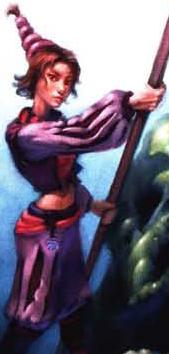
Smoke para-genasi seem crude and lazy. They tend toward neutrality, like all genasi and most elementals. Smoke para-genasi are tall and lanky, reflecting their heritage of air and fire. They tend to have dark skin and hair, and like other genasi have one or two unusual traits, such as hair that billows like clouds of smoke or the faint whiff of something burning clinging to them. They prefer loose clothing in dark colors and heavy fabrics.
SMOKE PARA-GENASI RACIAL TRAITS
-
+2 Dexterity, +2 Intelligence, -2 Charisma: Smoke para-genasi are naturally quick and intelligent but are often unpleasant.
-
Outsider: Smoke para-genasi are native outsiders.
-
Medium-size.
-
Smoke para-genasi base speed is 30 feet.
-
Darkvision up to 60 ft.
-
+1 racial bonus on saving throws against smoke and cloud-type effects (such as stinking cloud and cloudkill). This bonus increases by +1 for every five character levels the para-genasi attains.
-
Smoke Cloud (Su): Smoke para-genasi can create a smoke cloud once per day. This ability functions exactly like the effect of the pyrotechnics spell of the same name, except that the smoke para-genasi does not require an open flame to use it. The para-genasi uses this ability as a sorcerer of his character level.
-
Clerical Focus: A smoke para-genasi cleric must choose a deity who grants access to the Air or Fire domains and must choose Air or Fire as one of his two domains.
-
Automatic Languages: Common. Bonus Languages: Any (except secret languages, like Druidic).
-
Favored Class: Wizard.
-
Level Adjustment: +1. Smoke para-genasi are slightly more powerful and gain levels more slowly than most other common races.
STEAM PARA-GENASI
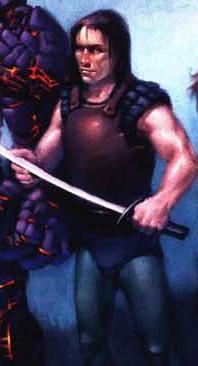
Bossy and egotistical, steam para-genasi often see themselves as inherently superior to other creatures, including other para-genasi. They tend toward neutrality, like their elemental forefathers. Steam para-genasi are usually tall and slim, and often weigh less than their appearance suggests. Like other para-genasi, they have one or two unusual traits, such as wisps of mist constantly clinging to them or a grey tone to their skin or hair. Their clothing is usually loose, flowing, and gauzy.
STEAM PARA-GENASI RACIAL TRAITS
-
+2 Dexterity, -2 Charisma: Steam para-genasi are nimble and quick, but they tend to be bossy and have oversized egos.
-
Outsider: Steam para-genasi are native outsiders.
-
Medium-size.
-
Steam para-genasi base speed is 30 feet.
-
Darkvision up to 60 ft.
-
+1 racial bonus on saving throws against heat-based (but not fire-based) spells and effects, such as heat metal or a magmin's fiery aura. This bonus increases by +1 for every five character levels the para-genasi attains.
-
Obscuring Mist (Sp): Once per day, a steam para-genasi can cast obscuring mist as a druid of her character level.
-
Keen Eyed (Ex): Steam para-genasi can see through smoke, fog, and other atmospheric effects unusually well. Reduce the miss chance caused by concealment by 10% when the target's concealment results from such atmospheric disturbances.
-
Clerical Focus: Steam para-genasi clerics must choose a deity who grants access to the Fire or Water domains and must choose Fire or Water as one of her two domains.
-
Automatic Languages: Common. Bonus Languages: Any (except secret languages, like Druidic).
-
Favored Class: Rogue.
-
Level Adjustment: +1. Steam para-genasi are slightly more powerful and gain levels more slowly than most other common races.
MORTIF
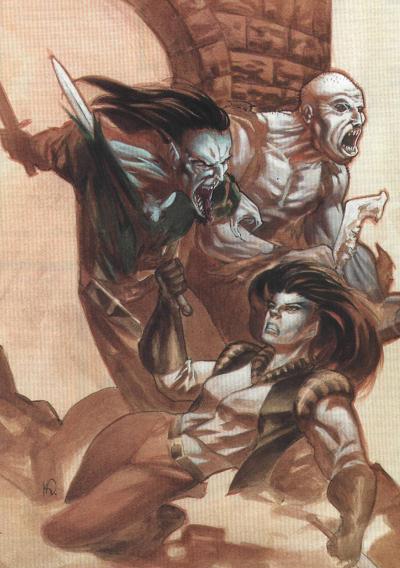
The deathtouched trace their ancestry to a half-undead being - usually a katane or the victim of a bungled resurrection. Although rarely recognized as such, the taint of unlife lingers through generations, and a deathtouched can manifest abilities derived from its unliving ancestor.
Deathtouched tend to be pale and thin, with black, dirty brown, or gray hair. Many have some small physical feature that belies their heritage, such as sharpened canines, a ghoul-like tongue, a faint smell of the grave, eyes that glow red, yellow, or green in low light, or tight, corpselike skin. They wear the clothing and hairstyles of the region they live in but favor fashions that conceal their nature and discourage notice. Deathtouched can be reclusive and are prone to fits of depression that last days or even weeks at a time. They become fond of anyone who can understand or tolerate their affliction.
Most races do not trust creatures that are undead, in whole or in part, and a deathtouched whose ancestry has been exposed is likely to be driven off or killed. Some elves consider them abominations that must be hunted to extinction. This causes most deathtouched to be fearful of others. Neither can deathtouched expect acceptance from their undead kin, who see them as no different from other mortals. Certain cults of death gods treat deathtouched with respect, though, and necromancers might welcome them in exchange for skin, hair, and blood samples, which are invaluable to their experiments. Deathtouched feel a kinship with tieflings but do not get along well with aasimar.
Like the planetouched, the deathtouched have no society or culture of their own and instead blend into existing ones. Mortif, the deathtouched described here, are the most common variety: humans with an undead or half-undead forebear. Other races might also have deathtouched members.
Mortif adventure out of greed, a need for meaning, or a desire for self-validation. Some go out of their way to hunt down their undead progenitor, or all undead, to exact revenge for their torment-filled lives. Others seek to gain mastery over their nature or to gain acceptance by their fellow citizens. Mortif are usually neutral, though there are many chaotic and lawful individuals in their number. Their isolation from society discourages loyalty to any but themselves.
Mortif fight out of self-preservation or greed. They do battle when and if it benefits them and usually protect their own hides before their honor or reputation.
MORTIF RACIAL TRAITS
-
-2 Constitution, +2 Wisdom, +4 Charisma.
-
Medium size.
-
A deathtouched's base land speed is 30 feet.
-
Darkvision: Mortif can see in the dark up to 60 feet.
-
Racial Skills: Deathtouched have a +2 racial bonus on Intimidate and Move Silently checks.
-
Chill Touch (Sp): A mortif can use chill touch once per day as a 1st-level caster or as a caster of his character level, whichever is higher. Using this ability relieves some of the psychic pressure of the mortif's heritage and is a pleasurable experience.
-
Cold and electricity resistance 5.
-
Automatic Language: Common. Bonus Languages: Any except for secret languages.
-
Favored Class: Sorcerer.
-
Level Adjustment: +1.
GHOST ELVES
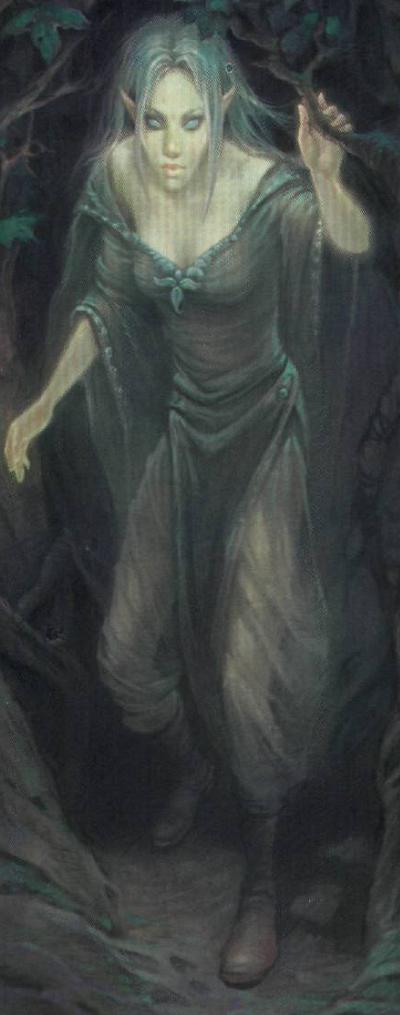
In the depths of the primordial forests, spectral citadels are home to elves unlike any others. Dubbed "ghost elves" for their eerie appearance, this rarely encountered subrace has given rise to a thousand tales of forest demons and lost civilizations. The legacy of the ghost elves is a tale of conflict, betrayal, and vengeance. After a struggle for survival that stretches back to the fall of the drow, the ghost elves now flourish in cities built on the Ethereal Plane. Suspicious and reclusive, they welcome few strangers into their halls.
Ghost elves dwelt on the fringes of elven society. They made their homes amid the ancient roots of the forests, rarely making contact with other races. Over time the ghost elves grew more and more isolated, eventually becoming little more than a legend.
Thousands of years ago, during the elven civil war that led to the fall of the drow, the ghost elves maintained their isolation and remained neutral in the great racial struggle. After the defeated drow retreated into the Underdark, they schemed against their distant cousins and soon launched an assault on the ghost elves. The very shelter that had kept the ghost elves safe became fiercely contested battlegrounds. The peaceful ghost elves were no match for the seasoned dark elven troops and were easy fodder for the sacrificial altars of Lolth. They were virtually wiped out in the blink of an eye. The other surface elves were either unwilling or unable to aid their beleaguered kin, something the ghost elves have never forgotten or forgiven.
Help eventually arrived - from an unexpected source. As the defenses of the last settlement were collapsing, an alien entity calling itself Thule appeared and offered to save the ghost elves in return for their service. Appalled at the slaughter of their people, the ghost elven leaders agreed without a second thought, signing the contract that Thule proffered.
They were foully tricked. Thule revealed himself as the Archduke Thulikazt, a pit fiend of almost godlike power, and took the ghost elves to his home in the Nine Hells of Baator. There he enslaved them, slowly destroying their spirits and their strong connection to the land. The ghost elves called upon their deities to save them, but to no avail - Thulikazt's bargain was binding. For hundreds of years, they toiled for the archfiend, and thousands were slaughtered in savage arena battles and pointless experiments for Thulikazt's pleasure. Ghost elven historians call this time "the Tempering."
Countless centuries passed and Thulikazt grew lax, allowing his slaves (whom he believed completely broken) to take up arms and join his forces in the Blood War. The ghost elves learned the arts of war and conquest from fiendish generals and hellish sorcerers. They became Thulikazt's elite bodyguard, drawing admiration and envy from other fiends. This would prove the archduke's ultimate undoing.
The ghost elves secretly contacted their master's enemies and offered to serve those lesser fiends in return for aid in destroying their hated master. Greedy for the service of Thulikazt's elite troops, the baatezu lords formed an alliance to lay siege to his citadel. The ghost elves used the battle as a distraction, killing Thulikazt and opening a gate to the Material Plane in the confusion. When the fortress finally fell, the fiendish generals found only Thulikazt's mutilated corpse and a note of thanks. The ghost elves had won their freedom.
Fearing fiendish retribution, the ghost elves searched for somewhere to hide. It was then that they noticed a startling change in themselves: By severing their connection to the earth, Thulikazt had accidentally gifted the ghost elves with a strange connection to the Ethereal Plane, granting the most powerful ghost elves the ability to slip between the material world and the Ethereal Plane. Upon coming to grips with their newfound powers, the ghost elves set about creating a portal to the Ethereal Plane, and one stone at a time, they transferred materials to the Ethereal Plane to build their new homes.
Today ghost elves live on the Ethereal Plane. Their cities are usually built deep in woodlands and all are at least partially underground. Due to their long captivity and the dangers their settlements attract, their society has a strong martial bent. A thousand years have not cooled the anger of the devils humiliated by "elven treachery," and even today they seek out and destroy ghost elves whenever they can. For their part, the ghost elves launch preemptive strikes against their enemies whenever possible, relying on their hidden cities for defense.
Personality: The ghost elves have been strongly affected by their history. Before the Tempering, they were a carefree people with a passion for life. Much of that has evaporated, replaced by a harsher outlook. The typical ghost elf now seems a stern creature with little passion. In truth, ghost elves are gentle and nurturing at heart, forced to extreme measures to survive. They are wary; earning their trust involves many subtle tests and trials. Never intentionally haughty, a trait they despise in their cousins, they maintain a distance that makes them seem cold.
Ghost elves are still passionate about their homes and people, and they defend these to the last, exacting terrible vengeance against those who wrong them. A serious, calculating mindset allows them to hold their own against their many enemies. Dwarves compare ghost elves to mithral: beautiful and delicate in appearance, but stronger than the hardest steel.
Physical Description: Ghost elves have the same range of height and weight as elves but are slightly frailer, a consequence of the destruction of their bond with the land. They reach adulthood at about age thirty and have a life span roughly a hundred years shorter than that of other elves, although they do not show their age until a few years before death.
Gray hair and pale skin are nearly universal, with the occasional throwback having jet-black hair. The eyes of ghost elves are their most striking feature; they are like twin mirrors lacking white, iris, and pupil. Their skin glows with a pale white light in the darkness. They are often mistaken for ghosts even by other elves, hence their name.
Ghost elven attire is usually light and flowing, colored gray, silver, or white. In battle, they favor light armor such as leather or mithral shirts. On the Material Plane they dress like ordinary elves in an effort to disguise themselves from distant observers.
Relations: Ghost elves deliberately limit their contact with half-orcs and halflings, whose intentions they do not trust. Gnomes are a mystery to the ghost elves - although the two races have a lot in common, the less-than-serious outlook of the little folk prompts the elves to keep them at arm's length. Humans and dwarves intrigue the ghost elves, who frequently spy on them from the Ethereal Plane and occasionally contact them in the guise of ordinary elves.
The few Material elves who know of their ethereal kin pity their plight, and the ghost elves hate them for it. They believe themselves betrayed by their cousins and snub those they happen to meet. Ghost elves treat half-elves as they do humans, giving them the benefit of the doubt. Half-ghost elves are so rare as to be practically unique, so there is no general opinion on them.
The only mortal race the ghost elves truly despise are the drow, whom they treat mercilessly. An individual ghost elf will go to extraordinary lengths to hurt any dark elf that crosses her path. Many drow raiding parties have been thwarted by elves who materialized from thin air - centuries in the service of fiends has forged the ghost elves into warriors of deadly cunning and ability.
Alignment: The trials of the ghost elves have shifted their generally good nature to one of neutrality. A ghost elf is willing to do whatever is necessary to survive. The handful of Material Plane dwellers who have conversed with ghost elves describe them as almost humorless in comparison to their cousins. Neutral is the most common alignment among ghost elves, with a minority tending to neutral good. Adventuring ghost elves can be of any alignment but are typically neutral or chaotic good.
Ghost Elven Lands: Ghost elves favor building their homes adjacent to ancient Material Plane forests, which often hold a secret portal to the Ethereal Plane. They treasure privacy above all and hide these entrances with powerful magic. The greatest challenge facing a would-be diplomat to the ghost elves is finding any evidence of their existence at all.
These forests gain reputations as being haunted, and neighboring peoples sometimes speak of "forest demons." Sylvan creatures are aware of the ghost elves' presence but rarely mention them. The elves have an ancient friendship with the woodland beings and are grateful for their silence.
Ghost elven cities are wondrous places, lit by silvery light and laid out without regard to gravity. They are often covered with imported vegetation that has grown into bizarre shapes under the unusual influence of the Ethereal Plane. Visitors must contend with streets that wind up, down, and from side to side. Domesticated phase spiders occasionally roam the cities but are more commonly found in ghost elven patrols. The typical settlement houses many more inhabitants than a Material Plane counterpart: Ghost elves band together for protection and are accustomed to close quarters after their long captivity. A typical community numbers about a thousand, and every adult member is able to bear arms in times of crisis. The elves produce food by cultivating plants from the Material Plane, and by foraging and occasionally hunting in material forests bordering their ethereal cities. Ghost elven kings keep in contact through messengers and magic, allying to help one another as the need arises.
Ghost elven cities have well-protected gateways to and from the Ethereal Plane that allow lower-level ghost elves access to the Material Plane, as only powerful ghost elves can cross the boundaries between the planes on their own. The stern ghost elves do not open such portals lightly, but they sometimes permit young ghost elves to sate wanderlust on the Material Plane rather than allow them to be exposed to the dangers of the Ethereal that often lurk outside the well-guarded ghost elven cities.
Ghost elves encountered in human lands are usually either outcasts or on some special mission. They take pains to hide their ancestry, using disguises and claiming to be from some obscure Material Plane tribe. If their tell-tale eyes are somehow hidden, most folk cannot tell the difference between normal elves and disguised ghost elves; even other elves can be fooled.
Religion: The ghost elves abandoned the elven pantheon during the Tempering. Those deities did nothing to aid them in their plight and so deserve no worship. During their time in Baator, many ghost elves turned to the dwarven god Moradin in his aspect as the Soul Forger, converted by a small group of dwarven slaves also imprisoned by Thulikazt. These ghost elves see themselves as having been forged into a tool for some divine purpose as yet to be revealed. The elven gods' opinion of the ghost elves is unknown, and Moradin himself is strangely silent on the topic. Ghost elves do not build temples; instead, clerics hold small ceremonies within family homes. These events are attended by neighbors and help strengthen the community.
Language: Ghost elves speak an archaic dialect of Elven that is difficult to understand. The language borrows heavily from Infernal, particularly for words relating to battle and magic. Anyone who can speak both Infernal and Elven can pick up the ghost elven dialect after only a little practice. The war with the dark elves destroyed what few written records they had, so the refugees adopted the Infernal alphabet, which they use to this day.
Names: Ghost elves follow their own unique naming traditions, having abandoned their original clan names as divisive and contrary to the unity of their people. Every child is given a first name at birth, usually by his parents, and earns a surname, or "deed name," during the course of his life. The first name is usually Elven in origin, but sometimes a name honors a family friend of another race. The deed name describes some feat, occupation, or event and may change many times as greater deeds take precedence over previous ones. Deed names are taken very seriously, except in the case of children. A ghost elf's first adult deed name usually relates to his chosen profession.
For example, a ghost elf is affectionately called "Mudeater" as a clumsy child for his habit of falling on his face. He later apprentices to a hunter and is called "Truespear" for his skill with a thrown spear. Following a battle where he slew three baatezu warriors, "Truespear" becomes known as "Grimslayer."
Male First Names: Griminnir, Kidsanat, Mendicalt, Peldraco, Quilvarin, Rhilianis, Stiragoth, Tolduart, and Xelunixio.
Female First Names: Akasa, Cherigi, Druilia, Ilrith, Kisurinda, Linseeri, Mistil, Sulista, Theriel, and Tyrisiss.
Deed Names: Barkchewer (child's name), Beast-Tamer, Boltcatcher, Djinnfriend, Flamesinger, Flyslayer (child's name), Mistskulker, Steelbiter, Stonecutter, and Tunnelrunner.
Adventurers: Ghost elves rarely leave their ethereal homes and do not share the wanderlust that distinguishes material elves. Those who do adventure often have a long-term goal: to gain power, allies, or magic to aid their people. Such adventurers may spend centuries abroad. Some never return home, seduced by the enticements of the Material Plane.
Some adventuring ghost elves are outcasts whose temperament does not fit the grim ghost elven society. These are frequently throwbacks to the time before the Tempering and have more in common with their Material kin than their own kind.
GHOST ELF RACIAL TRAITS
-
+2 Dexterity, -4 Constitution, +2 Intelligence: The ghost elves' time away from the Material Plane has weakened them physically. However, they have learned to adapt rapidly to any situation.
-
Medium: As Medium creatures, ghost elves have no special bonuses or penalties due to their size.
-
Ghost elf base land speed is 30 feet.
-
Low-Light Vision: A ghost elf can see twice as far as a human in starlight, moonlight, torchlight, and similar conditions of poor illumination. She retains the ability to distinguish color and detail under these conditions.
-
Immunity to magic sleep effects.
-
Weapon Proficiency: Ghost elves receive the Martial Weapon Proficiency feats for the short sword and scimitar as bonus feats, weapons suited to the fighting styles of fiendish gladiatorial arenas. They do not share their cousins' proficiency with bows: Such weapons are useless in the obscuring mists of the Ethereal Plane. Ghost elven children's games feature practice weapons, ensuring familiarity with the real thing in adulthood.
-
A ghost elf glows with the brightness of a candle in the dark (5-foot radius of light). She can suppress this aura at will as a free action but must make a DC 10 Concentration check as a free action each round to maintain the suppression.
-
+2 racial bonus on Listen, Search, and Spot checks. A ghost elf who merely passes within 5 feet of a secret or concealed door is entitled to a Search check to notice it as if she were actively looking for it.
-
Ghost elves have Knowledge (the planes) as a racial class skill.
-
Ethereal Power (Sp): A ghost elf can invoke her connection to the Ethereal Plane once per day in one of several ways depending on her level. A ghost elf can choose to use the ability available to her at her current level or the ability available at any lower level, but once a ghost elf uses an ethereal power she cannot use another one until the following day. Caster level is equal to the ghost elf's character level.
Level Ethereal Power 1st Slip Binding: The ghost elf gains a +10 enhancement bonus
to Escape Artist checks for 1 minute per level. At 5th level,
this bonus increases to +20, and at 9th level, it increases
to +30.4th See Invisibility: As the see invisibility spell. 6th Blink: As the blink spell. 14th Ethereal Jaunt: As the ethereal jaunt spell. 18th Ethereal Shift: The ghost elf may shift herself and
objects she carries to or from the Ethereal Plane and remain
on the destination plane until this ability is used again or
other magic transports the character to a different plane. -
Automatic Languages: Ghost Elven and Infernal. Bonus languages: Common, Dwarven, Elven, Sylvan, and Terran. Ghost Elven is a blending of Infernal with an archaic form of Elven. A creature that knows both languages can understand Ghost Elven, but a creature that knows only one of the languages must succeed at a DC 15 Sense Motive check to understand a creature speaking Ghost Elven. Reading Ghost Elven writing without knowledge of Ghost Elven or both Infernal and Elven requires Decipher Script checks.
-
Favored Class: Wizard. Many ghost elves specialize in conjuration and transmutation, taking advantage of their control over planar travel and knowledge of extraplanar entities. They spent years mastering these magical arts in the pits of Baator as tools for their escape.
-
Level Adjustment: +1. Ghost elves are more powerful and gain levels more slowly than most other elves.
BOZAK
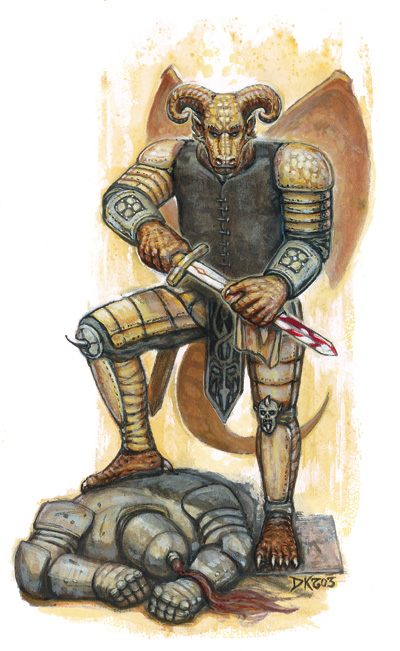
Possessed of magical talent and strong wills, bozaks are natural leaders. They are often willing to give their lives for a cause they deem worthy, but they are intelligent enough to fight to survive and win. Many bozaks have strong religious tendencies, even though they are inherently talented in arcane magic.
Personality: While they are outmatched in most ways by other draconians (strength, stealth, magical ability, and so on), bozaks usually develop sharp, tactical minds and hone skills that allow them to survive. Most bozaks instinctively look to take charge of a situation and excel at military command. Bozaks associate all magic with the gods and quite often have a reverence attached to both their innate and learned magical talents. However, if they feel betrayed by divine forces, they might hold a grudge that lasts a lifetime.
Physical Description: Bozaks are tall - between 6 and 6 1/2 feet - with bronze-hued scales as tiny as fish scales on the their faces and as large as coins elsewhere on their bodies. Bozaks sport a pair of curved, ramlike horns on top of their heads. These horns are merely ornamental, being set too far back on the draconians' heads to serve as weapons. They also have small, dragonlike wings they can use to glide. It is difficult for a nondraconian to tell the difference between bozak males and females, except that the females often have lighter builds.
Most bozaks disdain heavy armor, preferring to retain higher speed and maneuverability. They typically dress in functional clothing, although they follow strict uniform protocols in any military force in which they serve.
Relations: Like most draconlans, bozaks of the first generation were raised to hate all of the races of Ansalon except those creatures that served Takhisis. After the War of the Lance, many joined (or led) other bands of rogue draconians and tried to eke out a living in hiding.
After the conclusion of the Chaos War, some bozaks swore service to Dragon Overlords, while others chased rumors to the new draconian nation formed in Teyr. Like the previous generation, the new bozaks serve well as officers in the draconian military.
Alignment: Bozaks draconians are usually evil, although it is not uncommon for them to shift toward neutrality on the good-evil axis. Disciplined and mindful of rank and authority, they favor law over chaos.
Bozak Lands: Draconians in the first generation were hatched and raised in Sanction. Early in the Age of Mortals, a draconian nation was founded in Teyr, becoming the one and only draconian homeland.
Religion: Bozaks of the first generation possess a strong reverence for the Queen of Darkness, knowing their very existence was due to her planning and cunning. During the Age of Mortals, many bozaks felt betrayed by the Dark Queen and now speak her name only with a curse. Some have chosen to follow other gods, while a few refuse to acknowledge divine powers.
Language: Draconians have no language of their own, instead picking up the speech of Nerakan priests. Because of their life-long military training and organization, much of their speech incorporates military slang and jargon. Bozak commanders know the value of good intelligence, and often learn the languages of their enemies.
Names: The first-generation draconians bear the names assigned to them by their creators, which reflect Nerakan language and culture. Because of their intense military training and long service, most bozaks (and other draconians) possess a name, rank, and assigned regiment. This became a part of the naming convention of the draconians of Teyr, who bestow a given name to their children at birth. Upon joining the military, the bozaks gain "last names" reflecting their rank and regimental affiliations. Bozak names do not differentiate between male and females.
Bozak Names: Bohtox, Drorkar, Fonrar, Gloth, Harvah'k, Kang, Mentax, Oloth, Sokel, Yethik.
Adventurers: While most bozaks prefer to stay among their own kind, the sense of purpose that fills them drives some to strike out on their own - especially if the fulfillment of such a quest might prove important to their fellow draconians.
BOZAK RACIAL TRAITS
-
+2 Strength, +2 Intelligence, +2 Charisma. Bozaks are physically strong, naturally intelligent, and possess forceful personalities.
-
Medium: As Medium creatures, bozak draconians have no special bonuses or penalties due to their size.
-
Dragon: Bozaks are creatures of the dragon type. They are immune to sleep and paralysis effects. Bozaks have darkvision (60-foot range) and low-light vision.
-
Bozak base land speed is 30 feet.
-
Racial Hit Dice: A bozak has 4d12 racial Hit Dice. A bozak character receives maximum hit points for his first bozak Hit Die, and rolls other Hit Dice - racial or from a class - normally. As a result of these racial Hit Dice, bozaks begin with a +4 base attack bonus and base saving throws of Fort +4, Ref +4, Will +4. Bozak draconians with class levels add their class base attack and save bonuses to their racial base attack and save bonuses.
-
Bozak Skills: A bozak's dragon Hit Dice grant him skill points equal to 7 × (6 + Int modifier). Class skills for these skill points are Bluff, Concentration, Diplomacy, Intimidate, Knowledge (arcana), Listen, Search, Spellcraft, and Spot. A bozak character does not get the ×4 multiplier for skill points acquired from his first class level.
-
Bozak Feats: A bozak's dragon Hit Dice grant him two feats. A bozak with class levels gains feats based on his total Hit Dice. Bozaks gain proficiency with all simple weapons, and with the longsword, short sword, and longbow. They are also proficient with light armor and with shields. Bozaks also gain Run as a bonus feat.
-
Natural Attacks: A bozak may use his claws and bite as natural weapons. An unarmed bozak can make 2 claw attacks that deal 1d4 damage (plus Strength bonus) and a secondary bite attack that deals 1d6 damage (plus 1/2 Strength bonus). A bozak wielding a weapon can attack with it as a primary attack and make one claw attack and a bite attack as a secondary attacks.
-
Natural Armor: Bozaks have thick, scaly flesh that provides them a +8 natural armor bonus to AC.
-
Spells: A bozak gains spellcasting ability as a 4th-level sorcerer. When a bozak advances in levels as o sorcerer, it adds its sorcerer levels to these levels to determine its total spellcasting level, access to spells known, and spell per day.
For example, a 9th-level bozak sorcerer has the spells per day, spells known, and caster level of a 13th-level sorcerer.
-
Death Throes (Su): On the round that a bozak dies, its scaly flesh shrivels and crumbles from its bones in a cloud of dust. The bones immediately explode, dealing 1d6 points of damage to all creatures within a 10-foot radius. Affected creatures can attempt a Reflex save (DC 10 + 1/2 the bozak's Hit Dice + the bozak's Constitution modifier) for half damage. Bozaks can only be restored to life through the use of a resurrection, true resurrection, miracle, or wish spell. The save DC is Constitution-based.
-
Disease Immunity (Ex): Bozak draconians are immune to all diseases, even magical diseases such as lycanthropy and mummy rot.
-
Glide (Ex): A bozak can use its wings to glide as an extraordinary ability, negating any damage from a fall from any height. It can also travel horizontally up to four times the vertical distance it descends. A bozak's maneuverability is clumsy while gliding horizontally.
-
Inspired by Dragons (Ex): Draconians are drawn to evil dragons and revere them. When under the command of a dragon, draconians receive a +1 morale bonus on all attack rolls and saving throws.
-
Low Metabolism (Ex): Bozak draconians can survive on one-tenth the food and water it takes to sustain a human.
-
Spell Resistance: Bozaks have spell resistance equal to 14 + class level.
-
Automatic Language: Common. Bonus Languages: Goblin, Nerakese, Ogre.
-
Favored Class: Sorcerer. A multiclass bozak's sorcerer class does not count when determining whether he takes an experience penalty.
-
Level Adjustment: +3. Bozak draconians have an effective character level (ECL) of 7 + class level. Bozaks are more powerful and gain levels more slowly than most other races of Ansalon.
TORTLES
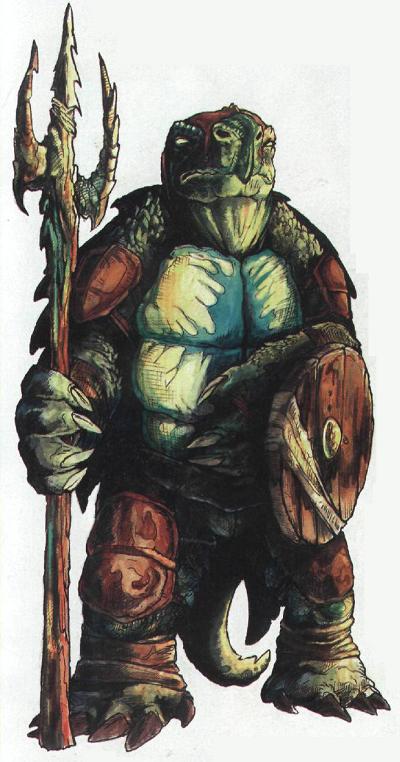
Tortles are humanoid tortoises. Most are peaceful beings, content to ignore the world outside their tribes. Others adapt to the more advanced cultures of the Savage Coast and live as peasants. Each tortle stands approximately 6 feet tall and appears humanlike except for a shell and tail like those of a tortoise.
The natural shell color of a tortle ranges from shiny black to a deep, lustrous purple, and tortle chieftains often encrust their shells with sparkling gems or channel them with gold intaglios. The creature's mouth is beaklike and toothless, and its head, feet, legs, and tail are green, yellow, or black - sometimes one solid color and sometimes pied. Most tortles forego clothing, although warriors often don breastplates and greaves. Tortles speak Tortle and Common. They cannot breathe water, but the Endurance feat aids them in swimming long distances.
Tortles tend to avoid combat whenever possible. When danger threatens, a tortle's first instinct is to plunge into any nearby water and hold its breath until the threat has passed. When forced to fight, tortles form regimented warbales and approach their enemy in groups. Young tortles often form noncombatant bales that carry spare tridents for the warbales.
Most torte tribes along the Savage Coast possess little technology and subsist primarily as hunter-gatherers. They maintain loose contact with other nearby tribes, joining them for hunts, hut building, and other communal activities.
A typical tortle village consists of a cluster of mud and thatch huts just off a beach. Sentry huts, each equipped with a gong or conch shell horn for sounding alarms, form a perimeter 200-300 yards from the central cluster. Notable tortle villages along the Savage Coast are Tlech', R'nach, and Prash. The most unusual tortle settlement is the Free City of Dunwick, which was built around a fallen monastery. Most of Dunwick's citizens are peasant tortles, but representatives from many intelligent races, including goblinoids, dwell there as well. Many of the tortles there embrace the ancient Order of Dunwick and become monks.
Since tortles are adept at working underwater cinnabryl deposits, tribes are often self-sufficient, acquiring their own cinnabryl as well as food, water, and shelter.
Tortles are spiritual creatures. They worship Mother Ocean, the protector: Father Earth, the life-bringer, Brother Shell, the warrior; and Sister Grain, the patron of farmers and fertility. The typical tortle hut contains a seashell shrine dedicated to at least one of these deities. The domains to which these deities can grant access are given on the following table.
| Deity | Domains |
|---|---|
| Mother Ocean | Good, Healing, Protection, Water |
| Father Earth | Animal, Earth, Good, Strength |
| Brother Shell | Destruction, Fire, War |
| Sister Grain | Air, Plant, Sun |
TORTLE RACIAL TRAITS
-
-2 Dexterity, +2 Constitution, +2 Wisdom, -2 Charisma.
-
A tortle's base land speed is 20 feet, and it has a swim speed of 10 feet. A tortle has a +8 racial bonus on any Swim check to perform some special action or avoid a hazard. It can always choose to take 10 on a Swim check, even if distracted or endangered. It can use the run action while swimming, provided it swims in a straight line.
-
Low-light vision (can see twice as far as a human under low-light conditions).
-
+3 natural armor bonus.
-
Endurance as a racial bonus feat.
-
Automatic Languages: Common and Tortle. Bonus Languages: Aquan, Elven, and Sylvan.
-
Favored Class: Cleric.
ADU'JAS
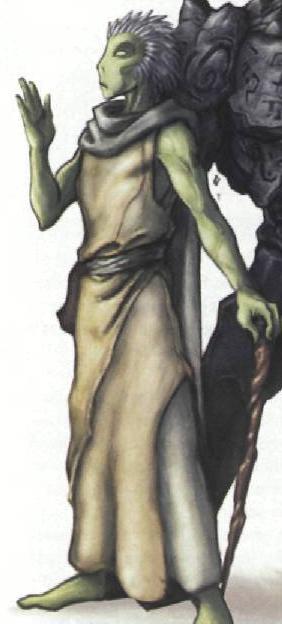
The elven nations claim a history longer than nearly all other civilized nations, but adu'jas were already ancient when elves were mere infants in the care of their young gods. When elves matured, adu'jas showed them the secrets of the natural world. Its magic and power became one with the elves. When the elves sank into civil war, adu'jas suffered the wrath of those who twisted adu'jan lore, rendering it corrupt and unnatural.
Adu'jas retreated from the world, taking ancient mysteries deep into untamed woodlands across the world. The heart of their arts remain at the core of druidic philosophy, bardic wisdom, and the discipline of woodland rangers.
With the encroachment of human civilization and the decimation of the forests by goblinoids, adu'jas have emerged from their seclusion. Elven enclaves first reported their appearance, bringing a message of peace to the larger elven community. Adu'jas have chosen to ease into this new world under the aegis of their former students, the elves. They have returned to bring back the ancient woods, to save the last of their homes, and to assist humankind in becoming shepherds of wisdom.
Adu'jan society is virtually gone from the world. Its civilization has passed into antiquity, becoming little more recognizable than the natural world itself. Adu'jas organize themselves in small enclaves of fewer than a dozen, usually surrounding a great elder who serves more as spiritual guide than a true leader. Most elders resemble natural flora, immobile in the state of torpor that overtakes adu'jas of extreme age. Because adu'jas live almost twice as long as elves, an adu'jan elder is truly ancient.
Adu'jan elders sprout sapling adu'jas every few centuries, who eventually mature and become part of the small community that governs the woodlands in which they live. These saplings retain faint racial memories that guide them to maturity.
In recent times, adu'jas have been forced to mobilize their small numbers to protect themselves against encroaching humans, orcs, and other despoilers of the forest. They work first by scare tactics, then by sabotage, and finally through force. It pains adu'jas to resort to such methods, but their increasing desperation drives them to it.
Personality: Many of the youngest adu'jas are leaving their enclaves among their elven allies to go out into the world and search for signs of hope. Young adu'jas are accepting of all races. They nurture eternal hope in the balancing harmony of nature, and they seek to cross cultural boundaries to merge their ancient wisdom with the dynamic drive of the warm-blooded races.
Physical Description: Asexual and averaging 5-1/2 to 6-feet tall, adu'jas are humanoid in shape. Their androgynous facial features show a hint of a nasal bump with two small vertical slits that resemble nostrils. These are not nostrils at all, but pheromone exhausts, which expel various scents according to the adu'ja's mood. Adu'jan faces are ringed by soft, petal-like scales. These undulating petals are chromatophoric, changing in color and pattern to reflect moods. Their skin ranges from yellowish green through emerald to deep brown, but this color changes according to season and mood. Their large, almond eyes are deep gold to rich brown.
Adu'jas are typically weak and thin-limbed, yet they carry themselves with grace and dignity.
Relations: Adu'jas have a belief in preserving the natural world, which they call "Shan Jar" ("The Way of the Root"). Shan Jar puts forth that all things have their necessary place and stem from the same source. Nature is. To adu'jas, this means that all things in nature must be balanced. Adu'jas have realized that during their long absence, they failed to tend their duties, and imbalance has become the way of things. Civilization is no longer at harmony with nature.
Most human and dwarven societies are leery of adu'jas. Rural communities seem more receptive to their presence and have been known to adopt adu'jas, especially if there are druidic orders nearby. Most civilized people think of adu'jas as nature spirits, which adu'jas use to their advantage in winning their trust.
Young adu'jas who have learned to live among the goodly races (such as humans, elves, gnomes, and halflings) have been known to "go native." They become accustomed to wearing local garb and the use of simple accoutrements. As their understanding of their neighbors grows, they apply their holistic philosophy to everyday life in the hope that their friends will adopt the adu'jas way by example.
Adu'jas are very naive of the world at large. Their philosophy is of such sublime scope that they often cannot see the day-to-day world beneath it - or rather, they don't care to acknowledge it. However, they are extremely expressive creatures. Their chromatophoric petals and scent glands make them extremely effective communicators. They have great inner strength and strong personalities, although they might not show it all the time.
Alignment: Young adu'jas are usually neutral good in alignment. They believe in proactively establishing harmony. As they age, their understanding of Shan Jar deepens, and they tend to drift toward neutral alignment.
Religion: Adu'jas typically revere Obad-Hai and elemental spirits. Pelor is also popular among young adu'jas, as are rain and earth deities.
Language: Adu'jas have adopted the Elven alphabet in order to write their own slow, thrumming language. They rarely ever write on plant-based mediums, preferring to put their thoughts down on parchment. In addition to their own tongue, adu'jas speak Elven and Sylvan, and they often learn Common, Gnome, and Halfling, as these are often the languages of their friends and allies.
Names: Because they are androgynous, adu'jas share similar names. Adu'jas often translate their names into Elven and Common. Common names include Oakskyreach, Deepearthroot, Windleafcatcher, Sunsbright, Forestheart. and Stoneroot. Occasionally, adu'jas adopt elven names.
Adventurers: Adu'jan adventurers are rare but active. They make friends readily with elves, gnomes and some humans. Most other races regard them with indifference at best and suspicion or fright at worst. The honest demeanors of adu'jas typically win over hesitant acquaintances.
ADU'JA RACIAL TRAITS
-
+2 Wisdom, +2 Charisma, -2 Strength: Adulas make good use of their beautiful petals and scent glands, making them appealing to other races. They are also perceptive of their world. However, their thin-limbed bodies are relatively weak.
-
Plant: As a creature of the plant type, an adu'ja is immune to all mind-affecting effects, poison, sleep effects, paralysis, polymorph, and stunning. They are not subject to critical hits. Adu'jas do not need to sleep. Adu'jan spellcasters still must rest for 8 hours to regain spells. They are immune to spells and effects that only affect humanoids, such as charm person. However, they can still be affected by spells such as charm monster and those that specifically affect plant creatures.
-
Medium: As Medium creatures, adu'jas have no special bonuses or penalties due to their size.
-
Adu'jan base land speed is 30 feet.
-
Low-Light Vision: An adu'ja can see twice as far as a human in starlight, moonlight, torchlight, and similar conditions of poor illumination. They retain the ability to distinguish color and detail under these conditions.
-
Adu'jas have the woodland stride ability, as a 2nd-level druid.
-
Photosynthesis: Adu'jas consume only one-quarter the rations of a human of similar size. In essence, they are omnivorous plants. They gain sustenance from eating animal or vegetable matter, usually in small quantities. This ability works only if they are allowed at least four hours of direct sunlight; otherwise, they must eat as much as a human. Adu'jas prefer vegetable matter over animal flesh, but many younger adu'jas have developed a taste for meat.
-
Photoregeneration: Adu'jas who are allowed to rest in sunlight with at least a gallon of water to consume heal twice their level in hit points per day. If active during this time they gain hit points back at the normal resting rate. In darkness, they regain hit points normally.
Adu'jas can regrow severed limbs (but not heads). It takes approximately 1 month to regrow a limb, during which time adu'jas can do nothing more than rest and perform light activity. Complete bed rest cuts this time in half.
-
+4 racial bonus on Diplomacy and Perform checks. Adu'jas express themselves well, with changing patterns of color on their facial petals and skin as well as odors from their scent glands.
-
-4 penalty on all Bluff and Sense Motive checks. Due to their inherently trusting nature, adu'jas find it difficult to tell and discern lies.
-
+4 racial bonus on Survival checks. Adu'jas always consider Survival a class skill, as they have an innate link to the natural world.
-
Vulnerability to Fire: Adu'jas take half again as much (+50%) damage from fire.
-
Spell-Like Ability: 1/day - speak with plants. Caster level 1st.
-
Automatic Languages: Adu'ja, Elven, and Sylvan. Bonus Languages: Common, Draconic, Gnome, and Halfling. Adu'jas know the languages of their allies, and they often learn those of potential friends.
-
Favored Class: Druid. A multiclass adu'ja's druid class does not count when determining whether she takes an experience point penalty for multi-classing. Knowledge of the wild comes naturally to adu'jas.
-
Level Adjustment: +2. An adu'ja with one class level is treated as a 3rd-level character for purposes of awarding the character experience, for starting equipment, and for determining how many experience points the character needs to gain a new level.
GRUWAARS
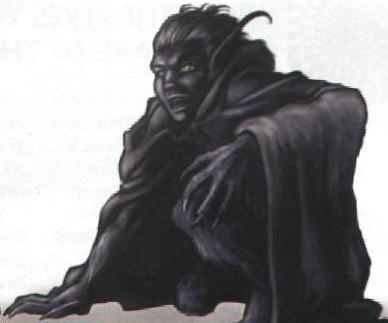
When the fey were united and the Seelie and Unseelie Courts had not yet been established, the gruwaars were there. The turn of ages and eventual sundering of the fey court heralded the gruwaar's ascent among the Unseelie as master manipulators and dangerous foes.
Legends speak of the gruwaars as allies to the children of Lolth. The gruwaars stood beside the dark elves in their rebellion and followed their tragic descent when the drow fell into the depths of the earth. Surface elf retribution on those gruwaars who dared stay above ground all but eliminated the race outside of the Underdark. Those few who survived have been joined over the years by those who initially fled from elven fury. They maintain their reputation for foul deeds long past - and they revel in it.
Gruwaars are rare, even among the fey. Most sages know little of their history or their role in the history of other races. Plagues, assassinations, and catastrophes throughout the ages have seen influence from the gruwaars, for reasons known only to them.
Wild and mischievous even by fey standards, the gruwaars are extremely independent. Among other races, they often serve from the shadows as advisors or assassins for those causes that amuse them. Occasionally, a gruwaar will join with an adventuring party for seemingly noble reasons, only to later reveal a darker ulterior motive.
Gruwaars are drawn to political intrigue, but although they are amused by power and those who believe they wield it, gruwaars are not necessarily interested in wielding political and social influence themselves. They are fascinated by the motives and results that impassion those who seek and bear power. Above all else, they are intrigued by the chaos of raw, naked force. Where there is political strife, where there are clashing ideologies, where the will of rebellion threatens to upset the balance of power - the gruwaars are there.
Personality: Gruwaars are voyeuristic by nature. They love to see individuals act in dynamic ways, especially when they themselves set the stage. The gruwaars love drama. Tragic or grand, it matters not to the gruwaar. They just like to watch the chaos unfold.
Philosophically, gruwaars are completely individualistic in their approach to life. Their only common quality is a singular disdain for any authority that they do not influence in some fashion. As such, their motives are known only to themselves.
Physical Description: Averaging 3 to 4 feet tall, the gruwaars do not possess the usual beauty of their fey kin. Instead, they are wiry, muscular creatures with monkeylike bodies. Gruwaar faces resemble a cross between a goblin and a cat, with large, round eyes the color of hot steel, a large brow, and a maw filled with hideous canines. Their ears are long, pointed, and jut out from their heads, although they can sweep them back when they choose.
Gruwaars are covered with a fine, black fur. They have long arms with extra joints and hands ending in tiny, razor-sharp claws. Their short thighs and long forelegs cause them to appear as if they are perpetually crouched.
When among civilized folk, the gruwaars wear loose-fitting hoods and cloaks and often remain hidden as much as possible. When confronted, they lie and bluff their way out of direct conflict. Few gruwaars are ever backed into such corners, however, and those who are usually have no compunctions about using their claws to extract themselves from difficulties.
Relations: Among the fey, gruwaars are considered members of the Unseelie Court. They are accorded respect based on their heritage by those wise enough to recognize them for who they are. Among the Unseelie, however, the gruwaars are treated as dangerous miscreants at best. Some gruwaars are considered powerful players among the Unseelie, greatly respected by their peers and feared by others. Most gruwaars pay only the barest courtesy to the Unseelie Court.
Among other races, gruwaars prefer to remain hidden or disguised. They might pretend to be familiars to young wizards and sorcerers whose vanity exceeds their skill at conjuring demon familiars. At other times, they might work in concert with others in the shadows of society, where appearances take second place to skill. The gruwaar take an active approach in concealing their motives, since it is more entertaining to watch their dupes or pawns do things of their own volition. They take great pains to ensure that their foils learn as little as possible about their nature and identities. Gruwaars are unseen players in many games - unseen, effective, and dangerous.
Alignment: Most gruwaars are chaotic and evil by nature. Despite this, more than one gruwaar has sided with the forces of good in order to experiment on the ranks of a powerful evil regime. Some gruwaars specialize in tampering with certain types of ideological cultures, especially evil ones. The moral ambiguities of gruwaars are unmatched. They have saved innocents on given days only to have them sacrificed on others.
Religion: Gruwaars revere no deity in particular. Some of their more vile members have been known to fall sway to demon princes or devil lords, however, most gruwaars are too busy (some say egotistical) to formally worship another being.
Language: Gruwaars speak Common, Sylvan, and Undercommon. The first language a young gruwaar typically learns to speak is Undercommon. Older gruwaar use this ploy to insult the Unseelie Court and other fey. When they do speak Sylvan among other fey, gruwaars enjoy using thick (but fake) accents that make them difficult to understand.
Names: Male gruwaar names are short and usually monosyllabic, while female names usually have two syllables.
Male Names: Greeg, Hurg, Koll, Mok, Puzz, Zor.
Female Names: Hurga, Jeeta, Juuta, Mokka, Panee, Tagri, Zora.
Adventurers: Gruwaars love adventure. A gruwaar adventurer always has designs on why he's with a particular adventuring party. Perhaps he wants to join them to see what they do, with an eye down the road on a scheme to overthrow a kingdom he dislikes. Perhaps the party and he even have a mutual goal. The real trick is getting the party to accept a gruwaar into their midst. However, their wily, persuasive ways make them likeable despite their unusual appearance and often disgusting personal habits.
GRUWAAR RACIAL TRAITS
-
+2 Dexterity, +2 Charisma, -2 Strength, -2 Wisdom: Gruwaars are nimble, and possess a certain charm that most other races find appealing. However, they are relatively weak and somewhat inattentive.
-
Fey: As fey, gruwaars are immune to spells and effects that only affect humanoids, such as charm person. However, they can still be affected by spells such as charm monster.
-
Small: As Small creatures, gruwaars gain a +1 size bonus to Armor a Class, a +1 size bonus on attack rolls, and a +4 size bonus on Hide checks. They use smaller weapons than humans use, and their lifting and carrying limits are three-quarters of those of a Medium character.
-
Gruwaar base land speed is 20 feet. Gruwaars wearing light armor or no armor, with light or no encumbrance, and without items in their hands, may drop to all fours and move at a speed of 30 feet.
-
Darkvision: Gruwaars can see in the dark up to 60 feet. Darkvision is black and white only, but is otherwise like normal sight, and gruwaars can function in just fine with no light at all.
-
+2 racial bonus on Hide, Move Silently, and Sleight of Hand checks. All Gruwaars are preternaturally stealthy.
-
Claws: Gruwaars are capable of making natural attacks with their sharp claws. A gruwaar has two claw attacks that deal 1d3 points of damage plus Strength modifier.
-
Spell-Like Abilities: 1/day - disguise self. Caster level 1st.
-
Automatic Languages: Common, Sylvan, and Undercommon. Bonus Languages: Abyssal, Dwarven, Elven, Gnome, and Terran. Gruwaars know the languages of their kin as well as those among whom they live, and they learn to speak the languages of their enemies and other underground denizens.
-
Favored Class: Rogue. A multiclass gruwaar's rogue class does not count when determining whether she takes an experience point penalty for multiclassing. Sneaking and trickery comes easily to gruwaars. Many are on the cutting edge of larcenous ingenuity.
GOLMOIDS
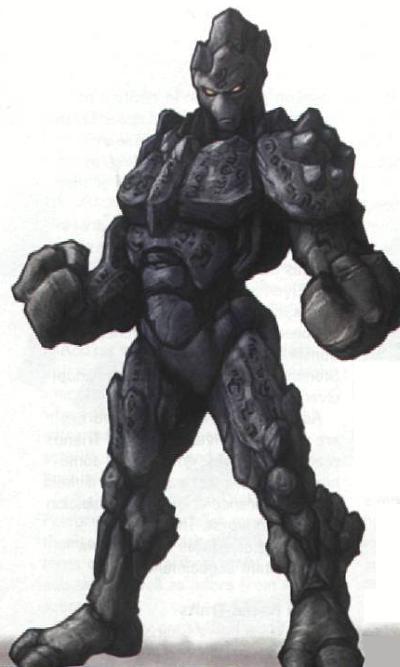
Originally crafted by gnomes to work as teamsters, haulers, and heavy lifters, golmoids labored for millennia as mindless constructs. Over the years, families that owned golmoids began to ascribe living qualities to their construct laborers, giving them gnome names and ascribing gnome traits to their actions.
A thousand years ago, at the behest of his daughters, a gnome wizard granted his family's golmoid a rudimentary form of intelligence. Soon thereafter, gnome wizards began competing with one another in escalating attempts to grant their golmoids a greater level of intelligence than that of their neighbor's. Eventually, all golmolds received sentience, and began to interact with one another as all thinking beings do.
The original sentient golmoid, who had his intelligence augmented several times by his family's wizards, asked for and received his freedom. He quickly spread the word to other golmoids of his liberation, and within a week the gnomes found themselves with a terrible dilemma: to retain a sentient race as slaves or to let their precious construct laborers have their desired freedom. To their credit, it took only a day for the gnomes to decide to release the golmoids.
As a gift to the creations of his children, Garl Glittergold breathed true life into the clay, stone, and bronze bodies of golmoids, making them humanoids. In thanks for their newfound gifts, the golmoids formed a binding treaty of mutual aid with the gnomes. In the millennium since, the golmoids have struggled through hard times and celebrated periods of plenty, and although they solemnly remember their vow of aid to the gnomes, golmoids work as no being's slaves.
Personality: Golmoids tend to be quiet, which makes nongnomes think of them as dour or aloof. In truth, the unexpressiveness of their bodies simply masks the joy of life burning within them. They seldom seem at ease among any race other than gnomes and therefore come across as cold and hard to read to those new to them. Yet like all beings, what stirs beneath their skins distinguishes their individual personalities. The golmoids are as dynamic in their personal inclinations as members of their patron race, and while they cannot smile, their laughter is thunderous.
Most golmoids prefer and enjoy a simple agrarian life. They need little and ask for less. A history of servitude reminds the golmoids that they neither wish to work for others nor have others work for them. As such, every golmoid strives for self-sufficiency, but whether he gains it or not is another question. Golmoids prefer to deal with others in a frank, forthright manner, leaving little room for complex negotiations. Their merchants are notoriously inflexible, demanding to be paid based on the merits of their work without haggling.
When in the company of gnomes, however, the playfulness of their patron race rises to the surface, and it is then that a golmoid might show the passionate love of life they all possess.
Physical Appearance: Adult males appear to be plain-featured, muscular men towering more than 7 feet tall, with oversized shoulders and hands sheathed in stonelike skin. Their faces are plain and smooth-featured, accented by burning red eyes the color of hot magma. Skin color ranges from sandy tan to black.
Females are the same height as males, but are slightly less uniform in overall appearance. They also have smooth-featured faces like mannequins, and the trademark burning red eyes. Females rend to be thinner-limbed and bear a more natural appearance. Their skin color ranges from light tan to ruddy brown.
All golmoids have spatulate feet with only one separation for a large toe. Golmoids fingers are thick and rocky, the last three fingers melding into one wide digit.
Because of the similarities in appearance between golmoids, golmoid sculptors delicately carve the skin of their fellow golmoids to reflect deeds accomplished, much like tattooing among soft-skinned races. Golmoid warriors often have their skin carved into the form of armor. For these reasons, golmoids hold an almost religious reverence for their skin carvers.
Relations: Golmoids usually live in small, isolated communities. They are guarded with strangers but quite open once the potential for threat is dismissed. Even the smallest golmoid communities often build large stonework citadels, usually located in mountainous or hilly country. As might be expected, gnomes are always welcome within golmoid communities, and indeed the races occasionally seek out one another to settle in close proximity. In addition, dwarven enclaves are frequent traders with the golmoids, and the two races get along well. Golmoids have a soft spot in their hearts for halflings, seeing them as distant and agreeable cousins of gnomes. Somewhat gnome-like, golmoids always try to get along with elves and humans, but they find the complaints and angst of half-elves and half-orcs tiresome.
Alignment: Golmoids tend to be mindful of the general welfare of all involved in any matter, but are not usually inclined to interfere with another's business. As a result, every golmoid has a touch of neutrality in his alignment, with the vast majority remaining neutral in as many situations as possible. Neutral good and lawful neutral make up the largest minorities.
Religion: Golmoids worship Garl Glittergold or follow philosophies that venerate hard work and just reward.
Languages: Golmoids speak Common and Gnome. Many Golmoids learn to speak Dwarven, Halfling, and Terran as well.
Names: The names of golmoid males derive from their ancestry. Surnames usually have a stone context. Females only take a surname at some important occasion, such as marriage or the completion of an important quest.
Male Names: Argaren Slatefist, Jhondal Jasperteeth, Vaalus Granitespur.
Female Names: Aratta, Ghutta, Helosia, Komara, Taaza, Wara.
Adventurers: Golmoids make fine adventuring companions. They are true to their word, with an inspiring willingness and drive to succeed. Golmoids rarely surrender, and they are gifted and methodical porters and teamsters.
Golmoids often leave their communities to wander the greater world when they become adults. Golmoid travelers usually wear hooded cloaks and robes. Their weight can be inhibiting for horseback travel, but their tireless endurance allows them to keep up with even the hardiest horse.
GOLMOID RACIAL TRAITS
-
+2 Strength, +2 Constitution, -4 Dexterity, -2 Intelligence: Golmoids are strong and durable, but their great bodies are not agile, and their gift of intelligence was not perfect.
-
Medium: As Medium creatures, golmoids have no special bonuses or penalties due to their size.
-
Golmoid base land speed is 30 feet. However, golmoids can move at this speed even when wearing medium or heavy armor, or when carrying a medium or heavy load (unlike other creatures, whose speed is reduced in such situations).
-
Natural Armor: Their stone-like skin grants golmoids a +2 natural armor bonus.
-
+2 racial bonus to all Craft checks. Golmoids are gifted craftsmen, and some speculate that their created forms give them an instinctive knowledge of manufacturing.
-
+4 racial saving throw bonus against enchantment spells and effects. Golmoids have some residual resistances of constructs.
-
Bonus Feat: Golmoids gain Endurance as a bonus feat at 1st level.
-
Automatic Language: Common and Gnome. Bonus Languages: Dwarven, Halfling, and Terran. Golmoids learn the language of their patron race as well as those they see as allies to gnomes.
-
Favored Class: Fighter. A multiclass golmoid's fighter class does not count when determining whether he takes an experience point penalty for multiclassing. Golmoids are powerful and competent combatants when roused to anger.
-
Level Adjustment: +1. A golmoid with one class level is treated as a 2nd-level character for purposes of awarding the character experience, for starting equipment, and for determining how many experience points the character needs to gain a new level.
T'KELS
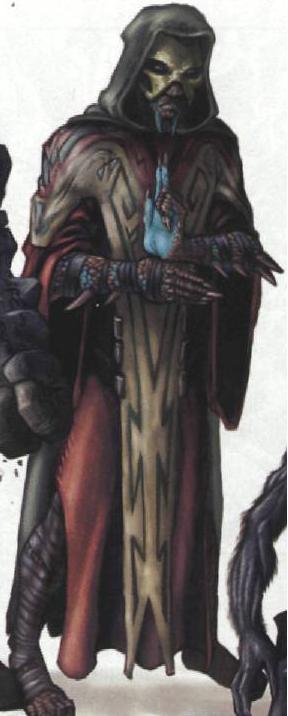
T'kels have long been seen as savages, monsters that plagued wilderness communities for countless years. When times grew tough, t'kels raided nearby villages and towns in search of food. This savagery gave them a fierce reputation they struggle to overcome to this day. However, over the last century, t'kels have gradually shifted from a hunter-gatherer society to an agricultural one. They are blooming into a diverse society based on the philosophies of their current leader.
T'kels follow a philosopher-king named Zuras, who led his people from what he calls "the serpent's coils." Many years ago, Zuras claimed to have been hunting an elven cadre of rangers when a "nature spirit" stopped him. This adu'ja sat Zuras down to tell him of the error of t'kel ways. They sat for fourteen days, and the adu'ja revealed to Zuras the secrets of natural harmony. Zuras took these secrets back to his people.
Now the t'kels are rejecting their barbaric ways in order to live as one with nature. This has not tamed t'kel ferocity though, only channeled it into less destructive endeavors. They live in teeming, shallow tunnels below the verdant forests they now tend. They farm a variety of plants that they use for their medicines and produce rare spices and incense that they trade to the humans who have learned to trust them.
Many t'kels practice meditation, channeling their aggressive natures into the martial arts. Within the last century, human monks have lived among the t'kels to learn their way. T'kel monks form a top-level caste among their society, servings as teachers and advisors.
One of the few traditions that has survived the t'kels' transformation from hunters and plunderers into monks and ascetics is the wearing of masks. T'kel masks represent many things in their society, and the shape, style, and color of a mask identifies the wearer's status and occupation to every other t'kel who sees it. Other races, long impressed by the beauty of such masks, have tried and failed to learn their secrets. Living t'kels never remove their masks where non-t'kels might see their faces, as they feel their faces are a representation of their souls, and their most secret desires.
Personality: The t'kels exhibit a distinctly reptilian attitude. Their sense of humor is subtle and difficult to draw out. They loathe displays of waste or wanton destruction and seek to pacify (through lethal force, if necessary) anything that they feel threatens the natural order. They are quite taken with the concept of honor, and despite their former reputations, they are unwilling to break oaths.
T'kels are not particularly intelligent, but their cunning usually surprises those who travel with them. While they are far more civilized than they once were, their savagery still exists. In battle, t'kels can give in to their feral sides in a way that is terrible to behold. Among t'kels, it is considered shameful to act in such a way. A t'kel who has succumbed to such behavior will often leave t'kel society voluntarily, in order to avoid injuring anyone else.
Physical Description: T'kels dress in decorative robes or armor, with elaborate facemasks of beaten metal highlighted with brightly painted colors. The rarer the metal, the higher in rank its wearer. Different colors and patterns of paint signify a t'kel's occupation.
Beneath their masks and robes, their skin is covered with tan to chocolate-colored beaded scales. They have belly and back patterns in brilliant colors ranging from aquamarine and indigo to burnt umber and saffron, and they have more pronounced, pointed scales on their brows and jaws. They do not have teeth, but rather they have white bony ridges that look like a line of teeth without seperation.
T'kel hands and feet are clawed. Both females and males often paint their claws bright colors. T'kel height difference between genders is quite noticeable, with the smaller males standing 5 to 5-1/2 feet tall, and females often reaching well over 7 feet tall. Despite their smaller size, male t'kels have dense muscles, weighing as much as their female counterparts, and are just as strong.
Relations: While races who do not live near t'kels might speak of them as little better than orcs, those who call them neighbors couldn't speak more highly of them. Most t'kels today are more interested in discussing farming techniques or weather trends than in spoiling for a fight. However, if someone were to start a fight with a t'kel, the t'kel would oblige.
T'kels enjoy living as part of their environment. They now help the wilder lands thrive, where once they pillaged the land for anything that could sustain them. T'kels are quickly building the reputation of their culture, and have proven remarkably adept at common crafts. Their artwork fetches good prices in large cities, as well as the attention of serious collectors. In addition, they are excellent weavers, producing a material called sh'ematta that has brilliant colors and a soft texture.
Alignment: T'kels usually have some amount of neutrality in their alignment. Most t'kels are lawful and ardent practitioners of their philosophy; otherwise, they lean toward neutral good. Few t'kels are ever chaotic.
Religion: Since the coming of Zuras, t'kels practice nature worship. They have become one of the true success stories of the adu'jas, with whom Zuras communed for those two weeks.
Language: T'kels speak Draconic as their natural tongue. As they have become more civilized, they have adapted the Draconic script to write out their philosophies and beliefs. Many have learned to speak and read Common, Elven, and Sylvan, so they may interact peacefully with their neighbors. They speak with a gentle hiss other races find soothing and relaxing, and many have been pressed into giving impromptu speeches just for the way they speak.
Names: T'kel male names are always two or three syllables, and female names are always three or four.
Male Names: Adunar, Banwei, Golos, Mur'rkantos, Yallikbei, Zuras.
Female Names: Aa'razmarum, Atanari, Ecu'mazin, Gengliet, Ma'arkaset.
Adventurers: T'kels are able adventurers. They are inquisitive about outside cultures and seek the wisdom those cultures have to offer. As their new culture continues to grow, it takes on small aspects of others that adventuring t'kels have encountered and subsequently written about. They are in a strange place between the worlds of their savage ancestry and their new, more civilized culture. As such, t'kels make superb monks and fighters and are well suited to being rangers. T'kels take great pride in their own culture, and few t'kels are open-minded enough to take jibes about their base beginnings.
T'KEL RACIAL TRAITS
-
+2 Dexterity, -2 Intelligence: T'kels are quick and graceful, but they cannot reason as well as humans.
-
Medium: As Medium creatures, t'kels have no special bonuses or penalties due to their size.
-
Monstrous Humanoid: T'kels are monstrous humanoids, and are therefore immune to spells that only affect humanoids, such as charm person.
-
T'kel base land speed is 30 feet. T'kels also possess a swim speed of 20 feet. Due to having a swim speed, a t'kel has a +8 racial bonus on any Swim check to perform some special action or avoid a hazard. It can always choose to take 10 on a Swim check, even if distracted or endangered. It can use the run action while swimming, provided it swims in a straight line.
-
Darkvision: T'kels can see in the dark up to 60 feet. Darkvision is black and white only, but is otherwise like normal sight, and t'kels can function just fine with no light at all.
-
Claws: T'kels are capable of making natural attacks with their sharp claws. A t'kel has two claw attacks that deal 1d4 points of damage plus Strength modifier.
-
Automatic Language: Draconic. Bonus Languages: Common, Elven, and Sylvan.
-
Favored Class: Monk. A multiclass t'kel monk class doesn't count when determining whether he takes an experience point penalty for multiclassing. Despite the rapid and recent growth of their culture, t'kels continue to possess a warrior mentality.
ATHASIAN AARAKOCRAS
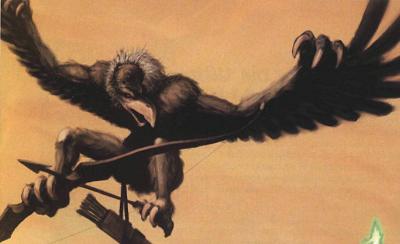
The winged birdmen known as aarakocras are a rare sight in the settled parts of Athas. Only aarakocra travelers, traders, diplomats, and exiles spend much time among the city-states.
Personality: A typical aarakocra is known for his need for freedom, both in the literal and figurative sense. Most aarakocras are quite claustrophobic and intensely uncomfortable when restrained in any way; they also dislike long-term obligations to others, and many become depressed or suicidal when pressed into military service or slavery.
Physical Description: An aarakocra's arms form the leading edge of his wings, which also attach to his torso at the hips. About midway along each wing is a clawed hand with fine motor ability rivaling that of a human. When flying, aarakocras can manipulate items in their foot-talons as well as they could if they were holding them in their hands. An aarakocra's plumage varies from white to bluish-gray.
Relations: Aarakocras tend to get along well with most other races. Because they come from isolated communities far north of the city-states, they are sometimes surprised by the quirks of other races.
Alignment: Aarakocra society is loosely knit and seminomadic, so aarakocras have a tendency to be chaotic.
Aarakocra Lands: The vast majority of aarakocras come from a region hundreds of miles north of the Tablelands called Winter Nest. Some few are born in aarakocra trading outposts or diplomatic enclaves in the city-states.
Religion: Some aarakocras rely on clerics of Air for religious guidance, while others heed the teachings of the few druids in their midst. Those aarakocras confronted with the theocracies of the city-states pay only lip service to the notion of worshiping the dragon-kings.
Language: Aarakocras speak their own language, Aarakocra. Most aarakocra in Winter Nest and elsewhere have enough contact with merchants from the city-states that they speak Common as well. An aarakocra's beak has an easier time with the clicking sounds of the Thri-Kreen language than humanoid mouths.
Names: Aarakocras tend to have a single multisyllabic name with lots of vowels and soft consonants in them.
Adventurers: A burning desire to explore and a natural inquisitiveness serve aarakocra adventurers well, although few aarakocras stray from Winter Nest. Those who leave find the city-states fascinating, if puzzling and sometimes dangerous.
ATHASIAN AARAKOCRA RACIAL TRAITS
-
+4 Dexterity, -2 Strength. Lightweight but fast, aarakocras are built for speed over strength.
-
Medium: As Medium creatures, aarakocras have no special bonuses or penalties due to their size.
-
Monstrous Humanoid: Because they aren't humanoids, aarakocras are immune to spells such as charm person and hold person.
-
Aarakocras have a base land speed of 20 feet. Their fly speed is 90 feet, with average maneuverability.
-
+1 natural armor.
-
Natural attacks: A flying aarakocra can attack with two talons, dealing 1d4 points of damage each, or he can use a weapon in his talons. An aarakocra on the ground can wield weapons in his wing-claws at his base attack bonus and attack with his bite as a secondary attack, dealing 1d3 points of damage.
-
Weapon Proficiency: Aarakocras are proficient with the javelin. Aarakocras learn to use these throwing weapons at an early age.
-
+2 racial bonus on Craft (any one), Knowledge (nature), Listen, and Spot checks. Aarakocras spend a great deal of their time hunting, building nests, and making tools.
-
Claustrophobic: Aarakocras suffer a -4 penalty on all attack rolls and skill checks when in an enclosed area.
-
Inborn Power: Aarakocras gain 3 extra power points at 1st level, regardless of whether they choose a psionic class or not. They can use the power points provided to manifest elfsight. If you take levels in a class that offers a repertoire of psionic powers, simply add the 3 power points to your power point total, and add your inborn power to your list of powers known. Aarakocras use their inborn power at a manifester level equal to their character levels. They use Charisma to set the save DC unless they have levels in a psionic class such as psion or psychic warrior that uses a different ability score to set the DC. In that case, they choose either Charisma or the psionic class's relevant ability score to set the save DC.
-
Automatic Languages: Aarakocra and Common. Bonus Languages: Auran. Halfling, and Thri-Kreen.
-
Favored Class: Ranger.
-
Level Adjustment: +2.
ATHASIAN DWARVES
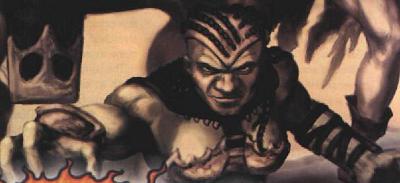
On Athas, dwarves aren't subterranean miners. They are a long-lived but slowly dying race known for their relentless focus on a single task to the exclusion of all others.
Personality: How a dwarf behaves depends greatly on his focus, a single task that dominates every aspect of his life until it's completed. Each dwarf has a focus that guides his actions during every waking moment. A focus is usually a specific goal, such as "dig a new irrigation ditch," "convince the merchants of House Stel to improve our trade terms," or "slay the gaj that's been terrorizing our outpost."
If you're roleplaying a dwarf, you should be able to describe your current focus in a single sentence without a moment's hesitation. You can change your focus anytime you like simply by telling the DM, although most dwarves don't change their focus until the task is completed or it's apparent that it never will be completed. Think carefully about choosing a focus that'll make your goals diverge from those of the other PCs. Your focus should make for interesting roleplaying, but it shouldn't form a wedge between you and the other players.
Physical Description: Dwarves tend to be shorter and stockier than humans, but their eye, skin and hair color falls into the same ranges as humans. Adult male dwarves all have beards, although most keep them closely trimmed.
Relations: Dwarves categorize people according to their relation to their focuses, not by race, gender, or other characteristics. If someone can aid a dwarf in the resolution of his focus, he'll be at least marginally polite and helpful. However, standing between a dwarf and his focus makes the person an enemy, and not relating to his focus at all makes the being irrelevant.
Alignment: A dwarfs respect for those who fulfill their stated objectives gives most a lawful outlook.
Dwarf Lands: Dwarves are found intermingled with the human populations of the city-states; dwarves do not have communities to call their own anymore. The towns of Ledopolus are an ancestral home of the dwarves, so the dwarven population there is larger than it would be otherwise. In most city-states, dwarves congregate in certain neighborhoods to the exclusion of others.
Religion: Most dwarves worship one of the dragon-kings, although many heed the words of elemental clerics, especially those of earth and fire.
Language: Dwarves have overwhelmingly adopted the language of the humans they live with. They only use their ancestral language of Dwarven among each other and on ceremonial occasions.
Names: Dwarves once had an elaborate naming structure that detailed a particular dwarf's heritage by describing his ancestors. The naming system was unwieldy, however, so it has fallen into disuse, and dwarves have adopted human naming conventions.
Adventurers: Dwarven adventurers are driven by a focus that puts them in harm's way, such as "map the Jagged Cliffs region," "overthrow the dragon-king," or "make enough money to buy the freedom of my family."
ATHASIAN DWARF RACIAL TRAITS
Athasian dwarves have all the dwarven racial traits, except as follows:
-
+4 Constitution, +2 Wisdom, -2 Charisma: Dwarves are stout and tough but tend to be gruff and reserved.
-
Dwarves lose stonecunning, weapon familiarity, their +2 racial bonus on saving throws against poison, their +1 racial bonus on attack rolls against orcs, their +4 dodge bonus to Armor Class against giants, their +2 racial bonus on Appraise checks, and their +2 racial bonus on Craft checks.
-
Inborn Power: Athasian dwarves gain 3 extra power points at 1st level, regardless of whether they choose a psionic class or not. They can use the power points provided to manifest vigor. If you take levels in a class that offers a repertoire of psionic powers, simply add the 3 power points to your power point total, and add your inborn power to your list of powers known. Dwarves use their inborn power at a manifester level equal to their character levels. They use Charisma to set the save DC unless they have levels in a psionic class such as psion or psychic warrior that uses a different ability score to set the DC. In that case, they choose either Charisma or the psionic class's relevant ability score to set the save DC.
-
+2 racial bonus on saving throws against psionic powers, spells, and spell-like effects: Dwarves have an innate resistance to magic spells and psionic powers.
-
Focus: Dwarves are notoriously single-minded, focusing on one task to the exclusion of others. This focus is something that can be simply stated, such as "overthrow the government," "get the caravan to Urik," or "find the twelve ruby chrysalises." Dwarves gain a +4 racial bonus on Will saves against charm or compulsion effects that would change, delay, or distract from their focus.
-
Dwarven Blood: Dwarves are resistant to venoms and toxins, getting a +4 racial bonus on Fortitude saving throws against poison.
-
Automatic Languages: Dwarven and Common. Bonus Languages: Terran.
-
Favored Class: Cleric.
-
Level Adjustment: +1.
ATHASIAN ELANS
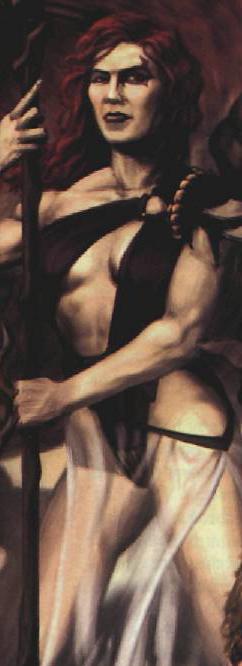
Originally created as a secret network of court agents by a powerful society of psions known as The Order, elans are not born; they are made. It is said that The Order erred when it created the first elans because it gave them too much free will. Some elan enclaves still owe allegiance to The Order, although the group was factionalized and driven underground after a failed plot a century ago. Other elans have turned their backs on The Order and are determined to forge their own destinies in the harsh lands of Athas. The average Athasian has never heard of an elan, but most noble families, merchant houses, and high-ranking templars have learned of their existence within the last few years.
Elans all have one thing in common: previous lives as humans. A special elan council screens living humans from a pool of applicants who've volunteered to make the transition into elans. Those who pass muster undergo a secret psionic process in one of several hidden elan enclaves, where organic life transitions to psionically-energized animation. Newly created elans retain the basic memories and personalities of their previous lives, but they keep none of their class skills, powers or spells (if any), or previous class abilities. Elans are a secretive lot in this regard, and they do not publicly reveal their enclaves or places of making. If one is to become elan, he is usually selected. Thus, elans do not reproduce biologically, but rather psionically, through the transition life power. Even then, their "children" are usually fully-grown adult humans. Non-human elans are never created, and it could be that the transition life power simply doesn't work for any other creatures but those who were originally human.
Personality: Elans are nearly as adaptable, flexible, and ambitious as the humans from which they are made. Because their state of existence sometimes leads other races to think the worst of them, elans practice a certain restraint, especially in regards to their origin. Otherwise, their personalities vary widely.
Physical Description: Elans typically stand just under 6 feet tall and weigh about 180 pounds, with men sometimes taller and heavier than women, but not always. Because new elans are selected, those who choose currently favor elans with pale skin, reddish hair, and a youthful quality. However, the first elans vary in looks as widely as humans. Elans dress in the styles similar to humans, including the adoption of unusual hairstyles, fanciful clothes, tattoos, body piercing, and the like. Elans have unlimited lifespans - as long as they are not destroyed, their mental arts could conceivably continually energize and rebuild their bodies for over a thousand years. However, The Order only recently established the first elan enclaves, so no known elans are more than twenty-five years old (not counting their time as humans).
Elans do not sleep as members of other races do. Instead, an elan meditates in a deep trance for 4 hours a day. An elan resting in this fashion gains the same benefit that a human does from 8 hours of sleep. While in trance, an elan concentrates on suffusing his body with psionic energy, healing the hurts and random lacerations of the day, and restoring animation and resiliency to his tissues.
Relations: Elans mix well with members of other races, especially humans. It is probable that their relations would undergo a shift should their true nature become widely known, so one of the essential tenets of elan existence is secrecy.
Alignment: Elans tend toward no particular alignment, not even neutrality. The best and the worst are found among them.
Elan Lands: Wherever humans are found, there, too, are clans.
Religion: Some elans revere the dragon-queen Lalali-Puy because the city of Gulg has the oldest and largest elan enclave. Newer elan enclaves are less likely to serve a dragon-king or elemental power, as they feel that any grace or continued existence they might hope for will depend on their own efforts and continual mastery of inborn psionic talent.
Language: Elans speak Common. They typically learn other languages, including obscure ones, and they are fond of sprinkling their speech with words borrowed from other tongues: Pterran curses, Elven musical expressions, Thri-Kreen military phrases, and so on.
Names: Elan names vary greatly and often are simply the same as the human name they possessed before they crossed into their new existence. This is particularly true when an elan wishes to pick up his old life where he left off. Others view their second chance at existence as an opportunity to start anew and might pick completely new names.
On the other hand, titles are important to the elan, although they are used only among themselves. Freshly transitioned elans have the title of Newmade, those who have had at least a few years of animate "life" have the title Made, and those over two decades old have the title of Eternal. Those that belong to the group that chooses new elans have the title of Culler (although any elan who knows the power transition life might take this title, whether part of the Culler Council or not).
Adventurers: Elan adventurers are akin to humans in their daring and ambition. Because some effects that afflict other races leave elans unscathed, they sometimes seem extraordinarily brave to those who do not know the secret of their existence.
ATHASIAN ELAN RACIAL TRAITS
Athasian elans have all the elan racial traits, except as follows:
-
+2 Wisdom. The selection process that creates elans favors those who demonstrate keen perception and insight.
-
Automatic Language: Common. Bonus Languages: Any (other than secret languages, such as Druidic).
-
Favored Class: Psion.
-
Level Adjustment: +1.
ATHASIAN ELVES
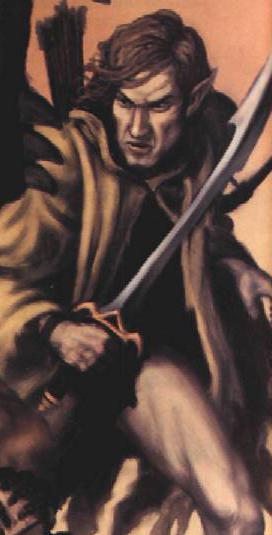
On Athas, elves have pointed ears and dwell in the wilderness, but comparisons to traditional fantasy elves end there. The elves of Dark Sun are clannish, nomadic desert-dwellers said to be as fast - and as mercurial - as the sirocco.
Elves are tireless wanderers, scouring the desert sands for whatever sustenance and riches they can find. They travel on foot in tribal groups, engaging in thieving and raiding, then disappear in a cloud of dust. Some tribes trade on a more-or-less regular basis with the city-states, but elves are known for their willingness to fleece customers not of their tribe.
Personality: An elf would rather live a short, happy life among friends than toil for centuries like a dwarf. Many take a perverse pride in the stereotype that labels them as untrustworthy thieves and bandits. Most are possessed by an incurable wanderlust, always moving on to see what lies beyond the next ridge - or what's in the poorly guarded caravan approaching from the west.
Physical Description: Elves are tall and lean beyond what would be possible for humans, but their slim frames hide a deceptive, wiry strength. Both males and females wear their hair long. Facial hair never grows on their pale skin. They favor voluminous robes that protect them from the wind and sand.
Relations: It is said that the only thing harder than finding an elf you can trust is finding an elf who trusts you. Elves either ignore or hold in contempt those not of their tribe, especially nonelves. An elf living among other races carefully tests the friendship of would-be allies before letting his guard down.
Alignment: Elves tend strongly toward chaotic alignments. Whether elves are good or evil depends on what's standing between them and their next drink of water.
Elven Lands: Some elven tribes have taken up residence in the city-states - usually in their own ghetto - but most roam the sandy wastes, coming into the cities only to trade. Many tribes of elven bandits congregate along major trade routes where they can pick off heavily laden caravans.
Religion: Few elves serve the dragon-kings - or anyone else for that matter. Many of the larger tribes have druids that provide a measure of spiritual guidance, and clerics of fire and earth aren't unheard of either.
Language: Elven is the elves' native tongue, a vowel-heavy language with a singsong quality. Most elves speak at least a smattering of Common as well, whether to demand valuables from bandit victims or strike a better deal in a city-state's bazaar.
Names: Elves take a simple name in their own language, and among the tribe they'll append a descriptive term, such as "Vilyaa the Tall," if a particularly common name is causing confusion. Elves separated from their tribe often take the tribe's name as a de facto last name. Tribe names include Night Runners, Silt Stalkers, Silver Hands, Sky Singers, Water Hunters, and Wind Dancers. Many elven names have doubled vowels, indicating that the vowel sound is stretched out slightly.
Adventurers: An elf's wanderings often develop into adventures whether he likes it or not. Some elves can't resist the temptation to fleece locals as they travel, while others find themselves the target of prejudiced harassment.
ATHASIAN ELF RACIAL TRAITS
Athasian elves have all the elven racial traits, except as follows:
-
+4 Dexterity, -2 Constitution: Elves are graceful but frail. An elf's grace makes her naturally better at stealth and archery.
-
Elves lose their +2 racial bonus against enchantment.
-
Elf base land speed is 40 feet. At 10th level, it increases to 50 feet.
-
Elf-Running: Athasian elves gain Endurance as a bonus feat, for they are accomplished long-distance runners.
-
Inborn Power: Athasian elves gain 3 extra power points at 1st level, regardless of whether they choose a psionic class or not. They can use the power points provided to manifest their conceal thoughts power. If you take levels in a class that offers a repertoire of psionic powers, simply add the 3 power points to your power point total, and add your inborn power to your list of powers known. Elves use their inborn power at a manifester level equal to their character levels. They use Charisma to set the save DC unless they have levels in a psionic class such as psion or psychic warrior that uses a different ability score to set the DC. In that case, they choose either Charisma or the psionic class's relevant ability score to set the save DC.
-
Weapon Proficiency: Elves receive the Martial Weapon Proficiency feats for the falchion, rapier, scimitar, longbow (including composite longbow), and shortbow (including composite shortbow) as bonus feats. Elves esteem the arts of swordplay and archery, so all elves are familiar with these weapons.
-
+2 racial bonus on Listen, Search, and Spot checks. At 5th level, these racial bonuses increase to +4, and at 15th level these racial bonuses increase to +6.
-
Elven Discernment: Elves are highly attuned to their environment, and they have an instinctive sense that detects when things are out of place. Elves gain a +2 bonus on saves against illusion spells and effects.
-
Automatic Languages: Elven and Common. Bonus Languages: Gith and Pterran.
-
Favored Class: Rogue.
-
Level Adjustment: +1.
ATHASIAN HALF-ELVES
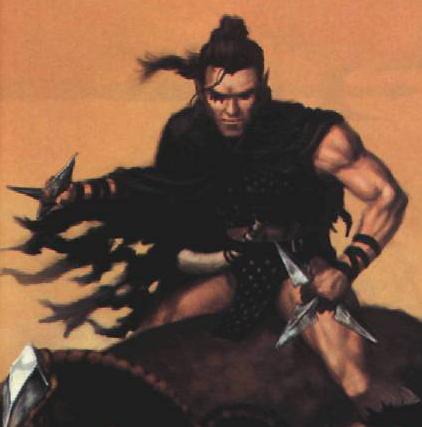
The half-elves of Athas have no true home: They are regarded as outsiders in both the human-dominated city-states and the elven tribes of the wilderness. Unlike their parents, half-elves have no culture or community to call their own, but the flip side to being an outsider is being able to come and go as you please. Just to get through the day in a world that regards them as halfbreed mongrels, half-elves have become adept socially, using keen perception and a diplomatic demeanor to deflect prejudice.
Personality: Most half-elves grew up as orphans or in broken homes, and most live uneasy lives in human or elven communities that don't truly accept them. Thus, a half-elf tends to be very loyal when he makes friends.
Physical Description: Half-elves look like thin humans with slightly pointed ears.
Relations: Half-elves generally get along well with most other races, especially muls and half-giants, their fellow crossbreeds. They often grow frustrated with human and elven prejudice.
Alignment: Half-elves have no affinity for a particular alignment.
Half-Elven Lands: Because they have a hard time keeping up with elven tribes in the wilderness, most half-elves live in the human city-states. They are too widely scattered to form their own communities, instead living as best they can within human society.
Religion: There are more half-elves than one might expect among the ranks of the templars, because a regimented life spent in dragon-king worship avoids many of the day-to-day difficulties of being a half-elf. Those half-elves who embrace their outcast nature often become elemental clerics, because fire, wind, water, and earth regard half-elves for who they are, not for who their parents were.
Language: Half-elves speak Common. Those with connections to the elven tribe of a parent learn Elven as well.
Names: Half-elves adopt the naming conventions of whatever society they live in.
Adventurers: Almost by definition, half-elves have to make their own way in the world, without a family or community to help them. Thus, the adventurer's life appeals to many.
ATHASIAN HALF-ELF RACIAL TRAITS
Athasian half-elves have all the half-elven racial traits, except as follows:
-
+2 Dexterity. Half-elves gain some of the agility of their elven parents.
-
Half-elves lose their +2 bonus against enchantment effects.
-
Immunity to sleep effects.
-
Inborn Power: Athasian half-elves gain 3 extra power points at 1st level, regardless of whether they choose a psionic class or not. They can use the power points provided to manifest their psionic charm power. If you take levels in a class that offers a repertoire of psionic powers, simply add the 3 power points to your power point total, and add your inborn power to your list of powers known. Half-elves use their inborn powers at a manifester level equal to their character levels. They use Charisma to set the save DC unless they have levels in a psionic class such as psion or psychic warrior that uses a different ability score to set the DC. In that case, they choose either Charisma or the psionic class's relevant ability score to set the save DC.
At 5th level, half-elves gain an additional 3 psionic power points and the detect hostile intent power. At 10th level, half-elves gain an additional 5 psionic power points and the danger sense power. At 15th level, half-elves gain an additional 7 psionic power points and the aura sight power. As with other inborn powers, if the half-elf character has psionic classes that provide knowledge of higher-level powers, simply combine the power points and inborn powers known with those attained from the class.
-
+2 racial saving throw bonus against illusion spells or effects, due to the discernment that is part of their elven heritage.
-
Automatic Languages: Common. Bonus Languages: Any (other than secret languages, such as Druidic).
-
Favored Class: Any.
-
Level Adjustment: +1.
HALF-GIANTS
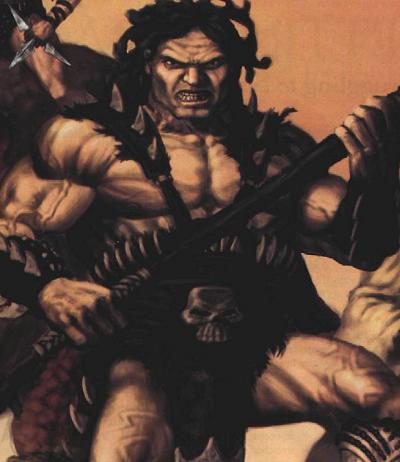
Half-giants were force-bred into existence by the cruel dragon-kings. Intended as a force of gigantic warriors and laborers, half-giants are crosses between humans and giants. With the creation of their race came also the inception of strife, as with any people kept in bondage. Some half-giants found that a relic of their forced breeding had engendered within them a spark of secret power. So it is that some half-giants flee their circumstances and seek new lands where they are free to discover their own destinies.
Personality: For the most part, half-giants retain human sensibilities. They are curious, interested in cooperation and communication, and tend to be kind (of course, there are exceptions). Because many half-giants are refugees from their former days of bondage, where they could pass down few traditions, they are quick to pick up the local tastes, morals, customs, and habits of the area in which they settle down.
Physical Description: Half-giants typically stand from 7 to 8 feet tall and weigh from 250 to 400 pounds, with men noticeably taller and heavier than women. Most half-giants have tightly braided black hair with deep coppery complexions. Half-giants often effect grandiose dress when they can afford to do so, sporting fanciful or intimidating clothing. Half-giants have longer lifespans than humans, achieving adulthood at about age 20 and usually living a little over a century.
Relations: Most other humanoids are put off by half-giants, due to their abnormally large size. However, assuming introductions can be made without violence, many find half-giants of good alignments to be outgoing, kind creatures.
Alignment: Half-giants have a slight tendency toward good alignments, but as always, there are bad apples whose hearts have been twisted by slavery.
Half-Giant Lands: Enslaved half-giants live in the human cities, where most are the property of templars. Those who've escaped or were born free tend to live in settlements in the deepest parts of hot deserts.
Religion: Freed half-giants, as a race, have a particular disdain for religion, sometimes going out of their way to speak badly of a dragon-king. It's not that they don't believe; it's that they don't believe that a dragon-king has the best interests of its worshipers at heart. Half-giants still in bondage openly worship the dragon-king who rules them; some truly believe in their hearts while others just go through the motions.
Language: Half-giants speak Common, plus any languages their masters taught them or that they learned in the wild.
Names: Half-giants have a childhood name and a given name, usually given by friends or the community in which the half-giant grew up. Most half-giant names reflect some aspect of the desert that half-giants inhabit, although a few place names are sometimes thrown in.
Adventurers: Half-giants have wandered far to found their current desert settlements. For many, wanderlust is a way of life, and seeking after glory, fortune, or even a life of high adventure is something every half-giant can understand and accept. Most half-giants, however, are content to stay in their settlements and listen to the tales of far-away lands from those who've adventured there.
HALF-GIANT RACIAL TRAITS
Athasian half-giants have all the half-giant racial traits, except as follows:
-
Automatic Language: Common. Bonus Languages: Dwarven and Giant.
-
Favored Class: Barbarian.
-
Level Adjustment: +1.
ATHASIAN HALFLINGS
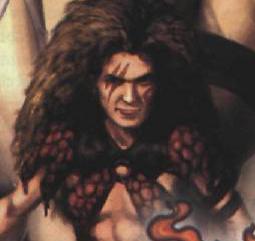
Feral creatures who live in the few forests remaining in the world of Dark Sun, the halflings of Athas are out of place in the city-states of the Tablelands. Yet, like how a wild creature held in a zoo can adapt to its surroundings, so too can a halfling find adventure in the cities, as well as the deserts, of Dark Sun.
Personality: Stories, song, and fine arts are of paramount importance to halflings, who have a rich oral history and collection of mythic tales. Halflings often feel sorry for creatures who have to scrabble madly for water and food, as they have little difficulty obtaining either in their forest homes. This attitude sometimes appears patronizing to others.
Physical Description: On Athas, many halflings decorate their skin with war-paint, tattoos, and piercings.
Relations: Halflings have a mixture of pity and curiosity about the people of the city-states, but they're socially aware enough to realize that they will always be a novelty to the larger races. After they've been among humans and other races for a while, most halflings overhear enough tales about cannibal halflings to last a lifetime. However, most don't foul their dealings with those they meet by telling them that most of those stories are true.
Alignment: Halflings have no particular alignment preference, although those who travel to the city-states have a tendency to be more chaotic than those who remain in their forest homes.
Halfling Lands: Halflings are native to the Forest Ridge, a wooded mountain range northwest of the city-states. There the halflings have many villages and even larger settlements.
Religion: Halflings let their village druids tend to their spiritual needs, although elemental clerics are not unheard of. Rare indeed is the halfling who venerates a dragon-king.
Language: Halflings speak their own language. Those who travel to the city-states pick up at least conversational Common from traveling merchants and other envoys from the Tablelands.
Names: Halfling names reflect their tribal heritage, full of aggressive consonants and references to the natural world. Common appellations include Windborne Garkala, Kaishak Treetopper, and Shethac Two-Streams.
Adventurers: Halflings usually have a reason for leaving their forest homes beyond "I'm looking for adventure." Some are voluntary exiles, others are (or were) attached to diplomatic or trading missions, and some are on the run from a dark fate that awaits them back in the forest.
ATHASIAN HALFLING RACIAL TRAITS
Athasian halflings have all the halfling racial traits, except as follows:
-
+2 Dexterity, +2 Wisdom: Halflings are quick, agile, and good with ranged weapons. They also tend to be perceptive and strong-willed.
-
Inborn Power: Halflings gain 3 extra power points at 1st level, regardless of whether they choose a psionic class or not. They can use the power points provided to manifest their missive power. If you take levels in a class that offers a repertoire of psionic powers, simply add the 3 power points to your power point total, and add your inborn power to your list of powers known. Halflings use their inborn power at a manifester level equal to their character levels. They use Charisma to set the save DC unless they have levels in a psionic class such as psion or psychic warrior that uses a different ability score to set the DC. In that case, they choose either Charisma or the psionic class's relevant ability score to set the save DC.
-
+2 racial bonus on Climb, Jump, and Move Silently checks: Halflings are agile, surefooted, and athletic. At 5th level, these bonuses increase to +4. At 10th level, a halfling can make a standing long jump as if it were a running long jump and can engage in accelerated climbing without suffering the -5 penalty. At 15th level, the Climb, Jump, and Move Silently racial bonuses increase to +8.
-
Automatic Languages: Halfling and Common. Bonus Languages: Aarakocran, Ancient Halfling, and Pterran.
-
Favored Class: Druid.
-
Level Adjustment: +1.
ATHASIAN HUMANS
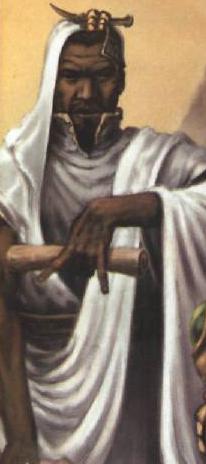
Humans are the dominant culture in the explored parts of Athas. Among the races, they are known for their versatility and willingness to adapt to the harsh realities of life on Athas.
Personality: Humans tend to be ambitious and individualistic: even the tyranny of the dragon-kings hasn't stamped out human diversity. Other races often don't know what to expect when meeting a human for the first time, because predicting their behavior based on cultural norms is difficult. "It's human nature," they say with a shrug whenever humans take some action for no apparent reason.
Physical Description: Humans on Athas tend to be dark-skinned with brown or black hair, although exceptions exist. Templar and noble humans tend to display the greatest variety of hair and skin coloration.
Relations: Humans tend to get along well with the races they comingle with (dwarves, muls, elans, and maenads), although their friendly attitude sometimes seems patronizing. Half-giants and thri-kreen are regarded as somewhat fearsome and dangerous. Elves, and to a lesser degree half-elves, are considered flighty and untrustworthy. Aarakocras, halflings, and pterrans are viewed as fascinating and exotic.
Alignment: Humans have no natural alignment tendencies, although the culture of each city-state pressures its inhabitants to adopt the alignment of its dragon-king.
Human Lands: Most humans live in one of the seven city-states: Balic, Draj, Gulg, Nibenay, Raam, Tyr, and Urik. Others live in the smaller outposts and communities near oases in the desert, and some few are part of hunter-gatherer tribes in the heart of the wasteland.
Religion: Most humans worship (or at least venerate) the dragon-king of the city-state where they live. Some few follow the teachings of elemental clerics or join the druids in their nature-worship.
Language: Humans speak Common, the trade tongue, which is by far the most prevalent language on Athas. Most can read and write - even slaves are taught basic literacy so they can read various signs and inscriptions.
Names: For most humans, a single name suffices. Templars often take an honorific based on their rank in the religious hierarchy. Nobles also have a family name, which is generally referred to after the word "of," as in "Agis of Asticles." Members of a merchant house take the house's name as their own last name. Freemen occasionally refer to their occupations to avoid confusion, as in "Barek the Weaver."
Adventurers: Human adventurers tend to be daring and relentless no matter why they're adventuring - whether for fame, fortune, or belief in a cause. Their versatility makes them suited to any class.
ATHASIAN HUMAN RACIAL TRAITS
Athasian humans have all the human racial traits, except as follows:
-
+2 any ability score, +2 any other ability score. As the most varied race, humans have no consistent racial modifiers, but every human has some innate talent.
-
Inborn Powers: Humans gain 3 extra power points at 1st level, regardless of whether they choose a psionic class or not. Humans may choose any 1st-level power from the psion/wilder power list to become their inborn power, which they can manifest using their power points. Only humans have the ability to choose - the other races' choices are predetermined. If you take levels in a class that offers a repertoire of psionic powers, simply add the 3 power points to your power point total, and add your inborn power to your list of powers known. Humans use their inborn powers at a manifester level equal to their character levels. They use Charisma to set the save DC unless they have levels in a psionic class, such as psion or psychic warrior, that uses a different ability score to set the DC. In that case, they choose either Charisma or the psionic class's relevant ability score to set the save DC.
At 5th level, humans gain an additional 3 psionic power points and a 2nd-level power from the psion power list. At 10th level, humans gain an additional 5 psionic power points and a 3rd-level power from the psion power list. At 15th level, humans gain an additional 7 psionic power points and a 4th-level power from the psion power list. As with other inborn powers, if the human character has psionic classes that provide knowledge of higher-level powers, simply combine the power points and inborn powers known with those attained from the class.
-
Automatic Language: Common. Bonus Languages: Any (other than secret languages, such as Druidic).
-
Favored Class: Any.
-
Level Adiustment: +1.
ATHASIAN MAENADS
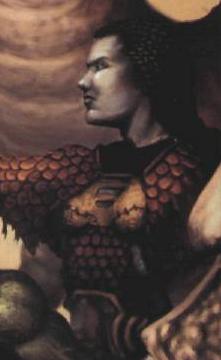
Maenads are a race of wildly emotional creatures who are known for the rare times that their legendary restraint breaks, allowing a flood of emotional turmoil to surface, often in acts of stunning bravery or violence. Maenads have a strong martial bent, useful for venting the emotional boil they constantly keep at bay.
Maenads know not the source of the spiritual anger they all keep bottled away, but part of it is undoubtedly that, as a race, they were trapped on a featureless demiplane of crystal and dust by a higher power. Early in the year of Priest's Contemplation, the dragon-king Andropinus escaped from his banishment to The Black, bringing with him an army of maenads he discovered during his imprisonment. At first, the maenad legions conquered the city-state of Balic in Andropinus' name, but they have since spread across the Tablelands. Not all owe allegiance to Andropinus anymore, as the dragon-king seems more interested in reestablishing his control over his old subjects than considering the welfare of those he brought to Athas. Many maenads who regarded Andropinus as a savior are now disillusioned by his cruelty and saddened by the harsh land that is their new home.
Personality: Maenads seem discreet and calm, even restrained and undemonstrative, unwilling to use a sentence where a word will do, and happier with a gesture if words can be dispensed with altogether. Their apparent calm is at odds with their more fiery reputation. However, in order to maintain a life in civilized lands and even (or especially) among themselves, maenads must practice a discipline of mental calm, lest the furies of their racial memory break forth. They are slow to make friends for this reason, but come to regard as family those that understand and accept them despite their occasional lapses.
Physical Description: Maenads are tall and have a wiry strength, standing about 5 1/2 to 6 1/2 feet tall, and typically weighing 145 to 220 pounds. Maenad men are the same height as, and only marginally heavier than, maenad women. Maenads have no facial or body hair, but usually wear the dark hair on their heads long and braided. Their skin is dusted with a peculiar sparkle, as of gem dust, giving them a striking luster in the right light. This sparkle is a natural component of their skin, which is flecked with tiny living crystals. Maenads possess grace and fine features. They prefer heavier clothes, and armor, if possible. A maenad achieves adulthood at about 25 years of age and can live to be over 150 years old.
Relations: Maenads are most comfortable with humans, finding their various temperaments similar to their own. They respect the dwarven ability to hold a grudge, but they find halflings rather silly. The other races they take as they find them, although maenads are particularly taken with elves, because the unconscious elven lightness of being is a balm to the maenad spirit. Maenads don't dislike aarakocras or thri-kreen, but they have a hard time understanding their ways.
Alignment: Maenads know that self-control is their best method of living a fulfilling life. Thus, they lean strongly toward law. Generally, they value and protect others' self control as well as their own, and so are more often good than not.
Maenad Lands: Maenads mostly live near Balic in communities of less than three hundred, where their well-hidden villages blend into the desert wastes. They hunt game and are beginning to work small farms on the fringe of Andropinus' territory. Maenads encountered in other lands are usually refugees, warriors for hire, or adventurers.
Religion: Some maenads still serve Andropinus, while others respond to the entreaties of the druids or of elemental clerics. Water clerics are particularly welcome among the maenads, for maenad elders say their original homeland was an archipelago teeming with life and sun.
Language: Maenads speak Maenadi, a language of strict grammar. Chants play an important part in their songmaking and literature. They have their own script, which looks surprisingly similar to Elven.
Names: Maenad names are given and used much like human names. Every maenad has at least one given name, and a family name.
Adventurers: Maenads take up adventuring out of a desire to travel and see more of the world. Moreover, some maenads tend to get along easier with other races less given to inner rage than themselves. However, maenads also are adept with the sword and some psionic power, and adventuring allows them to utilize these skills.
ATHASIAN MAENAD RACIAL TRAITS
Athasian maenads have all the maenad racial traits, except as follows:
-
+2 Strength, +4 Charisma. Maenads tend to be physically fit, and they have forceful personalities.
-
Automatic Languages: Maenadi, Common. Bonus Language: Elven.
-
Favored Class: Wilder.
-
Level Adjustment: +1.
MULS
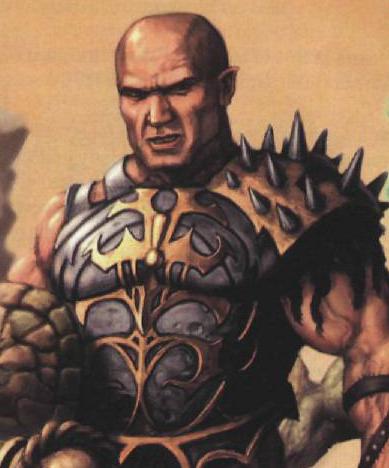
Sterile crossbreeds of humans and dwarves, muls have great stamina. Accordingly, the templars, noble families, and merchant houses breed them as slaves. Many of the same attributes that make them effective manual laborers serve them well in gladiator arenas.
Personality: Muls often have gruff, taciturn personalities, seen as a sort of social defense mechanism in the slave pits most call home. Many lash out in spite whenever they can avoid the consequences, having never known a friend or companion. Those muls who have escaped the toil of the typical slave (usually by excelling as a gladiator, being set free, or escaping) handle social situations better, but most remain wary of strangers and anyone who hasn't proven their trustworthiness.
Physical Description: Muls have a fast metabolism, so most of them are squat and muscular, with broad shoulders and very little body fat. Were it not for their pronounced brow ridges, slightly pointed ears, and lack of body hair, they could pass for human.
Relations: Muls are somewhat antisocial, but they don't have a particular enmity for any race. They get along slightly better with their forebears (humans and dwarves) and half-giants, who are often fellow slaves.
Alignment: The taskmaster's whip has instilled a lawful attitude in most muls, although those who have fled from slavery are usually chaotic (ex-slaves almost always have a hard time with authority figures). Mul slaves who are treated poorly - which are almost all of them - can nurture such hatred and spite in their hearts that they become evil.
Mul Lands: Muls have no culture of their own; they're entirely products of the city-states where they're bred. Some escaped slaves make a home for themselves among the desert tribes, but because no mul can start a family, they have no place to call their own.
Religion: Most muls are heavily indoctrinated into the worship of whichever dragon-king rules the city-state where they were born. Like half-giants, some enthusiastically take to the state religion, while others curse it under their breath each day.
Language: Muls are taught Common in the slave pits. If they learn other languages, it's often from captured slaves.
Names: Muls favor one simple name, generally a human one. They don't have families, so they don't take last names except in unusual circumstances. To avoid confusion, some muls will add an appellation such as "Rikus the Gladiator" or "Kalaa the Stone-Grinder."
Adventurers: Muls generally come to the adventurer's lifestyle in one of three ways. Some escape slavery and must remain one step ahead of their former masters. Others win their freedom through luck or skill - often by success in the gladiator arena. Finally, some are former soldiers under the command of the dragon-kings or in the pay of the merchant houses.
MUL RACIAL TRAITS
-
+2 Strength, +4 Constitution. Muls are strong and known for their great stamina.
-
Medium: As Medium creatures, muls have no special bonuses or penalties due to their size.
-
Mul base land speed is 30 feet.
-
Hardy: Muls need only half as much rest to eliminate the effects of fatigue and exhaustion.
-
Faster Natural Healing. Muls heal damage at twice the normal rate, recovering 2 hit points per level per day. At 10th level they gain fast healing 1, and at 15th level they gain fast healing 3.
-
Inborn Power: Muls gain 3 extra power points at 1st level, regardless of whether they choose a psionic class or not. They can use the power points provided to manifest their offensive prescience power. If you take levels in a class that offers a repertoire of psionic powers, simply add the 3 power points to your power point total, and add your inborn power to your list of powers known. Muls use their inborn power at a manifester level equal to their character level. They use Charisma to set the save DC unless they have levels in a psionic class such as psion or psychic warrior that uses a different ability score to set the DC. In that case, they choose either Charisma or the psionic class's relevant ability score to set the save DC.
-
Automatic Language: Common. Bonus Language: Dwarven.
-
Favored Classes: Fighter.
-
Level Adjustment: +1.
ATHASIAN PTERRANS
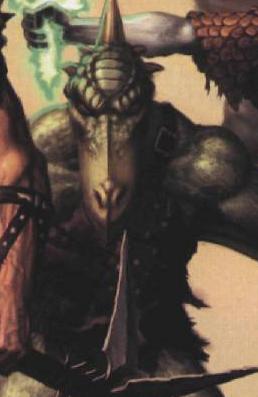
Reptilian creatures from the Hinterlands, pterrans are a rare sight among the city-states of Athas. A massive earthquake in the year of Desert's Fury shook pterran society out of its isolation; many young pterrans now leave their villages and explore the strange wonders of the rest of Athas.
Personality: Pterrans tend to be wary and subdued at first meeting, and most never get used to the stares of every passerby. Among other pterrans and trusted friends, though, most pterrans are open and caring. They have a subconscious politeness of demeanor, giving thanks for the smallest kindness.
Physical Description: Pterrans stand about 5 1/2 to 6 feet tall, and have light brown, scaly skin, three-fingered talon-like hands (with opposable thumbs) and three-toed feet. Vestigial leathery flaps of skin hang down under their thin arms. Their snouts are beaklike and long, and their narrow heads and long necks give them a birdlike profile.
Relations: Pterrans have been isolated long enough that they don't have any particular racial friendships or enmities, with two exceptions. The pterrans' villages have suffered from thri-kreen raider attacks of late, making the average pterran regard thri-kreen as dangerous bandits. Halfling culture and pterran culture have many parallel spiritual aspects, so pterrans get along well with halflings.
Alignment: Pterrans have an ingrained tendency to make sacrifices for the welfare of others, so most are good. They show no proclivity toward law or chaos.
Pterran Lands: Lost Scale and Pterran Vale are the two known pterran villages. All pterrans hail from there.
Religion: Pterran druids wield great spiritual influence in Lost Scale and Pterran Vale, and most pterrans celebrate the "Earth Mother" with brief prayers and ceremonies several times a day. Pterran travelers generally find worship of the dragon-kings distasteful, although they might swallow their abhorrence for the sake of politeness.
Language: Pterrans have their own tongue, but they're the only ones who use it. They've begun teaching Common to everyone in the community so they can better deal with the outside world.
Names: Pterrans use family names first, followed by a personal name that's often descriptive rather than abstract (Ptellac Coldeye, for example, is the brother of Ptellac Greentail and Ptellac Flinttooth). Few Athasians understand the distinction, however, and call their pterran companions by their family names.
Adventurers: Pterran culture is actively sending out young members of the community to learn more about the world. Pterran PCs are likely part of this wave of travelers.
ATHASIAN PTERRAN RACIAL TRAITS
-
+2 Strength, +2 Constitution, -2 Wisdom. Pterrans are physically powerful, but not particularly observant or willful.
-
Medium: As Medium creatures, pterrans have no special bonuses or penalties due to their size.
-
Reptilian: Pterrans have the reptilian subtype.
-
Pterran base land speed is 30 feet.
-
+5 natural armor bonus: The thick skin and scales of a pterran make them difficult to harm.
-
Natural attacks: A pterran can attack with two talons, dealing 1d4 points of damage each, or he can use a weapon in his talons. He can also attack with his bite as a secondary attack, dealing 1d3 points of damage.
-
Because of their tails, pterrans have a +4 racial bonus on Balance and Jump checks.
-
Inborn Power: Pterrans gain 3 extra power points at 1st level, regardless of whether they choose a psionic class or not. They can use the power points provided to manifest their burst power. If you take levels in a class that offers a repertoire of psionic powers, simply add the 3 power points to your power point total, and add your inborn power to your list of powers known. Pterrans use their inborn power at a manifester level equal to their character levels. They use Charisma to set the save DC unless they have levels in a psionic class such as psion or psychic warrior that uses a different ability score to set the DC. In that case, they choose either Charisma or the psionic class's relevant ability score to set the save DC.
-
Automatic Languages: Pterran and Common. Bonus Languages: Giant and Gith.
-
Favored Class: Barbarian.
-
Level Adjustment: +2.
THRI-KREEN
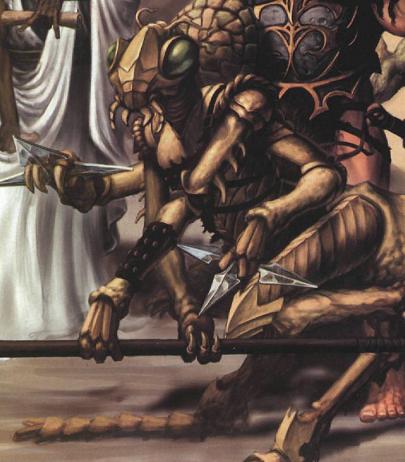
Mantislike creatures from the desert wastes, the thri-kreen are the most alien of the PC races in Dark Sun. They are pack predators with six limbs, a poison bite, and an obsession with hunting.
Personality: Thri-kreen have a pack mentality, and they're always concerned with their position in the "clutch." This makes them good team players, but a thri-kreen in charge expects his orders to be followed without question. Thri-kreen place great importance on knowing where their next meal is coming from. Because they wander in packs, thri-kreen rarely have any possessions they can't easily carry on their backs. They also don't object to eating other intelligent races if no other food source is available. Some thri-kreen hunting packs say elves are particularly delicious.
Physical Description: They have one set of legs they use for locomotion and two pairs of arms for manipulation. They have short antennae, multi-faceted eyes, and a yellow, brown, or gray exoskeleton.
Relations: How a thri-kreen relates to others depends entirely on whether they're members of his clutch; thri-kreen apply notions of clutch allegiance to almost every social situation. A thri-kreen will leap to the defense of a clutchmate without question, but anyone outside the clutch is a potential rival.
Alignment: Thri-kreen respect the order of the clutch, so most tend toward a lawful alignment. Thri-kreen don't think of the world in the absolutes of good and evil as do other races, and so they have no tendency toward one or the other (nor even to neutrality).
Thri-Kreen Lands: Beyond the Jagged Cliffs, north of the city-states, are the great mantis-cities of the tohr-kreen, a settled, civilized group of thri-kreen. Most thri-kreen have no permanent communities, wandering wherever good hunting takes them.
Religion: Thri-kreen find worship of the dragon-kings puzzling, because the dragon-kings don't look after their worshipers the way a clutch leader should. Elemental clerics are respected for their power. Thri-kreen often come into conflict with druids; to a thri-kreen, the animals druids want to protect and preserve are merely tasty meals.
Language: Thri-kreen have no lips and a different tongue than humans have, so they can't make the following sounds: p, b, f, v, m. Their own language, Thri-Kreen, includes a series of clicks and pops that humans have a hard time imitating. Thri-kreen also supplement their verbal communication by emitting pheromones; the pheromone "vocabulary" has only vague, general meanings, but the faint smells enable thri-kreen to express fine shades of meaning and cultural idioms. Only creatures with scent can make out thri-kreen pheromones, and they only understand their meaning if they speak Thri-Kreen.
Names: Thri-kreen have single names that have many glottal stops (denoted with apostrophes) and hard consonant sounds.
Adventurers: Thri-kreen are well suited to the adventurer's life: they're mobile, effective in a fight, and they have a number of useful racial abilities. Furthermore, their clutch-based way of looking at social situations means that they fit in better with a small, egalitarian group than they do a large hierarchy or a teeming city-state.
THRI-KREEN RACIAL TRAITS
-
+2 Strength, +4 Dexterity, +2 Wisdom, -2 Intelligence, -4 Charisma. Thri-kreen are strong and quick, but they think differently than most humanoids, and have a hard time relating to folk of other races.
-
Medium: As Medium creatures, thri-kreen have no special bonuses or penalties due to size.
-
Thri-kreen base land speed is 40 feet.
-
Immunity to sleep. Since thri-kreen do not sleep, they are immune to magic sleep effects. A thri-kreen spellcaster still requires 8 hours of rest before preparing spells.
-
Darkvision: Thri-kreen can see in the dark up to 60 feet.
-
+3 natural armor: A thri-kreen's exoskeleton is resistant to blows.
-
Multiple Limbs: Thri-kreen have four arms, and can take the Multiweapon Fighting feat instead of the Two-Weapon Fighting feat. Thri-kreen can also take the Multiattack feat. These are not bonus feats: thri-kreen characters must spend feat slots to learn these feats.
-
Natural Attacks: Thri-kreen can attack with four claws and a bite. The claws deal 1d4 damage, and the bite is a secondary attack (-5 penalty on the attack roll, and half Strength bonus on the damage roll) that deals 1d4 damage. A thri-kreen can attack with a weapon (or multiple weapons) at the normal attack bonus and make either a bite or claw attack as a secondary attack. For example, a thri-kreen ranger with the Multiweapon Fighting feat and armed with three short swords could attack with all three swords at a -2 penalty (the normal penalty for fighting with multiple weapons while using light weapons in its off-hands), and also make a bite attack at a -5 penalty.
-
Poison (Ex): Bite, initial damage 1d6 Dex, secondary damage paralysis, DC 11 + Con modifier. A thri-kreen produces sufficient poison for only one bite per day.
-
Leap (Ex): Thri-kreen are natural jumpers. They gain a +30 racial bonus on Jump checks.
-
Weapon Familiarity: The gythka and chatkcha are martial weapons for thri-kreen.
-
Naturally Psionic: Thri-kreen gain 1 extra power point at 1st level, regardless of whether they choose a psionic class or not. They do not gain an inborn power as other races do, instead receiving a number of psi-like abilities.
-
Psi-like Abilities 3/day - chameleon, know direction and location; 1/day - greater concealing amorpha, metaphysical claw. These abilities are as the powers manifested by a wilder of 1/2 the thri-kreen's Hit Dice (minimum 1st level).
-
Monstrous Humanoid Hit Dice: Thri-kreen are 2 HD monstrous humanoids before adding any class levels. A thri-kreen character has 2d8 racial Hit Dice, and receives maximum hit points on his first racial Hit Die (but not his first class Hit Die). A thri-kreen's racial Hit Dice also provide a +2 base attack bonus and base saving throws of Fort +0, Ref +3, and Will +3.
-
Racial Skills: A thri-kreen's monstrous humanoid Hit Dice grant him skill points equal to 5 × (2 + Int modifier, minimum 1). Class skills for these skill points are Balance, Climb, Hide, Jump, Listen, and Spot.
-
Racial Feats: Thri-kreen gain Deflect Arrows as a racial bonus feat. A thri-kreen's monstrous humanoid levels grant it one feat (although thri-kreen with class levels gain feats based on its total Hit Dice, just like any other character).
-
Thri-kreen receive a +4 racial bonus on Hide checks in sandy or arid settings.
-
Automatic Languages: Thri-Kreen and Common. Bonus Language: Giant and Halfling.
-
Favored Class: Psychic warrior.
-
Level Adjustment: +2.
EXILED DWARVES
Losing too many ancestral holdings to feral humanoids and their giant allies, the dwarves find all their great tales, records, and clan histories lost or destroyed. Estranged from their ancestors and the earth that holds them, the dwarven reliance on tradition weakens. This loss impacts the race deeply, both physically and mentally. No longer a subterranean race tied to the earth by bonds of history, they begin losing their affinity for natural stonework, their stony resilience, and their rocklike stability.
Ever an industrious and inventive people, the dwarves dedicate themselves to reclaiming everything they lost with all the rugged determination one expects from their race. Although initially softened by being severed from their past, the dwarves work the toughness back into their frames through hard work and dedication. Stoking the fires within themselves instead of the forge, they learn to turn the emotional turmoil of their loss into yet another weapon. No matter how much they gain to compensate for their loss, every dwarf has but one dream: to use these new tools to reclaim their old position within the earth, that they may cast aside these crutches and return to the way things should be.
EXILED DWARF RACIAL TRAITS
Exiled dwarves have all the dwarven racial traits, except as follows:
-
Exiled dwarves lose the following abilities: Darkvision; Stonecunning; Stability; +2 racial bonus to resist poison; +2 racial bonus to resist magic.
-
1 extra feat at first level. As dwarves have lost much of their natural stubbornness and become more open to new ideas.
-
+2 racial bonus on attack and damage rolls against orcs and goblinoids (this is instead of the usual +1 bonus). Now more than ever, dwarves strive to eradicate those who drove them from their homelands.
-
+6 dodge bonus to Armor Class against monsters of the giant type, instead of the usual +4 bonus.
-
Favored Class: Barbarian. A multiclass dwarf's barbarian class does not count when determining whether he takes an experience point penalty for multiclassing. Dwarven vengefulness and rage now suits the race more than the discipline of hardened fighters.
DECLINING ELVES
Elves find the magic that once so freely ran through their veins inexorably waning. The words of power now come no more easily to them than any other race. To make matters worse, it is this same magic that sustained them through the centuries. Cut off from its flow, elves now wither and age at a horrifying rate, robbing them of precious decades to study ever more difficult magical lore.
However, they still retain their culture and traditions, and elves are known as much for their swordwork and archery as they are for their spellcraft. Death's unprecedented proximity sparks a passion such as the elves have never known, and they throw themselves into the refinement of their martial skills with the fervor of those about to enter a battle they know they cannot win but are determined to die fighting.
DECLINING ELF RACIAL TRAITS
Declining elves have all the elven racial traits, except as follows:
-
Declining elves lose the following abilities: Immunity to sleep effects; Racial bonus to saves against enchantment spells or effects; Lifespan: elves now age as half-elves; Elves can no longer enter their restful trances and must sleep 8 hours a day like other races.
-
Weapon Focus: Elves receive the Weapon Focus feat in one melee and one ranged weapon. These weapon choices must come from the weapons elves receive free Martial Weapon Proficiency in (longsword, rapier, longbow, shortbow).
-
Favored Class: Ranger. A multiclass elf's ranger class does not count when determining whether he takes an experience point penalty for multiclassing. With the decline of their natural magical power, elves embrace the power of their beloved wilderness even more tightly.
TECHNO GNOMES
These prank-loving tinkerers are similar to elves in that they have a mix of magical and mundane abilities. However, a series of dramatic scientific advances brings the race into a new age of technological enlightenment. In embracing their new sciences, they allow their innate magical powers to wither.
As their scientific skills increase, gnomes lose their interest and pleasure in illusions, and they find their natural affinity for such magic evaporating. However, their increased inventiveness and mechanical skill compensate for such a loss.
TECHNO GNOME RACIAL TRAITS
Techno gnomes have all the gnome racial traits, except as follows:
-
Techno gnomes lose the following abilities: Bonus to saves against illusions; +1 to the DC to all illusion spells cast by gnomes; All spell-like abilities.
-
Alertness: Gnomes gain the Alertness feat for free at 1st level. No longer able to tell instinctually what is real and what is an illusion, gnomes sharpen their already acute senses.
-
+2 racial bonus to Craft, Disable Device, and Open Lock checks: As gnome technological prowess far outstrips any other race's, they have an innate understanding of all things mechanical.
-
Favored Class: Rogue. A multiclass gnome's rogue class does not count when determining whether he takes an experience point penalty for multiclassing. The rogue class presents many more opportunities for gnomes to put their newly honed knowledge of mechanical devices to work.
UNSHELTERED HALFLINGS
Halflings don't have much in the way of magical ability, but they certainly seem to live charmed lives. Strangely resilient to fear and often able to escape the dangerous repercussions of rash decisions, halflings possess a mix of abilities that allow them to glide through life without thought to consequences - assuming they don't get too foolish, of course.
However, with the advent of some great calamity or racial awakening, this supernatural luck is the first thing to go. Suddenly faced with dangers that fate previously shielded them from, the halflings become a more somber, less carefree people. Now they have reason to consider their actions, to use forethought, and to fear.
No longer graced with supernatural protection, these unsheltered halflings must quickly learn how to provide protection for themselves or cease adventuring altogether. Since reclaiming the race's former favor from fate could be the greatest adventure of all, few let such hard training deter them.
UNSHELTERED HALFLING RACIAL TRAITS
Unsheltered halflings have all the halfling racial traits, except as follows:
-
Unsheltered halflings lose the following abilities: Racial bonus on saving throws; Morale bonus to resist fear.
-
Dodge: Halflings gain the Dodge feat for free at 1st level, as they are forced to rely more on themselves to stay out of harm's way.
-
Bonus Feat: At 3rd level, halflings select one of the following feats to gain as a bonus feat: Iron Will, Lightning Reflexes, or Great Fortitude. No longer relying on their innate luck, halflings develop more potent defenses.
COMPLACENT HUMANS
In their minds, the humans have won. The frontiers have been explored, the wilds tamed, and every perceived enemy defeated. With their peaceful cities expanding and the wealth of the world's farthest reaches flowing eagerly in. the pinnacles of human achievement have been reached.
Decadence and complacency are swift to take root in the human soul. Confident in the power they hold and the riches they've earned, human civilization shifts, resting on its laurels rather than fighting to protect what it has. This decadence leads to some great advances, since money buys humanity not only luxury, but fine education in both physical and mental pursuits. However, these scholars and athletes lack the drive of their predecessors and accomplish much only because of the advantages their situation grants them, not because of their own excellence.
COMPLACENT HUMAN RACIAL TRAITS
Complacent humans have all the human racial traits, except as follows:
-
Complacent humans lose the following abilities: Bonus feat at 1st level; Bonus skill points at 1st and subsequent levels.
-
Apply a +2 racial bonus to one ability score. Decadent humans are known to train their bodies for sport and beauty, or their minds for intellectual debate, but they no longer care much for the real world applications of their abilities. Thus they tend to be talented, but not particularly accomplished.
-
Favored Class: Bard. A multiclass human's bard class does not count when determining whether he takes an experience point penalty for multiclassing. With a definite preference for style over substance, humans make skilled but uncommitted bards.
GLIMMERFOLK

The glimmerfolk are a planetouched race, native to the Material plane where they live in eerie forests infused with radiant energies. They are fiercely isolationist and have little contact with other peoples.
Glimrrierfolk are taller but slighter than humans. They have deeply tan skin, ranging from brown to bronze. Their hair color can be of any of the fairer shades that occur in humans, while their eyes are night-black with tiny, flickering lights of many colors. Their lifespans are also similar to those of humans. Glimmerfolk garments, weapons, and other equipment are always of excellent quality and artistic design, and are extremely well cared for, frequently appearing new.
Glimmerfolk are a civilized, learned race, but their xenophobia can make them distrustful and dangerous. They follow a prince, a hereditary office passed down from father to eldest son. Glimmerfolk children do not have nimli. At puberty each child goes on a solo "walkabout" called the Bright Journey. A small number do not survive, but the rest return with their full complement of nimlis and are considered adults.
Glimmerfolk are usually encountered in their forests and are not hospitable to strangers. Rare glimmerfolk found in the outside world have usually been sent by the prince and his council, either for diplomatic purposes or on a quest to find items or information needed by the glimmerfolk. Even more rare are runaways, glimmerfolk who turn their backs on their people and their home to explore the world. These free spirits are considered outlaws and are shunned.
The glimmerfolk live in a wide variety of communities: large forest cities, smaller towns, family estates, and druidic enclaves. They love art and poetry, as well as the natural beauty of their forest, but see all other races (with the possible exception of elves and fey), as threats to that beauty.
Glimmerfolk strive for excellence in all they do, be it art, magic, or warfare. They are usually well organized and work well together, using both their martial talents and their spellcasting abilities to protect themselves and their forest.
GLIMMERFOLK RACIAL TRAITS
-
+2 Dexterity, -2 Strength. Glimmerfolk have an otherworldly grace that stems from their planar heritage, but they possess a frailty that makes them ill suited to the harshness of the natural world.
-
Medium size.
-
A glimmerfolk's base land speed is 30 feet.
-
Low-light vision.
-
Immunity to pattern effects.
-
+2 racial bonus on Perform checks.
-
+4 racial bonus on saving throws against spells of the shadow subschool or with the darkness descriptor.
-
Nimlis (Sp): All adult glimmerfolk have little globes of immaterial colored light; about 2 inches in diameter, which float within 1 foot of them at all times. These lights are called nimlis and are an extension of a glimmerfolk's life force. Nimlis' slowly orbit glimmerfolk in random paths, usually just above their shoulders. Nimlis are a natural part of the glimmerfolks' existence and are thought of in the same terms most races consider hair color.
A nimli glows with a constant light equivalent to a candle. Since several lights usually surround them, glimmerfolk suffer a -2 penalty on Hide checks for each nimli they have active. Nimlis do not interfere with spells such as mirror image or invisibily.
As a standard action, a glimmerfolk can use one or more of her nimlis to cast a spell. Doing so causes the nimli to "burn out," fading from existence until the glimmerfolk has a chance to rest for at least 8 hours. After that time, any used nimlis reappear. A glimmerfolk using one of her nimlis can reproduce the effects of the spells dancing lights, daze, or flare. By using two nimlis, a glimmerfolk can cast color spray or magic missile. By burning all three nimlis, a glimmerfolk can cast mirror image.
-
Automatic Languages: Sylvan. Bonus Languages: Auran, Common, Elven, Gnoll, Gnome, Goblin, and Orc.
-
Favored Class: Ranger.
CYCLOPEANS
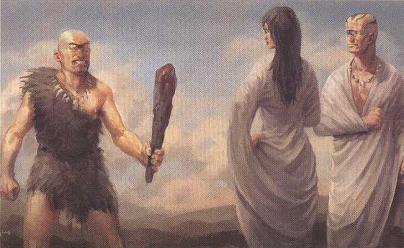
Legends speak of a enigmatic race of giants known as the cyclopes. Similar to hill giants in many ways, these brutes had one unique trait: single eyes situated in the middle of their foreheads. Cyclopes lived in an uneasy peace with other giants, with the one-eyed beings losing battles more often than winning. Over time, cyclones lost the majority of their territory, forcing them to move farther into the wilderness or closer to the settlements of humanoid races, particularly humans. In most of these collisions of cultures, the humanoids treated cyclopes with fear and suspicion, resulting in the slow decline of the cyclopes population. Over the centuries, as the cyclopes died off, other races came to regard them as nothing more than a myth.
However, pockets of these giants survived in the wilderness and along the rocky crags of forbidding shores. Tales persisted of sailors running afoul of cyclopes living on isolated islands. Most of these stories ended poorly for the sailors, but some tell of a cyclops who would trade a glimpse into the future for goods or favors. In one story a flood of refugees fled their city during a siege and sought out the ancient cyclops, Menta the Wizened. Menta foretold of great doom and despair for many of the refugees, but eventual revenge against their attackers. His prophecy came true, and the grateful survivors deified Menta and made his home a sacred place.
Worshippers and omen seekers often visited the island, and Menta took some as mates. His children, although smaller and weaker than the giant who begat them, slowly spread throughout the land and became a viable race in their own right. These first cyclopeans retained both their ancestor's ability to look into another person's future, as well as a deep passion for solitude and respect for nature. Most of these cyclopeans stayed close to the sea, doing their best to remain hidden from others. They made peaceful contact with gnomes, fey, and the rare dwarven clans who regarded cyclopeans with curiosity.
Although most cyclopeans consider Menta the father of their race, other myths persist that tell of tribes that descended from other cyclopes. Known as the feral-kind, these cyclopeans are violent and savage, like many other types of giants. While most cyclopeans descended from Menta wish only to live in peace, their brethren make life difficult for the race, attacking innocent travelers who roam too close to their caves and hovels.
Today, the two cyclopean branches form a minor, fragmented race, eking out an existence among more numerous humanoids. Rumors persist that some cyclopeans see visions of their races ultimate fate - but none, even under pain of death, reveal what the future holds for their kind. Some sages speculate that the cyclopeans face a slow, agonizing extinction as their bloodline runs dry, although hints abound of the race gaining greater glory and respect.
Optimistic - some say naive - cyclopean adventurers dedicate themselves to increasing their race's beleaguered status. The boldest make quests to locate the few remaining cyclopes in hope of bringing power to their ailing race. The most fervent even believe Menta lives and waits for his children to return to him, and they scour the world seeking him.
Personality: Introspective and thoughtful, Menta cyclopeans often take a long-term view. Because of their ability to look into the future, cyclopeans often seem lost in thought, spending more time "looking forward" than paying attention to the world of the present. Even if not actively using their future sight, most cyclopeans spend their time mulling over other creatures' fates and what those creatures mean in the scheme of the universe. To others, a cyclopean might seem distracted and absent-minded, and often needs coaxing to pay attention to matters at hand. Otherwise, the relatively peaceful and withdrawn cyclopeans strive to live in harmony with their surroundings. Often witnesses to the folly in others, they maintain a fatalistic attitude toward life that makes them stoic and unemotional. They know of the future's eternal flux and that patience and calm help them survive turbulent times - they believe that if one waits long enough, new possibilities always emerge.
Their unique ability to see into the future creates two distinct personality types among the peaceful Menta cyclopeans. One type becomes deeply intrigned - almost obsessed - with the lives of other sentient beings, peering into the future and watching as their fates play out. Sometimes these cyclopeans befriend beings they see as having interesting fates, guiding those creatures with advice bestowed by their ability. The other type of Menta cyclopean, haunted and overwhelmed by seeing the fate of others, withdraws from society and seeks solitude. They reveal their secrets only through bribes, coercion, or methods of convincing them of the importance of their information.
Either way, many beings seek out cyclopeans in hope of finding out what the future holds. Mosst Menta cyclopeans loathe revealing too much and become angry or morose if asked to often. Menta cyclopeans cherish those beings who learn to accept them for more than their ability to see into the future.
Bitter and savage, the feral-kind cyclopeans use their great strength and physical prowess to toy with victims before killing them out of spite. These evil loners typically live close to other humanoids in order to have plenty of "toys" to play with. Feral-kind cyclopeans possess a dark and twisted view of the world, seeing it as a place of hardship where only the strong survive. They see their more peaceful brethren as weak and soft, misusing their talents and heritage for pointless reasons. Smarter feral-kind cyclopeans might even adopt the ruse of acting like their more gentle brethren in order to lure the naive and overly trusting.
Physical Description: Descended from the giant race of cyclopes, these extremely tall humanoids stand just shy of large size at 7 to 8 feet. With wiry builds and ruddy, leathery skin, cyclopeans weigh between 250 and 350 pounds. Both types of cyclopean females generally wear their hair very long while the males shave their heads bald. Elder male cyclopeans commonly tattoo their smoothly shaved heads with intricate abstract patterns. The higher the male's status, the more complicated the tattoo.
Located immediately above the bridge of its nose, the cyclopean's single eye is slightly larger than normal for a humanoid of its size, and it requires far less blinking to keep it moist and safe. Its eye always has a brilliant color resembling a gemstone, with no two cyclopean irises sharing the same color. Because of their single eye, cyclopeans lack depth perception and few make use of ranged weapons, preferring to hunt with spears and clubs, or to fish for their meal. This lack of depth perception often causes them to ignore personal space and move uncomfortably close to others, and it also makes them nervous when people try to talk to them from far away.
Menta cyclopeans prefer to wear simple garb, such as tunics, loincloths, or robes, which they often wear short in the dry, arid regions that they commonly inhabit. They dislike bold and gaudy adornment, although almost every Menta cyclopean wears a necklace or other bit of tasteful jewelry made from natural materials. Feral-kind cyclopeans wear animal skins and bits of jagged metal, often culled from discarded or stolen armor.
Relations: Cyclopeans live close to the land, and as a result, find themselves dealing most often with gnomes, dwarves, and sylvan beings. Menta cyclopeans respect the privacy and territory of other races and ask only the same in kind. However, due to their future sight, other beings often seek out cyclopeans in hopes of having their futures predicted. Some tribes see little problem with this, trading information from their visions for goods from other races. Other tribes dislike the requests and demands of seekers who ask too much or too often, and they turn their backs on anyone who gets too pushy.
Feral-kind cyclopeans, particularly those who live deep in the wilderness, often find themselves dwelling side-by-side with sylvan races, such as satyrs, pixies. and dryads. Occasionally, this close proximity leads to violence, but the feral-kind cyclopeans have lost enough warriors in the past that they rarely start fights anymore. Most cyclopeans treat giants with neutral attitude, knowing that they share a common ancestry, but one they often wish to leave in the past. In turn, giants, especially hill and stone giants, regard cyclopeans with superstition and begrudging respect. Most giants simply leave them alone, sensing the blood of the cyclopes running in their veins. The more enlightened and intelligent giants, such as cloud and storm giants, have a patronizing view of cyclopeans, seeing them as a failed and dying bloodline doomed to pass into obscurity.
The two cyclopean factions do not get along, their meetings often ending in bloodshed. However, because their race lacks numbers, few cyclopeans actively quarrel with their kin. At best, Menta and feral-kind cyclopeans simply ignore each other and strive to stay far away from each other's territory.
Alignment: The introspective Menta cyclopeans like to gather facts before passing judgment, making most of them neutral or lawful neutral. The far more savage and brutal feral-kind cyclopeans tend more toward chaotic and evil behavior, although the isolationists among them lean toward neutral evil.
Religion: Concerned with the natural rhythm of life and the ebb and flow of fate in the universe, cyclopearis pay little heed to most religions. Those who do pray to deities commonly worship Obad-Hai (representing balance in nature), or Boccob (the uncaring deity of magic). Cyclopeans with a violent bent (which occurs most commonly among the feral-kind, but occasionally among the Menta cyclopeans) worship Nerull or Erythnul. Overall, however, cyclopeans like to make their own judgment on matters and dislike those who preach to them or make them targets of religious conversion. Regardless of their beliefs, all cyclopeans possess deep convictions pertaining to their heritage - the Menta cyclopeans believe Menta begat their species, while feral-kind see themselves as the wronged descendants of ancient cyclopes from long ago.
Language: Cyclopeans speak Giant as their natural tongue, although those who live close to other races learn to speak Common as well. Linguists note that cyclopeans speak a rather brutish version of Giant with a lyrical tone to their voices, a trait that most other beings find slightly hypnotic. Ocular imagery and numerous phrases discussing fate and the future fill the cyclopean dialect.
Names: As befitting their giant ancestry, cyclopeans have short, simple names. They eschew familial names in favor of titles, such as "the Dark Seer," "the Sullen," or "the Waywalker." Only other cyclopeans (or sometimes the tribe as a whole) grant such titles. Titles might change over time as cyclopeans experience life-changing events. A few adopt the naming conventions of other races, particularly dwarves and gnomes, accepting this additional name as just another way to make themselves out as individuals.
Male Names: Brengar, Corvor. Gorr, Merr, Tuffor, Ulbur, Warror.
Female Names: Emara, Kelara, Lessi, Nallo, Oova, Tamri, Veshe.
Adventurers: Rare but active, cyclopean adventurers leave the safety of their rocky homes and sucumb to wanderlust. Menta cyclopean adventurers typically become wizards - particularly diviners - spending their time studying magic to better unravel the tangled web of the future. Because of their tendency to hail from wild and untamed lands, feral-kind cyclopeans favor the barbarian class.
MENTA CYCLOPEAN RACIAL TRAITS
-
+2 Constitution, -2 Dexterity. Although quite sturdy, Menta cyclopeans lack grace or coordination.
-
Medium: As Medium creatures, cyclopeans have no special bonuses or penalties due to their size.
-
Cyclopean base land speed is 30 feet.
-
Darkvision: Cyclopeans can see in the dark up to 60 feet. Darkvision is black and white only, but it is otherwise like normal sight. Menta cyclopeans function fine with no light at all.
-
Future Sight (Su): Three times per day, a Menta cyclopean may spend a full-round action to peer into the future of a creature. This functions as the augury spell, except it does not require any components and cannot predict the future of the cyclopean himself. The cyclopean must touch the target creature for the full round. The Menta cyclopean may only use this ability once per creature per day.
-
Single Eye: Because they only have one eye, cyclopeans lack depth perception. Cyclopeans suffer a -2 penalty on all ranged attack rolls, Search checks, and Spot checks.
-
Automatic Languages: Common and Giant. Bonus languages: Dwarven, Gnome, Sylvan, and Terran. Cyclopeans live close to the earth and often learn the languages of those attuned to it.
-
Favored Class: Wizard. A multiclass Menta cyclopean's wizard class does not count when determining whether he takes an experience point penalty for multiclassing. Most cyclopean wizards become diviners, using spells to augment their ability to peer into the future.
FERAL-KIND CYCLOPEAN RACIAL TRAITS
-
+2 Strength, +2 Constitution, -2 Dexterity, -2 Intelligence. Just as clumsy as their Menta kin, feral-kind cyclopeans make up for their lack of grace with considerable physical power. However, they lack the cunning of their kin.
-
Medium: As Medium creatures, cyclopeans have no special bonuses or penalties due to their size.
-
Cyclopean base land speed is 30 feet.
-
Darkvision: Cyclopeans can see in the dark up to 60 feet. Darkvision black and white only, but it is otherwise like normal sight. Feral-kind cyclopean function fine with no light at all.
-
Glimpse the Future (Su): Feral-kind cyclopeans lack the full future sight ability of their Menta cyclopean kind. Instead, they can see brief snatches of the future that let them react to danger better. Feral-kind cyclopeans get a +1 insight bonus on Initiative checks and Reflex saves.
-
Single Eye: Because they only have one eye, cyclopeans lack depth perception. Cyclopeans suffer a -2 penalty on all ranged attack rolls, Search checks, and Spot checks.
-
Automatic Languages: Common and Giant. Bonus Languages: Dwarven, Gnome, Sylvan, and Terran. Cyclopeans live close to the earth and often learn the languages of those attuned to it.
-
Favored Class: Barbarian. A multiclass feral-kind cyclopean barbarian's class does not count when determining whether he takes an experience point penalty for multiclassing. Already crude and dangerous, feral-kind cyclopeans find it easy to enter berserker rage.
GRIPPLI
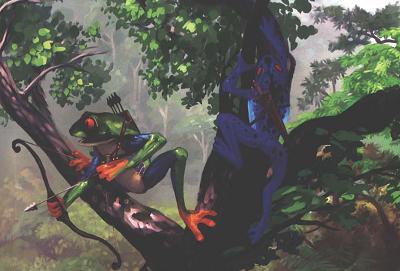
Grippli resemble small, intelligent, humanoid tree frogs. Primitive and largely peaceful, grippli lead a simple existence. Living off the bounty of the swamps and rainforests they inhabit, they spend their days hunting insects and gathering fruit. Warlike races that neighbor grippli settlements soon learn to avoid them as, although they rarely attack anything but insects, the grippli prove effective and mobile defenders of their homes and keep few possessions worth the risk of pillaging.
Grippli live in isolated family groups, clustered into loose villages led by an elder priestess known as the tribe mother. These families tend to be small, as the long-lived grippli produce few offspring. Grippli devoutly follow the decisions of the tribe mother. In theory. this elder priestess holds divinely granted power over her village. In practice, she rarely exerts that power, leaving the day-to-day leadership of the tribe to its most experienced hunters, often elder males. Grippli tribes require little governance in any case, each family making most of its own decisions, barring religious matters and a village-wide crisis or dispute.
Few grippli apply themselves as craftsmen or artisans. Simple wood, stone, and vine creations make up the majority of the weapons grippli use in hunting and defense, while they pass rare metal weapons and tools down through the generations as treasured heirlooms. Grippli rarely fashion even the simplest trade goods and more rarely do their spellcasters craft complex magic items, although potions, alchemical creations, and herbal tinctures are quite common.
Unscrupulous traders sometimes take advantage of the grippli, selling them worthless baubles in return for rare and valuable herbs, unguents, and extracts from the deep jungle. The grippli don't see themselves as getting taken advantage of, though. They understand the value outsiders place on their purchases, but they in turn prize brightly colored curios. Polished quartz, vibrantly dyed cloths, colored glass, and eclectic collections of foreign signs brighten the majority of grippli homes.
Besides the rare trader, the grippli deal only with the insects they hunt and the giant snakes and spiders that hunt them. Such giants seem to favor the taste of grippli flesh and frequently attack grippli communities. Lizardfolk and kuo-toa also sometimes hunt grippli, although both races have strict taboos against eating the smaller humanoids' flesh. The enmity between these races seems to date to their distant pasts, perhaps even to some conflict between their gods.
The origins and history of the grippli are shrouded in mystery, even to themselves. As grippli do not keep records, except for those relevant to their worship, their past remains a subject of conjecture and guesswork. The prevailing theory holds that grippli exist now much as always, a humble race of peaceful recluses content with what the land provides and the world they know. This surprising peacefulness seems to stem from their simple faith in their nameless froglike goddess. With the land providing them all they need and a faith to further content their modest lives, the grippli have had little need to change over the centuries.
Personality: In the presence of strangers, grippli become noticeably skittish. They usually climb the nearest tree and hide upon spotting other humanoids or any other creature deemed dangerous. Among their own kind or those they accept as friends, grippli show their true character. Light-hearted and cheerful, they value familial bonds and the simple pleasures of food, games, rest, and shiny objects from the outside world. Other humanoids sometimes perceive relaxed grippli as blase, even lazy, but a relaxed grippli might snap to full alertness at a moment's notice.
Although reluctant warriors, grippli are far from cowardly or inept in combat. When forced to fight, they do so cunningly and viciously, leaving surviving assailants with no doubt about the danger of attacking again. Thus, tales of grippli fighting ability keeps them safe from most of their enemies, as the latter consider an assault upon the grippli's secluded homes not worth the risk, assuming they can find the grippli in the first place.
Physical Description: A typical grippli stands 2 to 2-1/2 feet tall and weighs approximately 30 lbs, although the very old and particularly powerful hunters might stand and weigh twice that. A gripplis head and body appear similar to those of a giant frog, but its hands and feet look humanlike. Grippli skin color varies dramatically depending on their environment, ranging from the brown-splotched green of swamp grippli to vibrant blues, yellows, and reds of rainforest-dwelling tribes. Grippli rarely wear clothing, although they often decorate themselves with jewelry and trinkets that members of most other races consider gaudy.
Grippli reach adulthood at 30 years and live to around 180 years old, while females live slightly longer on average than males. A female grippli gives birth at most six times in her life, becoming fertile at roughly 25-year-intervals after she reaches maturity.
Relations: Grippli rarely interact with outsiders, as they live in the deepest regions of the wilds. If they have any outside interaction, it is with individuals of other races, and almost never on the level of a societal alliance. They sometimes abandon their villages if other races begin settling too close.
When a grippli village does make contact with other races, wild elves or fey often serve as intermediaries, as their strong connection to nature makes the grippli more comfortable around them. However, a grippli's purpose for contacting the outside world rarely has anything to do with nature, as they enjoy strange inventions, masterwork items, and other colorful and shiny objects. As such, grippli sometimes entreat their allies to seek out colonies of gnomes to trade with.
Grippli find dwarves and humans intimidating, too rarely encounter halflings to form an opinion, and deeply fear anything that smells of orc, half-orcs included. They similarly fear giants and savage humanoids, particularly those who share their habitat.
Grippli Lands: Grippli inhabit deep marshes and remote rainforests, both since these areas hold the giant insects they prey upon and keep them well secluded. They construct small villages either on the ground or in the branches of large trees. Occasionally, a grippli colony might take up residence in the branches of an especially large treant or make a floating community among a marsh's dense river vegetation.
Grippli villages consist of simple huts made from branches or reeds. Most bear decorations, usually shiny objects, simple religious totems, and woven flowering vines. Because the grippli share their environs with many larger, more dangerous creatures, their villages tend to be spread out and semi-nomadic. If one area suffers an attack, all the grippli in the village take to the trees and flee from branch to branch, leaving their few valuables behind. Only when the entire tribe is safely hidden do grippli warriors return to their village to combat their attackers.
Hunting parties of grippli frequently roam the lands near their homes, although their elusive nature and habit of traveling through the trees makes them difficult to spot or track. These hunts serve the dual purposes of scouting the land for signs of intruders and bringing back the massive insects grippli eat or offer to their goddess. Swift, organized, and quick to retreat when outmatched, grippli hunting parties rarely come to harm or even conflict in the deadliest parts of their tangled homes.
Powerful predators, especially green dragons, sometimes enslave whole tribes of grippli. Such grippli usually accept their fate, as their master's protection provides a more formidable defense than any they could maintain. Only when shackled by an especially cruel overlord do grippli make any attempt to overthrow the creature or escape its domination.
Alignment: Their ties to nature and xenophobic tendencies cause grippli to tend toward neutral alignments. Predisposed to simple, relaxed lives with friends and family, the best grippli seem generous and helpful, while the worst merely seem indifferent. Thus, if a grippli deviates from a purely neutral alignment, it's usually in favor of good, and only after the most tragic incidents toward evil.
Religion: Grippli hold strong religious beliefs, although they rarely explain their faith to outsiders. Their chief deity is a nameless goddess, depicted in sculptures of wood and stone as a bulbous frog with vibrant rainbow skin. Most outsiders believe this amphibian deity to be nothing more than some strange, primordial forest spirit, but grippli revere her as the center of their religious lives.
More often druids than clerics, females almost exclusively comprise the grippli clergy. Led by a community's tribe mother, these priestesses make most of the decisions and solve the disputes of the tribe, although they defer to the tribe mother in all matters. Like a stern grandmother, the tribe mother holds absolute authority over the community and speaks as the voice of the goddess herself. Although she always keeps the best intentions of her people in mind, the tribe mother holds many secrets of her people's faith, which she reveals only to her protege and only when the time of her death nears. The few grippli clerics that exist most often serve abstract natural powers rather than the grippli goddess.
Grippli accord seasonal and celestial events great religious significance and mark them with elaborate religious celebrations that all tribe members participate in. These frequent festivals and general racial levity make it seem that grippli celebrate frivolously, but they truly consider each event worth commemorating. These festivals always culminate in large ceremonies and offerings to the grippli goddess. To outsiders, these ceremonies seem unusually extravagant as mountains of insect flesh, often enough to feed an entire grippli community for a season, are mixed with a strange pulpy paste and burnt as massive offerings. Although no visitor, and perhaps no grippli but the tribe mother, knows what this holy unguent consists of, preparations of all offerings include liberal treatment with this mixture.
Grippli don't keep their ritual celebrations secret from other races - indeed, the arrival of fey visitors ranks high among their reasons to celebrate. Unfortunately, most outsiders cannot physically participate in these revels, which consist primarily of climbing, swimming, and tree-hopping competitions and amphibian-voiced songs.
In a dark undertone to peaceful grippli life, some sages postulate that the grippli's nameless goddess might disguise an ancient aspect of Blibdoolpoolp, goddess of the kuo-toa. If so, the aspect venerated by the grippli presents itself as a far more peaceful one, although there might lurk some more sinister aspect to their worship than the grippli allow outsiders to witness. Spider and snake creatures round out the grippli religion as demons and evil spirits. The few grippli who know of the deities of other races consider the spidery drow goddess Lolth the chief enemy of their people, but she and her followers pay the grippli little, if any, heed. Each grippli village also venerates legendary hunters and priestesses, but none of these mythic figures transcend the boundaries of individual tribes.
Language: Throaty and guttural, grippli language consists of a wide range of croaks and rumbling words, all of which sound roughly the same to other humanoids. Although other races might learn the grippli language, they cannot truly master it without the aid of magic. The common grippli knows no written language, although the priestesses of a community know and read Undercommon. Writing, however, is strictly taboo and only the tribe mother may create any record.
Names: Grippli receive no surnames, although those who travel extensively often pick up nicknames from other races. These nicknames sometimes reflect an individual grippli's abilities or personality. More often than not, these nicknames reflect the other humanoids' notions of grippli as sharing traits with non-humanoid amphibians. Grippli do not place much importance on names, as they identify each other more by sight than by words. Many struggle to remember the names of non-grippli but have no trouble differentiating between individuals by other means.
Male Names: Brillup, Bullgup, Chirk, Labllup, Quortle, Rublup, Willup.
Female Names: Bellum, Kaillum, Que, Quon, Ruue, Toum, Wuon.
Nicknames: Buldgeeye, Deepcroak, Duskskipper, Ponddiver, Tonguesticker, Treeskipper, Widefingers.
Adventurers: Survivors of devastated grippli villages most often become adventurers. Having lost their original tribes, they wander to find new meaning and are forced to overcome their fears of the outside world. Other grippli rarely take to life on the road. Those who do earn their keep with their agility, climbing ability, wilderness expertise, and in some cases, with their willingness to accept payment that other adventurers would consider beneath notice.
Occasionally, a young grippli might become taken with the shiny baubles of the outside world and go adventuring in search of more. If he survives, such a grippli usually retires to his village at a relatively young age, as he is motivated more by wanderlust and curiosity than by greed.
GRIPPLI RACIAL TRAITS
-
+2 Dexterity -2 Strength: Grippli are nimble and quick, but slight. Well adjusted to darting through trees and lurking in the underbrush, grippli avoid direct confrontation and exertion.
-
Small: As a Small creature, a grippli gains a +1 size bonus to Armor Class, a +1 size bonus on attack rolls, and a +4 size bonus on Hide checks, but he uses smaller weapons than humans use, and his lifting and carrying limits are three-quarters of those of a Medium character.
-
Grippli base land speed is 20 feet. Grippli have a climb speed of 20 feet granting them the usual +8 racial bonus on Climb checks.
-
Low-Light Vision: A grippli can see twice as far as a human in starlight, moonlight, torchlight, and similar conditions of poor illumination. He retains the ability to distinguish color and detail under these conditions.
-
Weapon Familiarity: Grippli treat bolas and nets as martial weapons rather than exotic weapons.
-
+1 racial bonus on attack rolls against vermin: Grippli are trained to hunt insects of all sizes as they are their food of choice.
-
+4 dodge bonus to Armor Class against monsters of the animal and vermin types: This bonus represents special training grippli undergo while on the hunt, learning techniques that allow them to avoid the attacks of a variety of natural predators. Any time a creature loses its Dexterity bonus (if any) to Armor Class, such as when it's caught flat-footed, it loses its dodge bonus, too.
-
+2 racial bonus on saving throws against poison: Although not themselves poisonous, grippli have a high resistance against toxins.
-
+4 racial bonus on Jump checks: Grippli are natural leapers, often jumping from tree to tree. In addition, grippli treat all Jump checks as though they have a running start.
-
+2 racial bonus on Move Silently checks: Grippli are taught from a young age how to slink through their verdant homes and avoid detection by predators.
-
Illiterate: Grippli, even wizards, cannot read or write without devoting skill points to languages. A grippli of any class can learn to read and write one of his starting languages by devoting a single skill point to it. Otherwise grippli gain the use of languages - speaking, reading, and writing - as normal for their class.
-
Automatic Languages: Common and Grippli. Bonus Languages: Aquan, Elven, Gnome, Halfling, Sylvan, and Undercommon. Grippli often learn the languages of the few races they comfortably deal with.
-
Favored Class: Ranger. A multiclass grippli's ranger class does not count when determining whether he suffers an experience point penalty.
SAURIAN SHIFTERS
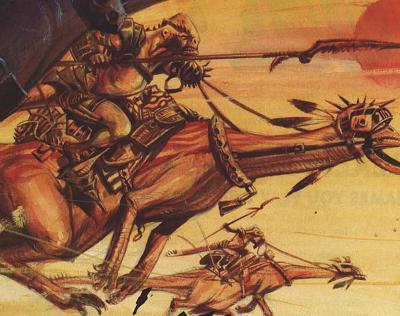
Saurian shifters owe their ancestry to humans and natural lycanthropes who possessed the ability to take on dinosaur forms. This reptilian race cannot assume full dinosaur forms as their lycanthrope cousins, but they can still manifest savage saurian features through a change they call "shifting."
Few know much about the history of saurian shifters, whether members of that race or the particularly brave scholars of others. Yet, what the race lacks in knowledge about their origins they make up for in legend and deeply rooted belief. According to their lore, saurian shifters are the survivors of an abyssal calamity that wracked a distant island now known only as the Isle of Dread. Surrounded by jagged reefs and populated by fierce creatures found nowhere else in the world, the legendary island nurtured an untamed yet bountiful jungle paradise. The ancestors of saurian shifters came to dwell on this island and grew prosperous, erecting a great city known as Thanaclan.
Although the specifics of the tragedy that led to Thanaclan's downfall remain a mystery, saurian shifters tell of horrors from the sea arising to taint the entire island with unnatural powers. Perverting many of the jungle's creatures into gigantic, ravaging beasts, this taint affected many of the people of Thanaclan as well. For some, this meant transformation into a variety of foul abominations, while others became merged with the new brutal creatures of the island. These unfortunate survivors of Thanaclan, forced to share their forms with the rapacious instincts of unnaturally created dinosaurs, became the first saurian shifters.
Many of the newly formed saurian shifters were overwhelmed by their nascent reptilian instincts, rampaging into the jungles and becoming little more than animals themselves. Others joined to form barbaric societies that also moved deep into the most hidden vales of the island's dense jungles. Inspired by their new animalistic blood, these reclusive tribes came to revere the great dinosaurs they now called kin. As far as any know, they continue their bloody worship to this day.
The few saurian shifters who refused to fall into savagery fled the island and scattered throughout the world, attempting to find refuge among the peoples and countries they discovered. Fearful of the saurian shifters' monstrous changes, those outsiders the refugees encountered saw them only as freaks and monsters. Thus, saurian shifters live by hiding among races that would fear and revile them should their secrets be revealed. Yet, although they conceal themselves now, all saurian shifters know the tales of the ancient island of their origins and dream of one day reclaiming it as a homeland of their own.
Saurian shifters are a unique race that breeds true. When they breed with normal humans, they produce human offspring; on rare occasions, however, if two such children (or even grand-children) meet and produce children of their own, they sometimes give birth to saurian shifters.
Personality: Saurian shifters realize that most other races perceive them as nothing more than particularly monstrous lycanthropes, and that their transformations inspire nothing less than abject terror in those races. As such. they remain a secretive, even paranoid people who raise their children to hide their abilities from others.
The reptilian heritages of saurian shifters often color their personalities. Those of predatory blood tend to act quickly and aggressively, with a savagery that shames even the most feral lycanthropes, while those who descend from herbivores exhibit stubborn, defensive natures. Saurian shifters descended from omnivores commonly display the most socially acceptable balance of traits.
Physical Description: A saurian shifter's reptilian heritage significantly influences his appearance. Ranging from 5 to 7 feet tall, with little appreciable difference between the builds of males and females, saurian shifters often exhibit ophidian pupils, skin of faintly reptilian shades, and extensive tattoolike bodily markings. Members of this race possess nearly hairless bodies, the thin and short hair that grows on their heads being the only exception. However, what hair they do grow is often brightly colored and frequently displays stripes and tufts of wild, contrasting colors ranging from normal human shades to wild reds, oranges, and violets.
When they shift, saurian shifters might exhibit a host of changes, growing long hard spines, elongated limbs, curved reptilian teeth, or any of countless other lizardlike features. This change is so pronounced that it's impossible to hide and often terrifies those unfamiliar with the race (and sometimes even those who know what to expect).
Relations: Saurian shifters make most members of other races incredibly uncomfortable. Seeming too much like lycanthropes for most peoples' comfort and possessing the terrifying ability to transform into what most others view as nightmarish monsters, fear often keeps even the best-intentioned outsiders at bay. As such, saurian shifters frequently hide their heritage, dying their hair or claiming to be descended from either mammalian shifters (if they exist) or even orcs. Although they find such lies demeaning at best, those who hope to blend in with the societies of other races often discover that even orcs find acceptance more readily than their people.
Saurian shifters find friendship among half-elves and half-orcs, both races understanding the prejudice of other races. intelligent reptiles also often prove quite friendly to saurian shifters, seeing them as distant cousins. Oddly enough, saurian shifters feel a deep hatred for yuan-ti and the aquatic abominations called koprus.
Alignment: As a race with strong ties to nature, saurian shifters tend toward neutrality. However, as individuals, their alignments are often influenced by the presence of predatory blood in their veins. Those saurian shifters descended from particularly savage hunters often find their reptilian instinct and quick tempers make them ill suited to the mewling complaints of law-abiding creatures, favoring a more chaotic view of "might makes right." On the other hand, saurian shifters descended from herbivores and omnivores tend to be much more even tempered. blending into societies and taking on a range of alignments with little instinctual complaint.
Saurian Shifter Lands: Saurian shifters lack a true homeland, most living secret lives among members of other races. Those who turn to adventuring sometimes seek the mysterious island that legend says their lycanthrope ancestors came from. Small settlements made up entirely of saurian shifters sometimes exist on the edge of civilization, supporting themselves through hunting and trade, but generally remaining aloof from other races. Outsiders who pass through such settlements regularly leave unharmed, but always feel uneasy while there and seldom return.
Religion: Saurian shifters tend to worship draconic deities, to whom they feel a distant kinship, as well as the reptilian deities of other races. Bahamut and Tiamat accept many saurian shifter followers, as do neutral gods who preach a dogma of acceptance and perseverance under oppression. The dinosaur god, Ka, would also be a perfect patron for any saurian shifter.
Languages: When living in seclusion, saurian shifters speak Draconic, although they understand the need to know Common in order to pass themselves off as humans. Saurian shifters speak Draconic with a thick accent that distinguishes it from the speech of lizardfolk or scholars. Dragons often recognize this subtle difference as an ancient dialect of the language and treat saurian shifters with greater respect accordingly.
Names: Saurian shifters usually acquire two names. At birth their parents choose a short human name from those commonly used in the area. Upon becoming an adult, a saurian shifter creates a new, formal name in Draconic that usually reflects his ancestry or an important event in his life. Most saurian shifters continue to use their common name around non-shifters, but use their favored Draconic name with others of their kind or those who understand that language.
Translated Draconic Names: Drillhorn, Farflyer, Goretooth, Grayseek, Hollydawn, Maimaxe, Shatterspine, Widefoot, Wyrmfell.
Adventurers: Saurian shifters often feel out of place and adventure to make their own way in the world. They seek the company of others like themselves - those of mixed blood or with a magical lineage. A few search for evidence of their ancient homeland or seek out normal dinosaurs in the hopes of reawakening some ancient bond. Some, primarily predators. travel for no other reason than to sate their ever-present thirst for the hunt.
SAURIAN SHIFTER RACIAL TRAITS
-
+2 Constitution, -2 Intelligence, -2 Charisma: Saurian shifters are hearty and resilient, but their inherent reptilian nature detracts from both their reasoning ability and their social interaction.
-
Reptilian and Shapechanger Subtypes: Saurian shifters are humanoids with both the reptilian and shapechanger subtypes.
-
Medium: As Medium creatures, saurian shifters have no special bonuses or penalties due to their size.
-
Saurian shifter base land speed is 30 feet.
-
Low-Light Vision: Saurian shifters can see twice as far as a human in starlight, moonlight, torchlight, and similar conditions of poor illumination. They retain the ability to distinguish color and detail under these conditions.
-
Shifting (Su): A saurian shifter can tap into his lycanthrope heritage to gain short bursts of physical power. Once per day, a saurian shifter can enter a state that is superficially similar to a barbarian's rage. Each saurian shifter has one of the following shifter traits - characteristics that manifest themselves when a character is shifting. Each shifter trait provides a +2 bonus to one of the character's physical ability scores (Strength, Dexterity, or Constitution) and grants some other advantage as well. In addition to a number of common shifter traits, several unique to saurian shifters are described in the following section.
Shifting is a free action and lasts for a number of rounds equal to 3 + the saurian shifter's Constitution modifier. (If a shifter trait or other effect increases the character's Con modifier, use the newly improved modifier). A saurian shifter can take feats to improve this ability.
Shifting, although related to and developed from lycanthropy, is neither an affliction nor a curse. It is not passed on by bite or claw attacks, and a saurian shifter can't be cured - shifting is a natural ability for the race.
-
+2 racial bonus on Balance, Climb, and Jump checks: A saurian shifter's reptilian heritage enhances many of his physical skills.
-
Automatic Languages: Common, Draconic. Bonus Languages: Elven, Gnome, Halfling, and Sylvan.
-
Favored Class: Ranger. A multiclass saurian shifter's ranger class doesn't count when determining whether he takes an experience point penalty for multiclassing.
SAURIAN SHIFTER TRAITS
Each saurian shifter receives one of the following special traits, which is selected when the character is created and cannot be changed thereafter.
Beasthide (Su): While shifting, a beasthide saurian shifter gains a +2 bonus to Constitution and thick skin that provides a +2 natural armor bonus.
Broadwing (Su): While shifting, a broadwing saurian shifter gains a +2 bonus to Dexterity and can slow his descent while falling. A shifter using this ability takes damage from a fall as if it were 40 feet shorter than it actually is.
Junglerunner (Su): While shifting, a junglerunner saurian shifter gains a +2 bonus to Dexterity and increases his base land speed by 20 feet.
Longtooth (Su): While shifting, a longtooth saurian shifter gains a +2 bonus to Strength and grows fangs that can be used as a natural weapon, dealing 1d6 points of damage (plus an additional +1 for every four character levels he has) with a successful bite attack. He cannot attack more than once per round with his bite, even if his base attack bonus is high enough to give him multiple attacks. He can use his bite as a secondary attack (taking a -5 penalty on his attack roll) while wielding a weapon.
Raptorleap (Su): While shifting, a saurian shifter gains a +2 bonus to Strength, a +4 bonus on Jump checks, and he treats all Jump checks as though he had a running start.
Razorclaw (Su): While shifting, a razorclaw saurian shifter gains a +2 bonus to Strength and grows claws that can be used as natural weapons. These claws deal 1d4 points of damage (plus an additional +1 for every four character levels he has) with each successful attack. He can attack with one claw as a standard action or with two claws as a full attack action (as a primary natural weapon). He cannot attack more than once per round with a single claw, even if his base attack bonus is high enough to give him multiple attacks. He can attack with a claw as a light off-hand weapon while wielding a weapon in his primary hand, but all his attacks in that round suffers a -2 penalty.
Widetail (Su): While shifting, a widetail saurian shifter gains a +2 bonus to Constitution and grows a thick tail that can be used a natural weapon, dealing 1d6 points of bludgeoning damage (plus an additional +1 for every four character levels he has) with a successful tail slap attack. He cannot attack more than once per round with his tail slap, even if his base attack bonus is high enough to give him multiple attacks. He can use his tail slap as a secondary attack (taking a -5 penalty on his attack roll) while wielding a weapon.
UMBRAGEN
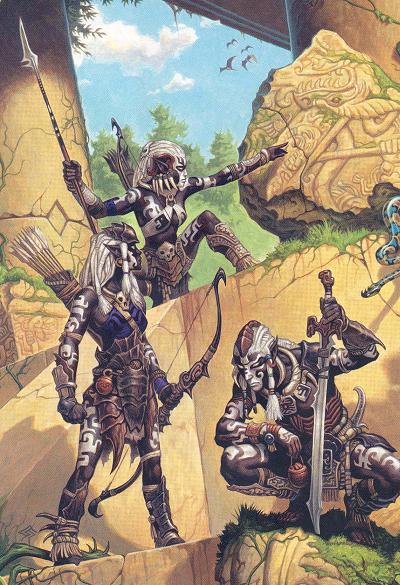
In the Eberron campaign setting, the drow reside on the shattered continent of Xen'drik. The common image of the Xen'drik drow is one of a tribal hunter wearing chitin armor, his skin ritually scarred by acidic venom. Cruel and cunning, these nomadic drow are deadly hunters who owns the shadows of Xen'drik and prey on giant and humanoid alike.
While the majority of the drow of Xen'drik live in tribes, there are exceptions - elves who have held onto the arcane secrets of the past, using them to develop strange new spells. The computer game Dragonshard reveals one of these hidden sects: the umbragen, also known as shadow elves.
The umbragen are an offshoot of the drow race twisted by generations of arcane experimentation and devotion to the powers of shadow.
Tens of thousands of years ago, elves were the slaves of the giants of Xen'drik. Elven legends claim that giant wizards created the drow by harnessing the essence of night and binding it to an elven frame. While this might be nothing more than myth, some drow did serve the giants during the great uprising, using stealth to penetrate the elven strongholds that the massive giants could never breach. While the majority of the drow fought the giants or simply sought to avoid the conflict entirely, the treachery of few turned the wider elven population against the dark elves. Even then, the drow were regarded with fear and distrust, and when the ancestors of the Aereni fled the dark eves were left to face the doom of Xen'drik alone. Soon the dragons came to Xen'drik, and the civilization of the giants fell in a blaze of dragonfire and mystical power. Hundreds of thousands died in the conflict, and the land was twisted by magical forces that modern wizards have yet to understand.
The ancestors of the umbragen escaped the worst of this cataclysm by fleeing beneath the surface of the world, delving into the realm of Khyber, the Dragon Below. The underworld was filled with its own terrors, but nothing so deadly as the final battles between giant and dragon. After a long and dangerous journey one tribe found sanctuary beneath a region known as the Ring of Storms. This subterranean fortress had been constructed and later abandoned by the Qabalrin, an isolated clan of elves whose power matched the mightiest giants. The Qabalrin were long dead when the tribe arrived - struck down in a disaster that some called divine vengeance - but their works remained.
Life in Khyber remained a constant struggle. Aberrations howled at the gates, while famine and plague ravaged the tribe as they fought to adapt to subterranean life. Searching for tools to aid in their struggle for survival, the tribe discovered a set of Qabalrin mystical inscriptions. These writings revealed ways to tap into a vast force of spiritual energy - a dark well the elves called the Umbra. Over the course of generations, the elves performed terrible arcane rituals that bound body and soul to the Umbra, blending this shadowy force with elven flesh. From this point on, they were drow no more: they were the umbragen, shadow elves, the children of darkness.
The horrors of the underworld remained and the umbragen never knew peace. Deep within their cavern fortress the elders continued to plumb the secrets of the darkness, searching for ways to increase the power of their race. The concept of returning to the surface never occurred to them; the legends of the surface world were filled with slavery, war, and betrayal. Eventually, however, it became the only option. While the history of the umbragen was one of constant conflict, this usually involved random attacks by disorganized monsters. In 997 YK, a new force rose in the underworld. A daelkyr lord had stirred in the depths and the umbragen found themselves besieged by a disciplined force of beholders, mind flayers, and lesser aberrations. It is a vicious struggle and so far the shadow elves have been able to hold the aberrations at bay, but it is a losing battle. Recently, umbragen forces have been sent to the surface world, seeking any sort of weapon or power that might drive the aberrations back into the depths of Khyber. The umbragen fled one battle and they don't intend to be driven from their second home.
Personality: A shadow elf has the personality of a predator. His fellow umbragen are his allies in the hunt, and they alone have his respect and loyalty. All other creatures are potential prey, unworthy of respect or pity. With this in mind, the shadow elf is always searching for ways to turn a situation to his advantage or to exploit weakness in a foe.
While he is ruthlessly efficient when required, if given the opportunity a shadow elf prefers to play with his prey. Conflict is the one pleasure of the umbragen, and a shadow elf would rather lead an opponent into an ambush than kill him outright. The umbragen are not fools however, and refuse to throw away victory for a fool's game. If the odds are even, a shadow elf draws out the conflict to savor the victory.
Umbragen society is split into two paths: the Council of War and the Vault of Shadows, with a king who sits on both councils. Those who follow the path of war battle on the front lines while the students of the Vault search for ways to increase the mystical power of the race. Rank is earned through conflict, and any leader - even the king - can be challenged by a direct subordinate. These ascendancy duels take on many different forms of challenge, as there is more to being a general than skill at arms and the strongest fighter is not necessarily the best commander. While it might seem that this policy would create a very chaotic society, challenges are relatively rare. Leaders hold their positions by maintaining the respect of the people, and only an incompetent leader risks being challenged. Rank is not a matter of personal ego - it is a question of who can ensure the survival of the race, and true leaders are revered and valued by those beneath them.
Physical Description: Shadow elves have jet black skin, pale hair, and slender elven builds. At a distance, umbragen are indistinguishable from drow, but up close, a few distinctive features become visible. The eyes of a shadow elf are pure black, with no iris or white, while the skin of the umbragen has an oily gleam, almost as if liquid shadow was flowing across their skin.
Alignment: As a race, the umbragen tend to be lawful evil. The believe that order and discipline is vital to the continued survival of their race, and they are willing to do anything in the pursuit of this goal. They expect treachery from other creatures and thus feel no remorse for actions they take against their enemies (or temporary allies).
Dragonmarks: Umbragen do not possess dragonmarks.
Religion: The shadow elves believe that the Umbra slowly devours the soul of everything it touches, including the umbragen themselves. Those who are closest to the Umbra become colder and more ruthless as their dark powers grow. To the umbragen, the exchange of power for their souls is a fair one and the people respect this sacrifice. Most umbragen rulers possess the Dark Blood feat.
An outside observer might come to the conclusion that these elves worship the Shadow, which is true in a sense. Umbragen clerics should use the listing for the Shadow to determine their domains.
Language: The umbragen speak Elven. However, they have been separated from the Aereni for tens of thousands of years and their use of the elven tongue has drifted over those years. When umbragen first encounter elves of other cultures, the DM might want to require a DC 5 Intelligence check to understand the full meaning of a statement. However, after a brief period the speakers learn to bridge this gap. Umbragen also learn Undercommon as a result of their long conflict with the creatures of Khyber. The Common tongue has never been a part of their culture and an umbragen who selects this as a bonus language has presumably made contact with explorers from Khorvaire.
Names: A shadow elf begins life with a simple birth name. These are typically monosyllabic, reminiscent of changeling naming patterns. When the elf embraces the Umbra - represented by acquiring an umbragen racial feat or a level in one of the classes linked to the shadows - he chooses his final name.
Male Names: Dulos, Hulaje, Jalaen, Satros, Turaje.
Female Names: Delake, Haeri, Mekali, Solake, Ulari.
Adventurers: The majority of umbragen encountered in the world are searching for weapons to use in the war against the forces of Khyber: powerful artifacts, forgotten spells, or anything else that could turn the tide. To find what they seek they also need to learn about the surface world. A group might encounter an umbragen agent who is simply gathering information about the people and cultures of the world above. There are also a few shadow elves who have abandoned the conflict of their people, choosing to seize a place among the soft people of the upper world instead of battling the endless hordes of Khyber.
UMBRAGEN RACIAL TRAITS
Umbragen are drow elves. What makes the umbragen unique is their bond to shadow, reflected by racial feats. Except where noted below, umbragen possess all of the racial traits of drow elves:
-
+2 racial bonus on Hide and Move Silently checks. This replaces the drow bonus to saving throws against spells and spell-like effects.
-
Weapon Proficiencies: Longbow, shortbow, longsword, and rapier. These replace the standard drow weapon proficiencies.
-
Automatic Languages: Elven, Undercommon. Bonus Languages: Common, Draconic, Giant, and Terran.
-
Favored Class: Warlock.
GIFF
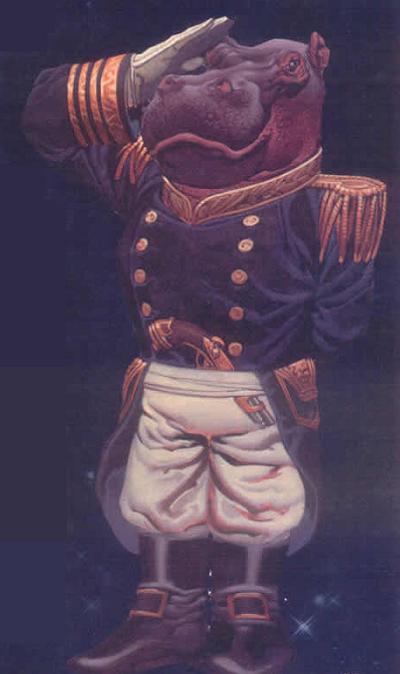
Blustering humanoid hippopotami, the giff wander Wildspace in search of a good fight. They find ready employ as mercenaries.
Personality: The giff are not so much a warrior race as a soldiering race. Giff communities organize themselves in a chain of command, freely borrowing grandiose ranks and titles from races they encounter. Giff society is built upon discipline and hierarchy, but they harbor no imperial ambitions. In fact, they care little for land - theirs or anyone else's. Nor do they care for money, preferring payment in what they really value, such as food, weapons, and - especially - explosives. The bigger the explosion, the better they like it.
For all their love of ostentation and arms, giff remain intensely orderly creatures. A giff's word is his bond, with one exception - giff refuse to fight other giff, no matter how well paid either platoon might be.
Physical Description: A giff resembles an anthropomorphic hippopotamus - a gray, broad and seemingly clumsy creature. Shorter than an ogre but much more massive, a giff's bulk disguises quick reflexes and surprising grace. Although herbivorous, giff possess powerful tusks and iron-muscled arms.
Giff would appear terrifying to most races if not for their fashions. Giff demand spit-and-polish military garb, and take this to such an extreme of ostentation as to border on the absurd. No one doubts the bravery or ferocity of the giff and those who know their predilections know to keep a safe distance from them, but few are intimidated by an 8-foot-tall humanoid hippopotamus who hides the entirety of his plate armor beneath a mess of campaign ribbons.
Relations: Giff see other races in one of two ways: as employers or troublemakers. Mercenary to the core, the giff follow orders to the letter. As such, quite without knowing it, they often end up on what most humanoids would describe as the wrong side, fighting alongside ilithids, scro, or - worst of all - escorting the avian dowhar to new markets.
Although the origin of the giff attraction to firearms is unknown, their desire for the weapons has only grown over the years. Hippofolk adore them to distraction, and a distracted giff is dangerous indeed. Employers who promise a giff platoon a steady supply of blackpowder acquire fanatically loyal mercenaries, but a few giff can bankrupt anyone unwise enough to make the offer. A giff prefers to carry as many pistols, blunderbusses, and muskets as his mighty frame can handle.
Alignment: Despite their love of explosive weaponry, giff remain resolutely lawful. Their structured and intensely stratified society, deep-seated sense of honor, and total obedience ensure that few giff ever show even a trace of chaotic behavior (aside from almost childlike joy at loud and colorful explosions). Few giff are either good or evil - they just follow orders.
Giff Lands: The giff travel Wildspace and the planets in it, forever selling their services to the highest bidder. Aside from the occasional shipwrecked castaway, giff neither settle down nor stop to admire the scenery. No living giff recalls his race's homeworld, spoken of now only in legend.
Religion: The giff possess no actual religion of their own - perhaps they lost it with their homeworld. Giff adopt the worship of whatever war deities their employers venerate. In addition, giff hold to a quasi-mystical deism, claiming that all things have a purpose in the world and that the purpose of giff is to follow orders.
Language: Giff speak their own language, a gruff, blustery tongue full of bellowing lows and trumpeting highs. Most giff also speak Common to better negotiate for gunpowder and other necessities.
Names: Giff use names in the Common tongue, as their native names are either unpronounceable or forgotten. They generally deal directly with wealthy employer's and have adopted upper-class common names to garner respect. Gill have somewhat unconventional tastes, and many of these names are uncommon even among the aristocratic and merchant classes.
Male Names: Algernon, Bertram, Cordell, Eustace, Horatio, Trenton.
Female Names: Beatrice, Dora, Isabella, Louisa, Ophelia.
Family Names: Cartwright, Galloway, Hadley, Kilburn, Upton.
Adventurers: Giff love to travel, love to fight, and love to find new and interesting weapons. As such, they make natural adventurers. On the other hand, many giff prefer to remain in the regimented and familiar company of their own kind.
Most giff adventurers hail from devastated platoons. Considering giff tactics, these orphans are a relatively common occurence. The giff who survive them find adventuring work comparatively easy. Other giff adventure under orders - giff platoons try their best regardless of the mission, and some missions send individual giff far from their platoons and others of their kind.
GIFF RACIAL TRAITS
-
+8 Strength, +4 Constitution, -2 Intelligence, -4 Wisdom: Foolhardy and far from bright, the giff make up what they lose in brainpower with size and sheer endurance.
-
Medium: As Medium creatures, giff have no special bonuses or penalties due to size.
-
Giff base land speed is 30 feet.
-
Racial Hit Dice: A giff begins with two levels of monstrous humanoid, which provide 2d8 Hit Dice, a base attack bonus of +2, and base saving throw bonuses of Fort +0, Ref +3, and Will +3.
-
Racial Skills: A giff's monstrous humanoid levels give it skill points equal to 5 × (2 + Int modifier, minimum 1). Its class skills are Intimidate, Jump, Knowledge (local), Listen, Spot, and Swim.
-
Powerfid Build: The physical stature of a giff lets him function in many ways as if he were one size category larger. Whenever a giff is subject to a size modifier or special size modifier for an opposed check (such as during grapples, bull rush attempts, and trip attempts), the giff is treated as one size category larger if doing so is advantageous to him. A giff is also considered one size category larger when determining whether a creature's special attacks based on size (such as improved grab or swallow whole) can affect it. Giff can use weapons designed for a creature one size category larger without penalty. However, its space and reach remain those of a creature of its actual size. The benefits of this characteristic stack with the effects of powers, abilities, and spells that change the subject's size category.
-
Exotic Weapon Proficiency (firearms): Giff culture prizes gunpowder weapons. As such, all giff learn how to use these items and gain this feat as a bonus feat.
-
Automatic Languages: Common and Giff. Bonus Languages: Dowhar, Dwarven, Gnome, Scro, Undercommon. The giff tend to learn the languages of those who employ them.
-
Favored Class: Fighter. Giff love to fight, train to fight, and live to fight. Unsurprisingly, they're very good at it.
-
Level Adjustment: +3.
INSECTARE
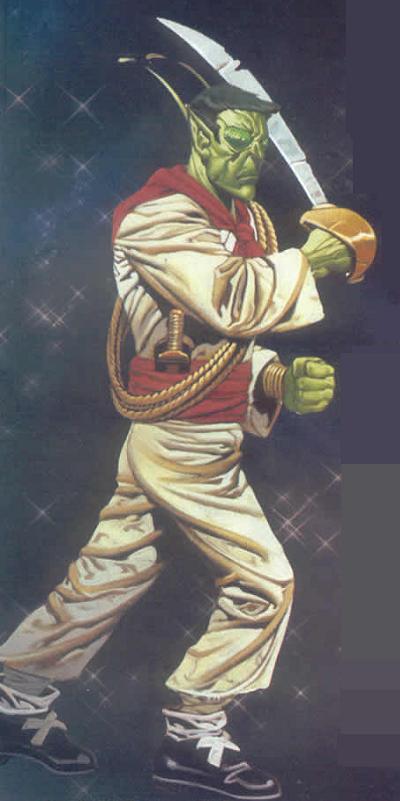
Humanoids whose ancestry appears equal parts elven and insectoid, the insectare present a small but growing threat to spelljamming life. These enigmatic creatures attempt to manipulate others and acquire magical knowledge, possessing great skill at both tasks, as evidenced by their ever-increasing power.
Personality: Insectare appear insular and icy to most outsiders. Their faces and voices offer little hint into their feelings. While most insectare encountered away from their homeworld are spies and infiltrators, their racial reticence springs from a different source - among their own kind, they express emotion by direct empathy, using their antennae.
Insectare possess a full range of emotions, although some may seem alien to ordinary humanoids. An insectare thinks of his entire race like a human or elf would his family, with the divine Klikral as the direct head of the house. This creates a very strong sense of loyalty, but also an adversarial outlook toward anyone so alien as to be outside the family.
Physical Description: In the face and extremities, Insectare resemble tall, green-skinned elves. Their most distinguishing features rise from behind their elven ears - a pair of antennae. Their lean torso, almost always hidden by robes or armor, sports a carapace of chitin plates. Insectare travel in disguise. Most pose as elves, using dyes and makeup to disguise their lime-green flesh while wearing heavy cloaks to conceal their antennae.
Close inspection of an insectare's eyes reveals their apparently normal green orbs to be multifaceted like an insect's. However, for reasons unknown to even the wisest sages, members of the insectare priest caste possess ordinary eyes.
Relations: Few races trust the insectare, and if they knew half of what these insectoid schemers planned, they would trust them even less. Knowing that their plans for domination mesh poorly with the aims of others, and that they currently lack the numbers to dominate, most insectare travelers disguise themselves and keep to the shadows, letting others think them elves or even humans.
Elves hate and despise the insectare, vehemently denying their apparent connections. This has done nothing to endear insectare to goblinoids and orcs, particularly scro, who consider them just another elven menace to annihilate.
Alignment: The insectare scheme to dominate all life, the racial goal to which they hope their extensive arcane research can lead. They possess a strong inclination toward evil, but an even stronger one to law.
Insectare Lands: Huge mountains and vast forests dominate the secluded insectare homeworld. They feel most comfortable in underground areas similar to the hollow structures carved directly from their native mountains, hivelike citadels extending as deep as dwarven cities. In the open vastness of Wildspace, insectare often gravitate toward regions controlled by dwarves because of this propensity for underground living.
Religion: Insectare worship Klikral, a lawful evil godlike entity physically inhabiting their homeworld. They guard the secrets of their worship even more jealously than the rest of their culture; a hundred insectare would die (or kill countless thousands of other humanoids) to protect their religious secrets. Insectare infiltrators often pretend worship of other devotions, a ruse Klikral apparently approves of.
Language: Insectare speak their own language, a mix of clicks, whirs, and Common words. They also speak Common. Many, finding it easier to pose as elves than as humans, learn to speak Elven.
Names: Insectare tend to adopt myriad pseudonyms during their secretive missions. They need no personal designations among their own kind due to their limited ability to communicate empathically. An insectares "name" usually reflects the naming conventions of the region he is currently infiltrating.
Adventurers: Insectare adventurers usually serve their race. Since they desire magical knowledge new and old, adventurers make a point of seeking out ruins and dungeons full of ancient lore. Insectare find it convenient to accompany other humanoids on these expeditions.
Insectare adventurers attempt to earn the trust of their companions, but no insectare reciprocates trust. Most try to hide their true natures as long as possible, and some prefer to kill anyone - ally or enemy - who discerns their identities. Even a known insectare tends to keep to himself preferring discretion and privacy over friendship.
INSECTARE RACIAL TRAITS
-
+2 Dexterity, -2 Constitution, +2 Intelligence, +2 Charisma: Insectare suffer from few weaknesses and pride themselves on their quickness of mind and body. Their intense personalities overpower most other beings.
-
Medium: As Medium creatures, insectare have no special bonuses or penalties due to size.
-
Insectare base land speed is 30 feet.
-
Darkvision: Darkvision out to 60 feet. Darkvision is black and white only, but it is otherwise just like normal sight, an insectare can function just fine with no light at all.
-
Natural Weapons (antenna rake): An insectare can make two attacks with his antennae each round, treating them as an off-hand weapon with all the associated penalties. These attacks deal 1d4 points of slashing damage plus one-half the insectare's Strength bonus. An insectare can instead attack with only a single antenna as an attack action at his normal bonus.
-
+2 natural armor bonus: The chitin plates on an insectare's body grant him superior natural defenses.
-
+2 racial bonus on Bluff and Disguise checks: Insectare possess a talent for deception and take great pains to keep their nature hidden.
-
Elven Blood: For all effects related to race, an insectare is considered an elf.
-
Automatic Languages: Common and Insectare. Bonus Languages: Any. Insectare actively learn the languages of those they hope to subvert and dominate.
-
Favored Class: Spellthief. Insectare cast spells naturally, drawing power from their arcane ancestry. They constantly seek new spells, which are somehow absorbed into future bloodlines and eventually learned by other insectare.
-
Level Adjustment: +1.
SCRO
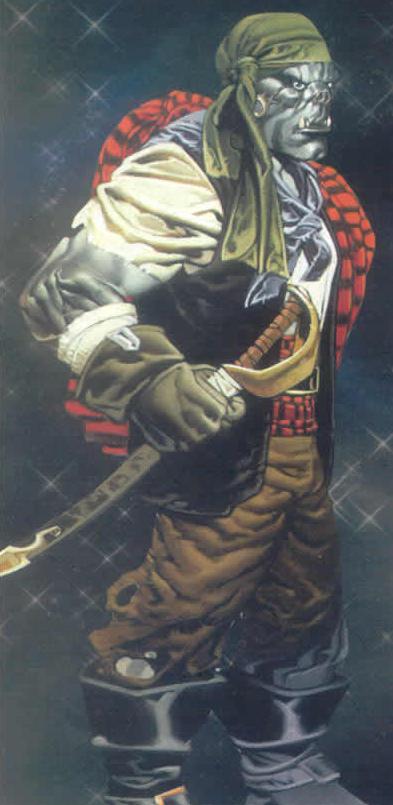
Advanced orcs from a distant sphere, scro are consummate warriors, adept at fighting alone against overwhelming odds, in close formation with similarly trained companions, or in command of less disciplined allies. Feared but grudgingly respected by their enemies, the scro have few friends outside their own kind.
Personality: Scro are aggressive and intense by nature, but their iron discipline keeps their emotions well hidden beneath a cool exterior. Scro often seem unfeeling because of their ability to coldly analyze their situation, but inside every scro seethes a frenzied orc only barely suppressed by culture and breeding.
Among their own kind, the scro maintain a rigid chain of command with a mix of respect, admiration, and fear. Unlike most evil creatures, the typical scro is selfless, self-disciplined, and focused on the greater good of his kind.
Physical Description: Scro resemble ordinary orcs in their brutish features, sharp tusklike teeth, and formidable physiques, although a scro usually stands taller (between 6 and 8 feet tall) and ramrod straight. Scro display a wide range of skin colors, ranging from jet black to albino white, but otherwise vary little in outward appearance.
Regardless, seeing even a lone scro in action dispels any illusions that those of his race are merely orec: Scro take great pride in their armor and weapons, although most specialize in unarmed combat. A scro moves with astonishing discipline and complete control, carefully and astutely picking apart his opponents.
Relations: The typical scro despises all other humanoids. Waging a genocidal war against the hated elves, the scro loathe all non-goblinoid and non-orc races and see little use for such kin outside of cannon fodder. Non-humanoids, such as dragons and beholders, pose a serious threat the scro prefer to avoid.
Scro show tact and decorum when they encounter other races in a social setting. Much like their ancestral foes, the elves, they prefer to demonstrate their superiority by not lowering themselves to the level of other beings. On the other hand, scro liberally pepper their battle cries with fantastically creative insults calculated to goad opponents into a mistake.
Alignment: Generations of regimentation and discipline beat ancestral orc anarchy out of the scro race, leaving the survivors almost exclusively lawful. The scro show far less interest in conquering their tendencies toward brutality and viciousness, so most remain evil.
Scro Lands: Aside from their distant homeworld, the scro prefer the rigors of Wildspace to any groundling terrain. When forced to ground, scro favor no particular climate or terrain, provided they can find ways to gain a tactical advantage from it. Scro fortify their homes, but lay fewer traps than most orcs and goblinoids.
Religion: After elven victory in the Unhuman War, the ancestors of the scro abandoned worship of the orc pantheon. The modern scro war-priest devotes himself to martial perfection and self-discipline. Scro tradition commands war-priests to multiclass as arcane spellcasters, and most become mystic theurges. Ordinary scro participate in few public rituals, but most privately follow a similar - albeit less ascetic - course of self-discipline.
Language: Scro speak a language derived from Orc. Anyone who speaks Orc grasps the basics of Scro, although the more refined tongue boasts nearly three times the vocabulary and a much greater range of expression. On the other hand, someone who learns to speak Scro understands Orc - probably better than most orcs. In addition, most scro speak Common, to better interact with the races of Wildspace, and Elven, to taunt and debase their ancestral foes.
Names: Scro use longer, more complex orc names. Scro prefer hero names to descriptive names. Since almost all ancestral orc heroes were male and the scro insist on total militarization, female scro usually have feminine suffixes attached to orcish masculine names - a practice which orcs find disconcerting.
Male Names: Dukgash, Horageth, Kagedmakh, Skalkash, Thokmakh, Varvageth.
Female Names: Dukgashia, Horagethim, Kagedmakhia, Skalkashev, Thokmakhim, Varvagethim.
Family Names: Scro use rank, unit, and clan desiguations rather than family names. Clan names honor the clan's founder, usually an ancient orc or more recent scro who earned leadership of a full clan by some extraordinary exploit. The orc suffix "-ulak," meaning "the hero's," is thus applied to all clan names. Thus, a scro's full name might be Skalkash, Captain, 2nd Company, Dukgashulak.
Adventurers: While the best and brightest of most races typically become their adventuring class, scro adventurers more often than not come from the lowest caste of scro society - those unable, to live up to the rigorous standards of their race.
A scro adventurer might display too many scruples for his kin, or, more commonly, involve himself in disorderly behavior. He might simply lack the physical and mental toughness to survive the scro lifestyle. A principled scro might find a place in his people's society, but a weak or chaotic one counts himself lucky if he faces exile rather than death.
On the other hand, some scro adventurers remain firmly fixed in the scro military machine. These seemingly freelance agents ultimately owe their allegiance to the Ultimate High Overlord, but they serve the scro cause by infiltrating the societies of other races and even acting as mercenaries.
SCRO RACIAL TRAITS
-
+4 Strength, +2 Dexterity, +2 Constitution: Scro possess the best traits of orcs and hobgoblins with few of the drawbacks.
-
Medium: As medium creatures, scro have no special bonuses or penalties due to size.
-
Darkvision: Scro can see in the dark up to 60 feet. Darkvision is black and white only, but it is otherwise just like normal sight, and scro can function just fine with no light at all.
-
Orc Blood: For all effects related to race, scro are considered orcs. Scro, for example, are just as vulnerable to special effects that affect orcs as their ancestors are, and they can use magic items that are usable only by orcs.
-
+1 racial bonus on attack rolls against elves (including drow): From the day they're born, scro learn to hate elves and how to fight them.
-
Automatic Languages: Common and Scro. Bonus Languages: Dwarven, Elven, Giff, Goblin, and Orc. The scro learn the languages they need to perform their duties.
-
Favored Class: Monk. A multiclass scro's monk class does not count when determining whether he takes an XP penalty for multiclassing. Scro believe in iron self-discipline and practice unarmed combat extensively. Most scro, however, are multiclass monk/fighters.
-
Level Adjustment: +2.
PHANATONS
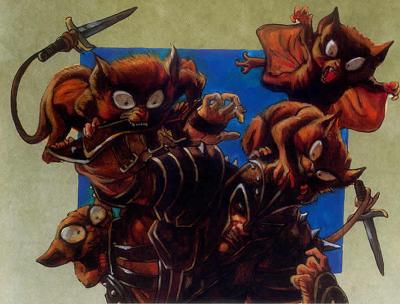
Known to live all across the Isle of Dread are a race of Small creatures that appear to be a cross between a raccoon and a monkey, with gray to brown fir, long prehensile tails and thin membranes stretching between their arms and legs. These creatures, known as phanatons, are not unintelligent animals, as many first assume. They live in small villages high up in the canopy of the jungle, safe from the predators that dwell below. Organized into small clans, the phanatons have kings and war chiefs who make most of the important decisions, while the rest tend to the forest and the needs of the whole.
Phanatons are reclusive and gentle creatures, preferring to be left alone in their forest homes, although they have been known to harry and attack creatures that endanger their homes. They get along with dryads, treants, and elves (especially wood elves), and their only natural enemies are aranea. Phanatons have monkeylike hands with opposable thumbs. Their feet are flexible but not able to handle objects like true hands can. They have prehensile tails which they use to help climb and jump.
Phanatons have large eyes hidden in a mask of darker fur. Their monkeylike hands have opposable thumbs and can be used for a variety of tasks. While their feet are flexible, they cannot be used to carry anything of weight or wield any weapons or shields. The tails of phanatons are almost four-feet long, which they use to assist in jumping and climbing. Phanatons speak their own language of hoots, chatters, and clicks.
Phanatons are omnivores, preferring plant matter but eating meat from time to time; they especially like the taste of spiders.
Because they rarely own metal items, phanatons normally use plant-based weapons they can make themselves, such as clubs, quarterstaves, and nets. Given their elevated homes and their natural quietness, they prefer to ambush enemies from above, using hit-and-run tactics, and melting back into the foliage after a few attacks.
Phanaton villages are built on wooden platforms high up in trees. Rope bridges connect the platforms together, and the phanatons tie vines and ropes around the trunks to facilitate climbing between platforms; their gliding ability allows them to easily drop to lower platforms.
Phanatons enjoy tending the forest around their home, clearing away dead plant matter to protect areas from fire, cultivating their favorite plants, and repairing damage to old trees. They rarely use metal items, lacking the skills and materials to smelt iron and not wanting to endanger their tree-top homes with open flame. They respond to logging incursions by sabotaging equipment and playing harmless but annoying tricks on woodcutters.
While afraid of others at first, phanatons can become quite friendly once a creature has proven that it means no harm to the clan or the nearby forest that sustains it. Some phanatons even agree to travel with other creatures, acting as guides or scouts. As such, phanaton adventurers are not uncommon. Phanatons despise spiders and spiderlike creatures, such as the aranea, attacking them on sight so long the odds are in their favor.
Their society is somewhat patriarchal; their kings and war leaders are traditionally males. Females are normally responsible for tending the young and gathering food, but some females become warriors or leaders and some males choose to take child-rearing duties.
Phanatons worship nature rather than any particular deity, although those with close ties to elven communities sometimes pay homage to the elven pantheon in their devotions. A phanaton cleric has access to two of the following domains: Air, Animal, Earth, or Plant.
PHANATON RACIAL TRAITS
-
-2 Strength. +2 Dexterity, -2 Constitution.
-
Small size. +1 bonus to Armor Class, +1 bonus on attack rolls, +4 bonus on Hide checks, -4 penalty on grapple checks, lifting and carrying limits 3/4 those of Medium characters.
-
A phanaton's base speed is 20 feet.
-
Low-light vision.
-
Natural Weapon: Bite (1d4).
-
Forest Awareness (Ex): Phanatons have an empathic awareness in forests, which gives them a +1 racial bonus on all saving throws in forest locations.
-
Gliding (Ex): A phanaton can use its wings to glide, negating damage from a fall of any height and allowing 20 feet of forward travel for every 5 feet of descent. Phanatons glide at a speed of 20 feet (average maneuverability). Even if a phanaton's maneuverability improves, it can't hover while gliding. A phanaton can't glide while carrying a medium or heavy load. If a phanaton becomes unconscious or helpless while in midair it cannot keep itself aloft and falls.
-
+4 racial bonus on Move Silently checks (+8 in forest areas), +2 racial bonus on Climb, Jump, Listen, and Spot checks.
-
Automatic Languages: Phanaton, Elven. Bonus Languages: Sylvan, Goblin.
-
Favored Class: Rogue.
XVARTS
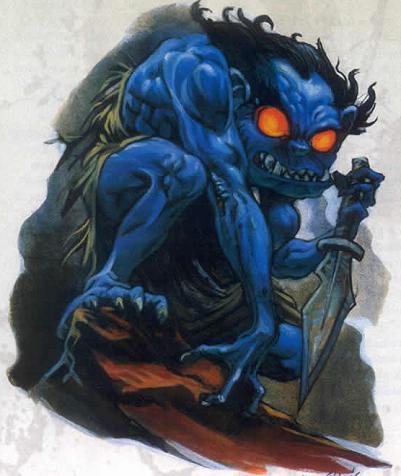
Xvarts are small humanoids living primarily in the Bandit Kingdoms, former lands of the Horned Society, the Bone March, the Pomarj, near Verbobonc, and the Vesve Forest. Although xvarts have a primitive society compared to humans, it serves them well and allows them to support large tribes on limited resources. As a whole they are not a threat to civilization, as they fear humans and prefer to occasionally take out their aggression on kobolds. Goblins often use xvarts as spies for warbands, and xvarts often act as mediaries between goblins and kobolds. Although they are goblin-sized and have other traits in common with goblins, xvarts are not goblinoids.
Xvarts have bright blue skin and vivid orange eyes. Tolerant of most weather extremes, they dress in little more than loose cloth doublets. Xvarts of both sexes are mostly bald, having only a fringe of wiry black hair on the back and sides of the head that connects with their eyebrows and possess large ears. Xvarts claws look impressive but are insufficient for combat, and their teeth are barely larger than those of a human child.
Xvarts prefer to ambush and overwhelm their opponents, resorting to superior numbers instead of fairness. Although they fear humans and only attack them if they have a tremendous edge in numbers, xvarts hate halflings and almost always attack them, even if their numbers are equal.
Xvart officers sometimes have better armor (preferring chain shirts to anything more cumbersome). Sergeants are trained in the use or nets, and other officers learn to use nets or Two-Weapon Fighting with a dagger or another short sword. Hunting parties use scouts to drive prey toward a readied net, and ambushes usually involve at least one net and enough xvarts to pile upon every person in a group.
Xvarts are tribal. Their leaders are generally the strongest and most clever creatures in the tribe. They live in a communal existence, with hunting parties leaving the lair daily to bring back food for the entire tribe. If hunting is poor, they sometimes resort to stealing livestock or crops from farms. They war with enemy humanoids for territory but never with their own kind, preferring to move or eliminate a common foe when the population grows too large. Xvarts rarely raid unless a powerful leader has driven them to a cause, such as avenging many deaths by adventurers or the encroachment of humans. When they take prisoners, it is only for torture and ransom, as the xvarts have little need for laborers.
These creatures live in caves underground or in deep and remote portions of forests. Their camps are well-patrolled by xvarts, bats, and rats, and are kept reasonably clean, particularly when compared to goblins. Often, a tribe is allied with one or more wererats, with the tribe providing shelter in emergencies and the wererats ferrying ransom notes. Xvarts with lycanthropy are greatly respected by their peers. Other tribes form close alliances with goblins, although these pairings never involve worg mounts as the canines tend to eat the xvarts' rat guardians.
Xvarts worship the god Raxivort, who teaches that xvarts will eventually come to dominate and rule all of the small creatures of the world, aided by rat and bat allies and using the tools of fire and the sword as their means to this goal. Xvart clerics can choose two of the following domains: Animal, Chaos, Evil, and Trickery.
XVART RACIAL TRAITS
-
-2 Strength, +2 Dexterity, -2 Charisma.
-
Small size: +1 bonus to Armor Class, +1 bonus on attack rolls, +4 bonus on Hide checks, -4 penalty on grapple checks, lifting and carrying limits 3/4 those of Medium characters.
-
A xvart's base land speed is 30 feet.
-
Darkvision out to 60 feet.
-
Speak With Animals (Sp): Once per day a xvart can use this ability to communicate with bats or rats (including dire forms of these creatures) for 1 minute as if using the speak with animals spell.
-
+2 racial bonus on Move Silently checks.
-
Automatic Languages: Common, Goblin. Bonus Languages: Draconic, Elven, Giant, Gnoll, Orc.
-
Favored Class: Fighter.
NORKERS
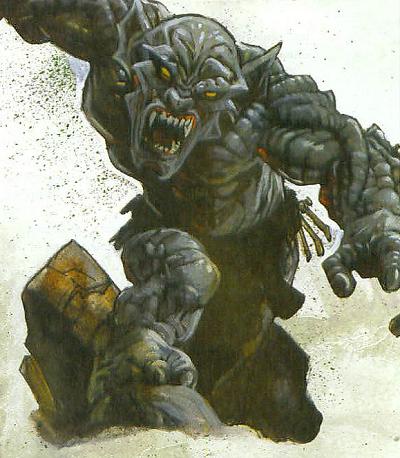
Relatives of goblins and hobgoblins, norkers are goblinoids that forsake armor in favor of their incredibly tough hides. They are unreliable troops and tend to quarrel with each other, which keeps their numbers low compared to goblins.
Norkers resemble goblins, except they have 3-inch-long canine teeth and no hair. Their skin ranges from reddish brown to dark gray. A norker usually wears a loincloth and a belt that it ties its favorite possessions and trophies to.
Norkers enjoy swarming tactics. Their weapons are simple and crudely made, but they are not averse to taking better weapons from their fallen foes. When bullied into submission by hobgoblins they can use basic military tactics, but they lapse into their old ways when not supervised.
Norkers are tribal, although the leader's influence only extends about as far as his reach. This means their tribes are much smaller than a typical goblin tribe. They raid and steal from other humanoids, as they are too lazy do their own hunting.
Their lairs are usually caves, old ruins, or villages taken by conquest. They can't cooperate well enough to build anything more than a fence or short rock wall around their lair, perhaps with a gate and a narrow walkway. A lair has 150% as many adult females and 200% as many young as adult males.
Different tribes of norkers rarely meet, but when they do the conflict often becomes bloody, with the victors taking the fangs of the losers as trophies. These conflicts rarely result in wholesale slaughter, as the leaders' battles establish who is dominant.
When powerful groups of hobgoblins command norkers, they often equip their lesser cousins with scale mail and shields. In these situations, the norkers are used as shock toops, absorbing the brunt of enemy attacks while the hobgoblins use their superior intelligence, tactics, and equipment to break up the enemy forces.
Their clerics worship Maglubiyet, the god of goblins and hobgoblins, and can choose two of the following domains: Chaos, Evil, or Trickery.
NORKER RACIAL TRAITS
-
+2 Dexterity, +2 Constitution, -2 Intelligence, -2 Wisdom, -2 Charisma.
-
Small size: +1 bonus to Armor Class, +1 bonus on attack rolls, +4 bonus on Hide checks, -4 penalty on grapple checks, lifting and carrying limits 3/4 those of Medium characters.
-
A norker's base land speed is 30 feet.
-
Darkvision out to 60 feet.
-
+4 racial bonus on Move Silently checks.
-
+5 natural armor bonus.
-
Natural Weapon: bite (1d4).
-
Automatic Languages: Common, Goblin. Bonus Languages: Draconic, Giant, Gnoll, Orc.
-
Favored Class: Rogue.
-
Level Adjustment: +1.
AZERBLOODS
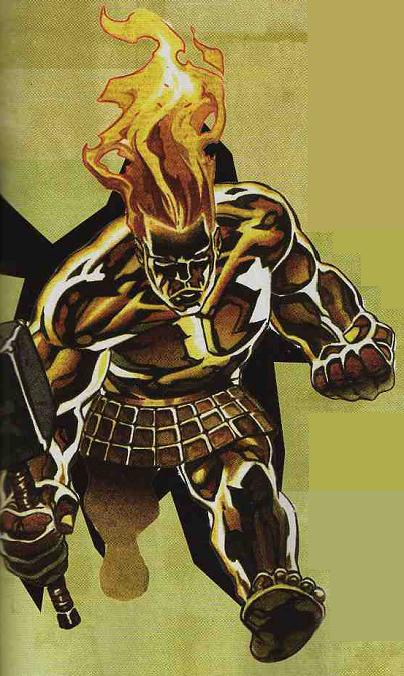
Descended from shield dwarves and azers, azerbloods are generally unfriendly and taciturn, proud and unafraid to take action.
Azerbloods vary widely in their appearance, although in general form they resemble shield dwarves with metallic brass-colored skin, flame-red hair, and irises that appear to dance like tiny flames. They favor little clothing other than azer kilts of brass, bronze, or copper, but they don heavier armor when they expect combat.
Azerbloods are experts in combat, effectively using their environment and executing well-planned group attacks. They often use fire magic in fights, particularly if one or more of their number is a cleric or sorcerer. If they have time to prepare, they might build fire pits or other traps involving burning oil. In addition to the dwarven waraxe and thrown hammer, azerbloods also use warhammers, picks, and spears.
Azerbloods live in small communities, often by themselves in otherwise deserted cave complexes or within larger dwarven cities and enclaves. Azerbloods speak Dwarven and Ignan. Most who travel outside dwarven lands (as traders, mercenaries, or adventurers) also know the Common tongue.
Azerbloods are most common in the Small Teeth mountains of western Amn, as most are members of the remnants of Clan Azerkyn, which once ruled the southern caverns of the Adamant Kingdom of Xothaerin. Individual azerbloods can also be found in shield dwarf clans dwelling in the mountain ranges that lie near the Lake of Steam.
Azerbloods are treated as shield dwarves for purposes of determining available regions. They may also take the Bloodline of Fire feat.
Like their dwarven cousins, azerbloods strongly favor the rule of law and the predictability it provides. From their azer ancestors they gain a level of detachment from the debate of good versus evil.
While they favor Gorm Gulthyn or Dumathoin, azerbloods revere the entire dwarven pantheon.
AZERBLOOD RACIAL TRAITS
-
+2 Strength, +2 Constitution, -2 Charisma.
-
Medium size.
-
Azerblood base land speed is 30 feet.
-
Dwarven Blood: For all special abilities and effects, an azerblood is considered a dwarf
-
Darkvision out to 60 feet.
-
Fire resistance 10.
-
Weapon Familiarity: Azerbloods may treat dwarven waraxes and dwarven urgroshes as martial weapons, rather than exotic weapons.
-
Stability: An azerblood gains a +4 bonus on ability checks made to resist being bull rushed or tripped when standing on the ground (but not when climbing, flying, riding, or otherwise not standing firmly on the ground).
-
+2 racial bonus on saving throws against poison.
-
+2 racial bonus on saving throws against spells and spell-like abilities.
-
+1 racial bonus on attack rolls against mephits (fire, magma, and steam only) and salamanders.
-
+4 dodge bonus to Armor Class against monsters of the giant type.
-
Racial Skills: +2 racial bonus on Appraise checks that are related to fire, stone, or metal items. +2 racial bonus on Craft checks that are related to fire, stone, or metal.
-
Heat metal: An azerblood can cast heat metal once per day. Caster level equal to character level. The save is Charisma-based.
-
Forged: An azerblood gains a +1 bonus on all saving throws against heat and fire spells and effects. This bonus increases by +1 for every five additional levels the azerblood attains.
-
Automatic Languages: Common, Dwarven, Ignan. Bonus Languages: Giant, Gnome, Goblin, Orc, Undercommon.
-
Favored Class: Fighter.
-
Level Adjustment: +1.
CELADRINS
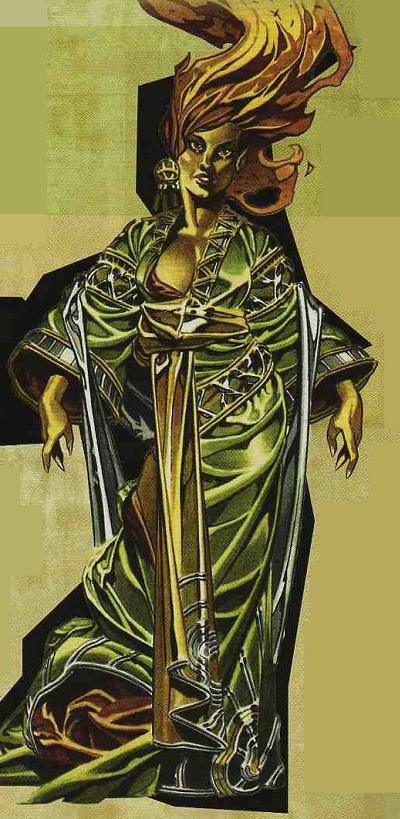
Celadrins are a race of planetouched descended from the unions of elven worshipers of Hanali Celanil and eladrins (usually firre) consummated during summer solstice revels.
Celadrins usually resemble gold elves with flame-red hair, bronze skin, and gold eyes. They favor radiant garments, often diaphanous silks woven with threads of silver and gold.
Celadrins are cautious warriors who take time to analyze their opponents and the location of the fight if at all possible, maximizing their advantages by using ambushes, snipers, and camouflage. They prefer to fire from cover and retreat before they are found, repeating this maneuver until all of their enemies lay dead.
They prefer longbows, shortbows, rapiers, and longswords. In melee, celadrins are graceful and deadly, using complex maneuvers beautiful to observe. Their wizards often use sleep spells during combat because such magic does not affect other elves or celadrins.
Celadrins typically live among gold elves, although some wander the world a few decades before settling down with other types of elves. They speak Celestial and Elven. Most celadrins who travel outside their temples (as guardians or wandering troubadours) learn the Common tongue.
Not uncommon in the forests of Cormanthor, most celadrins trace their ancestry back to the height of Myth Drannor. Since the Weeping War, many celadrins have settled in Deepingdale and the forests surrounding Lake Sember. Celadrins are found in other elven communities where the church of Hanali Celanil plays a prominent role, including Evereska and Evermeet. They are usually strongly associated with the arts, either as craftsmen, performers, or guardians thereof.
Celadrins are treated as gold elves for purposes of determining available regions.
Like full-blooded elves, celadrins enjoy the gentler aspects of freedom and chaos, as represented by the alignment chaotic good.
Celadrins prefer to live in elven communities with prominent temples of Lady Goldheart. Most celadrins venerate Hanali Celanil and honor the rest of the Seldarine.
CELADRIN RACIAL TRAITS
-
+2 Dexterity, -2 Constitution, +2 Charisma.
-
Medium size.
-
Celadrin base land speed is 30 feet.
-
Elven Blood: For all special abilities and effects, a celadrin is considered an elf. Celadrins, for example, can use elven weapons and magic items with racially specific elven powers as if they were elves.
-
Darkvision out to 60 feet.
-
Fire resistance 10.
-
Immunity to sleep spells and effects.
-
Weapon Proficiency: Celadrins are automatically proficient with the longsword, rapier, longbow, composite longbow, shortbow, and composite shortbow.
-
Racial Skills: Celadrins have a +4 racial bonus on Perform (sing) checks and a +2 racial bonus on Listen, Search, and Spot checks. A celadrin who merely passes within 5 feet of a secret or concealed door is entitled to a Search check to notice it as if the were actively looking
-
Fiery Gaze: A celadrin can cast scorching ray once per day. Caster level equals class level.
-
Melodious Voice: A celadrin has a captivating voice, capable of influencing NPC attitudes. A celadrin receives a +1 racial bonus on Diplomacy checks made to influence the attitude of a non-player character or on wild empathy checks made to influence the attitude of an animal or magical beast. This bonus rises to +2 at 5th level, +3 at 10th level, +4 at 15th level, and +5 at 20th level.
-
Automatic Languages: Celestial, Common, Elven. Bonus Languages: Draconic, Gnoll, Gnome, Goblin, Orc, Sylvan
-
Favored Class: Bard.
-
Level Adjustment: +1.
D'HIN
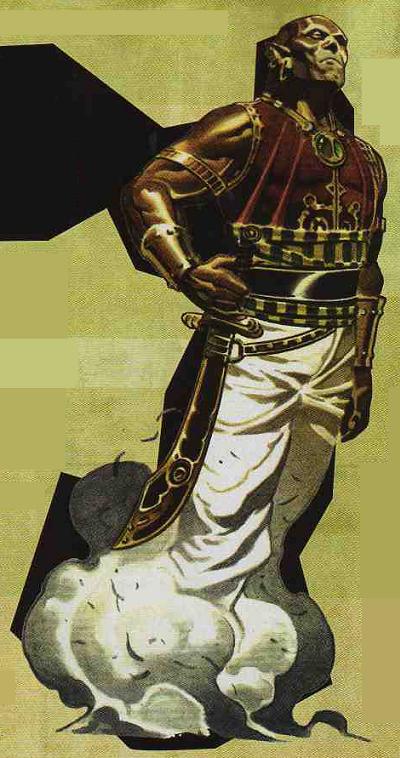
D'hin (singular d'hin'ni) are a race of planetouched descended from lightfoot halflings and djinn. They are generally impulsive and somewhat flighty, unable to concentrate on a single task for more than a moment.
D'hin vary widely in their appearance, but adult males are universally bald and females wear their dark hair long. They tend to stand a little taller than halflings, but not so tall as to be mistaken as dwarves. Most favor comfortable, loose-fitting clothes made of cotton or silk.
D'hin prefer to fight defensively, usually sniping with ranged attacks as a foe approaches. They rely heavily on hit-and-run tactics, very much like those of halflings, but they place more emphasis on mobility and less on cover and concealment.
D'hin live among halflings and fill all the myriad roles of their pureblooded kin, although they do tend more toward the study of magic than true halflings. D'hin speak Auran and Halfling, while those who travel outside halfling lands (as traders, mercenaries, or adventurers) also learn the Common tongue.
D'hin trace their ancestry back to halfling slaves of the Calim Empire and their djinn overseers. Persecuted by the genie-hating humans of early Coramshan, the d'hin fled northward into the Calishar Emirates as part of the great halfling migration. Today, d'hin are most common along the Sword Coast, concentrated in halfling comunities in Calimshan, the Purple Hills of Tethyr, the eastern shore of Lake Esmel, the Sunset Vale, and in the vicinity of Secomber.
D'hin are treated as lightfoot halflings for purposes of determining available regions.
From their halfling ancestors d'hin retain a certain amount of disinterest in moral and ethical debates, but from the djinn they keep a level of capricious unpredictability. Most, then, are represented by the chaotic neutral alignment.
Most venerate Brandobaris or Shaundakul, although the entire halfling pantheon (including Tymora) is revered.
D'HIN'NI RACIAL TRAITS
-
+2 Dexterity, +2 Charisma, -2 Wisdom.
-
Small size. +1 bonus to Armor Class, +1 bonus to attack rolls, +4 bonus to Hide checks, -4 penalty on grapple checks, lifting and carrying limits 3/4 those of Medium characters.
-
D'hin'ni base land speed is 20 feet.
-
Halfling Blood: For all special abilities and effects, a d'hin'ni is considered a halfling.
-
Darkvision out to 60 feet.
-
+1 racial bonus on all saving throws.
-
+2 racial bonus on attack rolls with thrown weapons and slings.
-
Racial Skills: +2 racial bonus on Climb, Jump, Listen, and Move Silently checks.
-
Air Mastery (Ex): Airborne creatures take a -1 penalty on attack and damage rolls against a d'hin'ni.
-
Spell-like Abilities: D'hin can cast prestidigitation at will. They can also cast gust of wind, whispering wind, or wind wall, once per day. Caster level equal to character level. The save is Charisma-based.
-
Automatic Languages: Common, Auran. Bonus Languages: Dwarven, Elven, Gnome, Goblin, Orc.
-
Favored Class: Sorcerer.
-
Level Adjustment: +1.
WORGHESTS
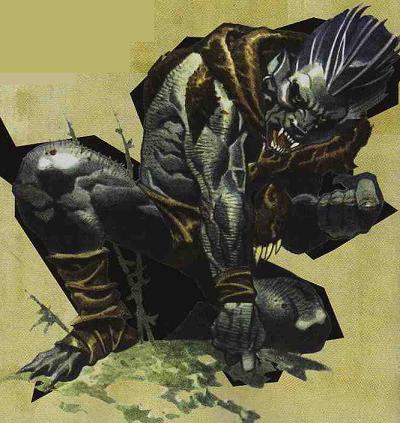
Worghests are a race of planetouched descended from barghests and goblins. They are generally cowardly, finding courage only in packs and when attacking from ambush.
Worghests vary widely in their appearance, although in general form they resemble hairy goblins with sharp teeth within wolflike snouts and hair of any blue shade. Worghests' eyes glow orange when they become excited. They favor hides as clothing, but often wear loincloths or nothing at all.
Worghests can bite in wolf form. Although they love killing, they have little stomach for direct combat and attack from ambush when possible.
Living among orcs and goblinoids, worghests demand - and receive - respect and fear from their pureblooded cousins. Despite often being the most powerful warriors in a tribe, worghests rarely attempt to become leaders - they prefer to live more freely than leadership positions allow. Worghests speak Infernal and Worg. Most who travel outside their packs (as raiders, mercenaries, or adventurers) know the Common tongue.
Worghests are most common around the Mines of Tethyamar - north and west of the Desertmouth Mountains - as many descend from the barghests that overran these dwarven holdings. Individual worghests also appear in goblin tribes across Faerûn that were led by barghests in generations past.
Worghests are treated as goblins for purposes of determining available regions.
Barghests typically possess powerful personalities - particularly when compared to orcs and goblinoids. As such, their descendants take on many of their personality traits, including a penchant for advancing within a group by playing within the rules and laws of the area.
Most worghests venerate Malar or deities of the goblin pantheon.
WORGHEST RACIAL TRAITS
-
+2 Strength, +2 Dexterity, -2 Charisma.
-
Medium size.
-
Worghest base land speed is 30 feet. In wolf form, base land speed is 50 feet.
-
Darkvision out to 60 feet.
-
Low-light vision.
-
Scent.
-
Racial Skills: Worghests have a +4 racial bonus on Move Silently checks.
-
Racial Feat: A worghest gains Track as a bonus feat.
-
Change Shape: A worghest can assume the shape of a wolf as a standard action. In wolf form, a worghest gains a bite attack. Worghests may also take feats requiring the druid's wild shape ability as a prerequisite.
-
Feed: When a worghest slays a humanoid opponent, it can feed on the corpse, devouring both flesh and life force, as a full-round action. Feeding destroys the victim's body and prevents any form of raising or resurrection that requires part of the corpse. There is a 50% chance that a wish, miracle, or true resurrection spell can restore a devoured victim to life. Check once for each destroyed creature. If the check fails, the creature cannot be brought back to life by mortal magic. A worghest gains the effects of a death knell when it feeds in this manner, using the creature's HD as the caster level.
-
Trip (in wolf form only): A worghest in wolf form that hits with a bite attack can attempt to trip the opponent as a free action without making a touch attack or provoking an attack of opportunity. If the attempt fails, the opponent cannot react to trip the wolf.
-
Automatic Languages: Common, Infernal, Worg. Bonus Languages: Giant, Goblin, Ogre, Orc.
-
Favored Class: Ranger.
-
Level Adjustment: +2.
CACTACAE
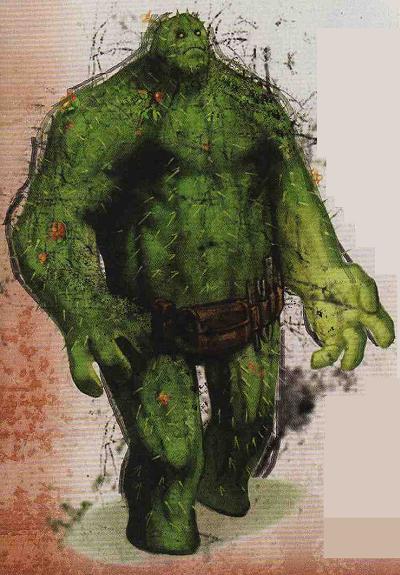
These powerful fighters are a race of cactus folk with wide-ranging homelands including both the veldts and northern grasslands as well as the deep deserts of Cymek, Dreer Samher, and the South. They typically stand 7 to 8 feet tall, with powerful vegetable muscles and thick fibrous skin in varying shades of green studded with spines extending from tiny to finger-long. Some specimens of gray, yellow, and brown are less common, and these varying skin colors might also indicate age or illness. In springtime, many cactacae sprout small red or yellow flowers along the ridges of their dark green skin.
Cactacae heads sit flat on their shoulders, without necks. Their fingers are thick and fairly clumsy, although their grip is powerful enough to crush bones. An oily sap flows through their veins rather than blood, and their bones are strangely shaped, unlike any vertebrate's skeleton. A full-grown cactacae is not just tall but also massive, weighing as much as 500 to 700 pounds.
Cactacae prefer climates oft heat and light, but they can be active day or night and survive cold temperatures with proper equipment. Their preferred garments tend toward colored sashes, loincloths, and rich jewelry.
Cactacae can sleep standing up with their legs locked. They speak Sunglari in the south around Dreer Samher, and Ragamoll in the north near New Crobuzon.
CACTACAE RACIAL TRAITS
-
+4 Strength, +2 Constitution, -4 Dexterity.
-
Medium: As Medium creatures, cactacae have no special bonuses or penalties due to their size.
-
Cactacae base land speed is 30 feet. Cactacae can move at this speed even when wearing medium or heavy armor or when carrying a medium or heavy load (unlike other creatures, whose speed is reduced in such situations).
-
Natural Armor: Cactacae gain a +1 natural armor bonus to their Armor Class. This protection combines with Dexterity, magical bonuses, and worn armor.
-
Plant Type: Cactacae are members of the Plant type and gain all of the abilities and vulnerabilities of that type, including immunity to poison, sleep effects, polymorph, paralysis, and stunning. They have low-light vision and are not subject to critical hits. Unlike other members of their type, they require sleep and are not immune to mind-affecting effects.
-
Powerful Build: The physical stature of a cactacae lets them function in many ways as if they were one size category larger. Whenever a cactacae is subject to a size modifier or special size modifier for an opposed dick (sich as during grapple checks, bull rush attempts, and trip attempts), the cactacae is treated as one size larger if doing so is advantageous. A cactacae can use weapons designed for a creature one size larger without penalty. However, their space and reach remain those of a creature of their actual size. The benefits of this racial trait stack with the effects of powers, abilities, and spells that change the subject's size category.
-
Spines: Thousands of tough spines cover the cactacae body. These protrusions allow them to deal 1d6 points of lethal damage (instead of 1d4 nonlethal) when they choose to deal damage as part of a successful grapple.
-
Weapon Familiarity: Cactacae may treat rivebows, chakri, and greatcleavers as martial weapons, rather than exotic weapons.
-
+2 racial bonus on Craft checks that are related to wood.
-
Automatic Languages: Common and Sunglari. Bonus Languages: Any (other than secret languages, such as Druidic).
-
Favored Class: Fighter.
-
Level Adjustment: +2.
THE TARDY
Using magic, the northern veldt-cactacae keep some of their bulbs in a coma for months after the others have long since crawled up from the soil. These late bloomers are the ge-ain, literally "the tardy." When they do grow to wakefulness, these cactacae are warped by the magic that retarded their birth. They are enormous, with bending wooden bones, fused fingers, and encrusted, thickened skin. Their misshapen tongues and lips make them slur and mangle their speech.
The average Tardy's senses are sharp, but they live in constant pain from their deformities. The cactacae never give the Tardy names, but they both fear and worship these twisted forms of their own kind. Tardy often serve as scouts and lookouts for cactacae tribes or societies at war.
The Tardy are Large size and have a +5 natural armor rather than +1. Their folded, thick skin and vegetal circulatory system provides damage reduction of 10/bludgeoning or slashing. Piercing weapons have little effect on a Tardy: they don't bleed as humans do, but rather exude watery sap that seals punctures quickly. The Tardy ability score modifiers are +8 Strength, +6 Constitution, -2 Wisdom, -6 Dexterity. The Tardy gain a +3 racial bonus on Spot and Listen checks. The Tardy have a level adjustment of +4.
KHEPRI
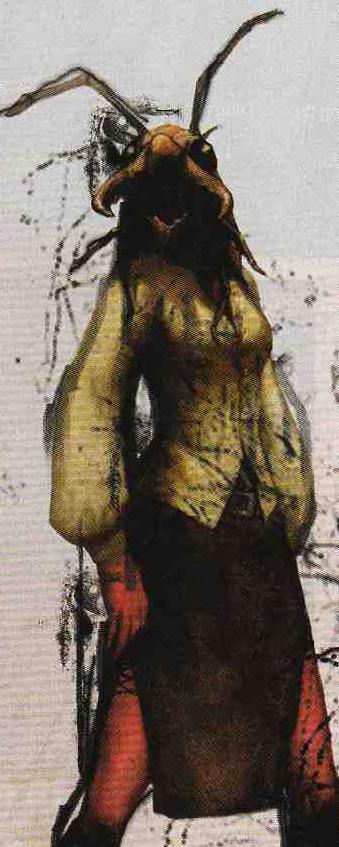
The khepri are a race of women with 2-foot-long headscarabs that resemble enormous beetles, complete with tiny mandibles, antennae, vestigial wings beneath powerful casings, and compound eyes. Khepri males are small insectile animals, essentially mindless 2-foot-long scuttling things unable to do more than feed and reproduce.
Female khepri brush their antennae in greeting to one another, much as humans shake hands. Khepri mouthparts cannot communicate in Common or any other tongue, although they communicate among themselves by scent and chemical gusts that form a powerful silent language that other races can smell and taste but cannot understand. Khepri speak to other races using sign language or written notes.
Khepri society is deeply sexist and matriarchal, because its males are too stupid to contribute to civilization. Most khepri sisters treat males with contempt, kicking them out of the way and keeping them in roughly the same regard as roaches. Only female khepri are available as player characters.
As a society, the khepri place less value on immediate family and more on clan and extended families. Khepri clans or extended families are called hives and their subdivisions are called moieties; the term "Redwing hive, Catskull moiety" can mean either individual khepri or a particular place in New Crobuzon's Kinken ghetto.
Khepri guards and fighters are prized for their silence and their skill, but many khepri turn to crime as well. The khepri crime-queens of New Crobuzon are well organized and very difficult to infiltrate. While the crime-queens are as unsentimental and greedy as any other gangsters, their followers' loyalties are not just about money: they are also partly based on hive and moiety. Their preferred weapons include spears, longspears, flintlocks, crossbows, and hooked nets.
The khepri are recent arrivals in New Crobuzon. They keep to themselves in ghettos of their own kind, forming an underclass of immigrants in districts such as Kinken, Creekside, and Spit Hearth. These districts are rebuilt from their human forms using gigantic home-grubs that burrow through the existing walls and exude an organic pleghm-cement to form the rounder, more hivelike shapes the khepri prefer. Their customary clothes include ballooning pantaloons and tightly-woven shirts.
Khepri religion is unlike that of other races; their pantheon is entirely unique and female. The traditional goddesses include Awesome Broodma, the Artspitter, Kindly Nurse, and the guardians known as the Tough Sisters. A new generation of goddesses has grown up since the time of the Tragic Crossing: the dissident gods. These include cults devoted to the Elyctirc Devil, the Air Harvester, Wingsister, and Insect Aspect. The last of these is a cult devoted to the mindless, insectile side of the species, and it makes a fetish of the tiny khepri males. The gloomy doctrine of Insect Aspect claims that khepri women are cursed, and that the purity of God can be a found in the male, insectile part of the species. Some Insect Aspect worshipers take no names for themselves (names are decadent), instead concentrating on food, sex, and survival without motive or thought.
The khepri first arrived in New Crobuzon about seven hundred years ago, not long after the Fervent Mantis arrived at the eastern continent of Bered Kai Nev, the khepri homeland. That homeland is now destroyed, as the terrible plague called the Ravening drove the khepri from Bered Kai Nev one hundred years ago. During that time, the khepri broodmothers of New Crobuzon deliberately forgot ten thousand years of khepri history - no one, not even the khepri themselves, is sure why. The refugees and survivors of the Tragic Crossing refuse to discuss it, although surely millions died in Bered Kai Nev during that time. This hole in their history is just one of the many griefs that have afflicted the khepri diaspora since it arrived in New Crobuzon.
KHEPRI RACIAL TRAITS
-
+2 Dexterity, +2 Wisdom, -2 Constitution, -2 Charisma.
-
Medium: As Medium creatures, khepri have no special bonuses or penalties due to their size:
-
Khepri base land speed is 30 feet.
-
Darkvision: Khepri can see in the dark up to 60 feet. Darkvision is black and white only, but it is otherwise like normal sight, and khepri can function just fine with no light at all.
-
+2 racial bonus on saving throws against enchantment (mind affecting) spells: Khepri minds are different enough from most creatures' minds that their thoughts are difficult to control.
-
+4 racial bonus on saving throws to resist gaze attacks: The insectoid eyes of the khepri headscarab filter many harmful sight-based effects.
-
+2 racial bonus on Intimidate and Spot checks.
-
Automatic Language: Khepri. Bonus Languages: Common.
-
Favored Class: Cleric.
REMADE
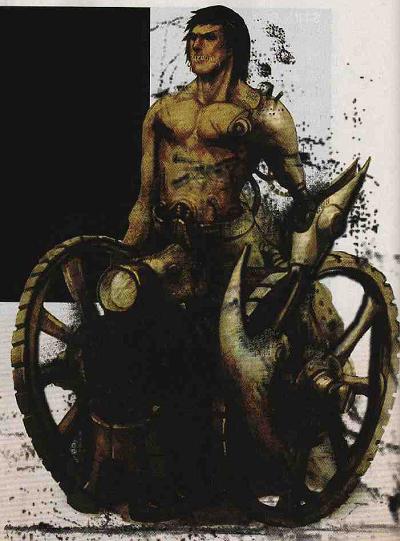
The Remade are not a true race, but rather a creation of the punishment factories of New Crobuzon. The flesh of criminals and political offenders is reshaped to suit the purposes of the city rulers; their limbs might be reshaped as a commentary on their crimes, or they might be rebuilt to serve in the colony of Nova Esperium, half the World away from the mother city.
Although their melding of flesh and machine makes the Remade resemble constructs, the race gains no construct immunities or innate advantages; the victims of the process must relearn walking, speaking, and other simple physical acts in their new bodies. Over time, they master the power their bodies give them.
Remade are almost always human, although some xenian Remade are known to exist. These are rare and attract a certain amount of curiosity just by their appearance; some of these xenian Remade support themselves by staging carnival sideshows and exhibition fights. Other Remade might come not from the punishment factories but from independent chirugeons who cater to gladiators, pit-fighters, bodyguards and others who seek to enhance their natural gifts.
CREATING A REMADE
"Remade" is an inherited template that can be added to any living, corporeal creature (referred to hereafter as the base creature).
A Remade uses all the base creature's statistics and special abilities except as noted here.
Special Qualities: Becoming a Remade requires the base creature to undergo a regimen of tortures, surgeries, and biothaumaturgical procedures. After enduring this precess, the character gains enhancements and the same number of defects, either specifically chosen by the DM or randomly rolled on the following charts.
Rather than determining exactly what a Remade looks like, these enhancements and defects assume that functionality is the important element. The consummate eyes enhancement could come from a set of gigantic compound eyes, from finely-ground crystal lenses and telescopes, or from a hawk's head fashioned into a sort of hat permanently attached to the PC. The appearance should be up to the player, the mechanics are defined here.
Remade Enhancements
| d10 roll |
Enhancement |
|---|---|
| 1 | Aquatic Prosthesis |
| 2 | Armored Integument |
| 3 | Consummnate Eyes |
| 4 | Metaclockwork |
| 5 | Night Vision |
| 6 | Olfactory Enhancers |
| 7 | Supernumerary Arms |
| 8 | Supernumerary Legs |
| 9 | Unnatural Weapon |
| 10 | Wakeful Engine |
Aquatic Prosthesis: The Remade gains primitive gills or an equivalent breathing apparatus. The gills are not especially effective, but grant a +4 bonus on checks or saving throws made to resist drowning or poison gas checks. In addition, the character gains a swim speed of 10 feet or, if he already has a swim speed, a 10-foot increase to his base swim speed.
Armored Integument: The character gains +1 natural armor.
Consummate Eyes: This Remade has extra eyes, granting him a +4 racial bonus on Search and Spot checks.
Metaclockwork: The Remade has a specialind metaclockwork component that performs a single thaumaturgical function 3 times per day. At the time of Remaking, the DM chooses three 0-level cleric or wizard spells the enhancement can replicate. Each function can be used multiple times per day, but every use counts toward the Remade's daily limit.
Night Vision: The character gains an additional 60 feet of darkvision, to a maximum of 240 feet.
Olfactory Enhancers: The character gains the benefits of the scent special ability.
Spring-loaded Jumper: The Remade is a powerful leaper and gains +4 bonus on all Balance and Jump checks.
Supernumerary Arms: The Remade is multi-limbed. This new limb is somehow awkward or weak but aids in a number of mundane tasks. The character gains a +2 bonus on Climb checks and can hold an item weighing less than 5 pounds in it. The hand does not have the articulation to wield a weapon or throw items. It also does not provide extra slots for magic items.
Supernumerary Legs: The Remade possess an additional leg, wheels, or powerful tentacles. This grants him a 5-foot increase in base speed and a +4 bonus on ability checks made to resist being bull rushed or tripped.
Unnatural Weapon: Some dangerous tool, makeshift claw, or wicked appendage has been permanently affixed to the Remade. This attachment can be used as a natural weapon and deals damage depending on the Remade's size.
| Remade's Size |
Weapon Damage |
|---|---|
| Fine | — |
| Diminutive | 1 |
| Tiny | 1d2 |
| Small | 1d3 |
| Medium | 1d4 |
| Large | 1d6 |
| Huge | 1d8 |
| Gargantuan | 2d6 |
| Colossal | 3d6 |
Wakeful Engine: Remade with the wakeful engine must take the boiler defect. Characters with this enhancement require no rest periods to avoid fatigue or exhaustion (although they still require periods of quiet contemplation to regain spells). This modification is often made to horses, oxen, and other beasts of burden.
Remade Defects
| d10 roll |
Defect |
|---|---|
| 1 | Boiler |
| 2 | Clumsy |
| 3 | Crippled Limb |
| 4 | Dulled Faculties |
| 5 | Hideous Deformity |
| 6 | Malfunctioning Memories |
| 7 | Poor Healing |
| 8 | Slow |
| 9 | Stiff Jointed |
| 10 | Wheels |
Boiler: The character has a steam boiler that constantly requires fuel, and costs 2 gp per day to feed. If fuel runs out, the character is immediately fatigued. For every day the boiler remains out, the character must make a Fortitude save (DC 14 + 1/day out) or be exhausted. Completely submerging in water or other liquids extinguishes the boiler. Characters with boilers weigh 40 pounds more than characters without.
Clumsy: Many Remade are of shoddy construction, and Remade are notoriously unable to control their bodies. Their attachments often fumble or fail at motor coordination. This Remade's Dexterity score drops by -2.
Crippled Limb: One of the character's hands or whole arms has been amputated, weakened, or warped to the point of near uselessness. The Remade cannot wield weapons with the afflicted limb or make use of weapons that require two hands. The limb lacks the ability to grip and cannot hold items, although, depending on the details of the defect, the Remade might still retain his finger and arm or wrist magic item slots.
Dulled Faculties: The Remade's normal senses are somehow compromised by his augmentations. Choose two of the following penalties: -4 on Listen checks, -4 on Search checks, or -4 on Spot checks.
Hideous Deformity: The Remade has been fashioned with oozing sores, sealed mouth, exposed muscle or bone, or similar visual flaws. The character takes a -4 penalty on Diplomacy and Gather Information checks.
Malfunctioning Memories: The character's brain has somehow been tampered with, affecting his memory and skills. There is a 25% chance that whenever the Remade makes a skill check he only counts half of his ranks to determine his skill modifier. This defect has no effect on skill checks in which the character has no ranks.
Poor Healing: The Remade does not recover from injuries well. The character regains only a quarter as many hit points from natural healing as he normally would (minimum 1 hp per day).
Slow: Because of their complex skeletal structures, metal parts, and general bolted-together natures, some Remade are simply not that fast. These characters' base movement is reduced by -10 feet.
Stiff Jointed: The character is bound by rusty metal joints, awkward bony outcroppings, poorly healed wounds, or a variety of other maladies that hinder his movement. He takes a -4 penalty on Balance, Jump, and Tumble checks.
Wheels: Remade without legs and feet must make DC 14 Strength checks to move over any space of rough terrain. (This DC might be higher in certain situations, as determined by the DM.) Failure means that the character has wasted 5 feet of movement and must either choose another path or try again (if he has any movement remaining). He cannot charge or run over even mildly uneven ground. These Remade cannot climb stairs or ladders without a Strength check for each to feet of length (DC 15 for stairs, DC 20 for ladders). All Swim and Ride checks take a -4 penally.
Level Adjustment: Same as base creature +1.
VODYANOI
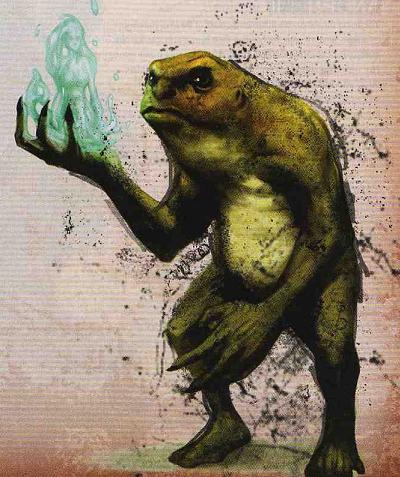
The vodyanoi resemble fishy frogs with largely human faces and huge hands. They are excellent craefters of magic and small sorceries: many are dowsers, shamans, or warlocks of one stripe or another, although some are also druids. They are fully amphibian, capable of staying underwater without needing to breathe air and able to stay on dry land for days or weeks, as long as they can wet down their skins with at least 1 gallon of water per day.
Vodyanoi seem smaller than they truly are because of their hunched and squatting posture, and they rarely seem to stand much more than 4 feet high. Their true size is apparent from their weight, however, as most tip the scales at more than 170 pounds and the fattest among them weigh 300 pounds or more. Their hands and feet are lightly webbed, but their fingers are nimble.
Many vodyanoi worship Palgolak, a god of knowledge and learning who commands his vodyanoi and human followers to learn, to categorize, and to share knowledge. The New Crobuzon Palgolak Library is the best in the city, and its doors are open to all.
Vodyanoi speak Ragamoll in New Crobuzon as well as Fellid Vodyanoi, Lubbock Vodyanoi, Southern Vodyanoi, and many other dialects of their language. Most work near the waterfront. Some are pilots and navigators, but most are stevedores and dockworkers. Their homes are amphibious as well, without internal doors and with huge rooms above and below the water. Sluices refresh the water in them every day, and most connect by canal passageways.
All vodyanoi have some skill at watercraeft, as they refer to elemental water magic. This magic is not as formal as human magic, but is a sort of folkloric magic focused on shamanic channeling and shaping of water energies.
VODYANOI RACIAL TRAITS
-
+2 Dexterity, +2 Charisma, -2 Wisdom.
-
Medium: As Medium creatures, vodyanoi have no special bonuses or penalties due to their size.
-
Vodyanoi base land speed is 20 feet. Their swimming base speed is 40 feet. Vodyanoi have a +8 racial bonus on any Swim check to perform some special action or avoid a hazard. They can always choose to take 10 on a Swim check, even if distracted or endangered. Vodyanoi can use the run action while swimming, provided they swim in a straight line.
-
Vodyanoi gain a +2 racial saving throw bonus against illusion spells or effects.
-
Low-Light Vision.
-
Watercraeft: Vodyanoi have the incredible ability to shape water to suit their needs. This ability allows a vodyanoi to affect water as per either the spell control water or stone shape (but affecting water instead of stone), cast as a sorcerer of a level equal to his class level. A vodyanoi can use this ability a number of times per day equal to his Charisma modifier. The durations of these spells changes to concentration + 3 rounds.
-
All vodyanoi gain a +1 bonus to the DC of all spells in divination, illusion, conjuration (summoning), or enchantment (charm). The school must be chosen when the character is created.
-
+2 racial bonus on Concentration, Jump, and Spellcraft checks. A vodyanoi who merely passes within 5 feet of a water source or permanent spell effect is entitled to a Search check to notice it. This ability does not tell the vodyanoi any details, such as the school, strength, or nature of the spell.
-
Spell-Like Abilities: 1/day - speak with animals (aquatic animal only, duration 1 minute). A vodyanoi with a Charisma score of at least 10 also has the following spell-like abilities: 1/day - jump, longstrider, mending. Caster level 1st; save DC 10 + vodyanoi's Cha modifier + spell level.
-
Automatic Languages: Common and Vodyanoi. Bonus Languages: Cactacae, Druidic, Salt.
-
Favored Class: Sorcerer.
-
Level Adjustment: +1.
GARUDA
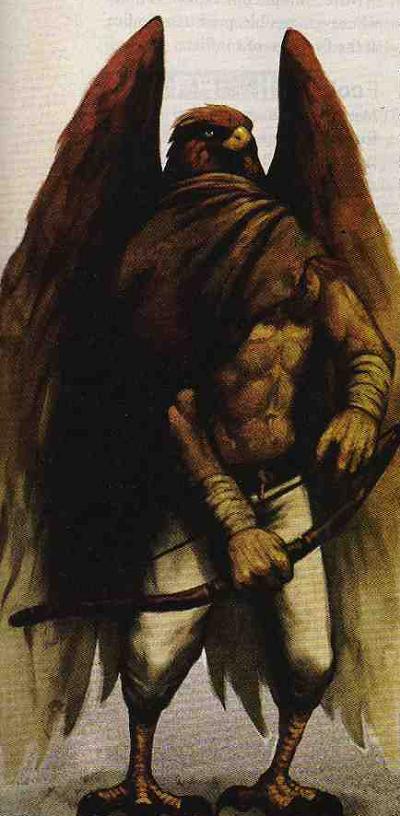
A race of desert birdfolk, the Garuda are proud and noble hunters, spending most of their time engaging in a hunt or performing other vital tasks for their tribe.
Garuda typically stand just over 6 feet tall and weigh between 100 and 150 pounds. Although their skin color is most commonly a wash of tan, their feathers can vary wildly from gray and white to brown and tan.
Ganda are masters of hunting targets from the air. To this end, they use dropped and ranged weapons, and they often glide into position silently, gaining complete surprise. They land only when injured or to finish off their prey. When hunting, garuda use composite bows, spears, longspears, and whips. Their typical prey includes birds as well as earthbound animals.
The garuda possess powerful claws, hollow bones, excellent eyesight, and a great love of freedom. Their tribal society is completely egalitarian and rarely has any need of city-made goods or customs; they do not use money or pray to deities or spirits. Most live in the Cymek desert, while others dwell in the north of Shotek and the west of Mordiga. The Cymek garuda include a librarian clan who travels with trunks containing thousands of volumes, many of them otherwise lost. A tent city springs up around this clan's center of learning wherever it lands, and other clans bring them books, and other goods.
Those garuda who go to cities are often confined to ghettos. Garuda in New Crobuzon dwell in a region called Spatters, on the distant outskirts of the city, at the top of tower blocks refitted with perches and nesting space open to the sky.
Garuda follow their own strange legal code. To them, denial of choice is the moral compass that determines criminal action, and all crimes are the same crime, called "choice-theft." Any garuda who murders, rapes, or enslaves another is guilty of the blackest crime and is typically exiled from the tribe after his or her wings are cut off. Few survive the desert long in this condition.
Most garuda never leave the Cymek desert, and those who do are often "abstract individuals," as tha garuda call exiles. Other are more familiar with human customs, such as the ghetto garuda of New Crobuzon. These garuda are rarely well-off, and only the strongest or cleverest escape their low origins. All garuda make excellent scouts and trackers.
All garuda prefer the open sky and find buildings and underground structures completely repellant.
Garuda speak Common and their own language of piping, raucous sounds. Residing in the higher registers, Garuda cannot be Spoken by human voices.
GARUDA RACIAL TRAITS
-
+4 Strength, +6 Dexterity, -2 Charisma.
-
Medium size.
-
+2 natural armor bonus.
-
Garuda base land speed is 30 feet. They also have a fly speed of 40 feet with average maneuverabikty.
-
Racial Hit Dice: A garuda begins with three levels of humanoid (garuda), which provide 3d8 Hit Dice, a base attack bonus of +2, and base saving throw modifiers of Fort +1, Ref +3, and Will +1.
-
Racial Skills: A garuda's humanoid levels give it skill points equal to 6 × (2 + Int modifier, minimum 1). Its class skills are Hide, Move Silently, and Spot.
-
Racial Feats: A garuda's humanoid levels give it two feats.
-
Natural Weapons: 2 claws (1d4).
-
Vertical Strike (Ex): Garuda gain double the normal range increment when firing straight down from at least 30 feet overhead. If the attack roll is successful, they also gain a +2 bonus on damage rolls.
-
Chaos Resistance (Ex): Garuda are either the products of chaos magic or have simply lived near it and with it long enough to build up a tolerance. Either way, spells and abilities with the Chaos descriptor do not affect them as easily, and they gain a +2 racial bonus against effects such as those generated by the Cacotopic Stain and outsiders with the chaotic subtype.
-
Hunter's Eyes (Ex): Garuda can see their foes from a great distance in the air. They gain a +8 racial bonus on Spot checks in daylight hours made while flying.
-
Automatic Languages: Common and Garuda. Bonus Languages: Any (other than secret languages, such as Druidic).
-
Favored Class: Ranger.
-
Level Adjustment: +1.
EXILED MODRONS
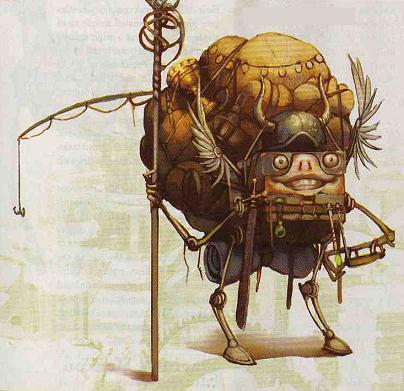
The existence of the rogue modrons adds a twist to the rigid hierarchy of modron society. Sometimes commands are misinterpreted (even among the modrons), and contradictory instructions can pass through two separate chains of command to the same modron. Although exceedingly rare; this conflict can easily lead to a modron going insane, abandoning its duties, and turning rogue. Other contradictions in experience, such as on the chaotic plane of Limbo, can also cause a modron to go rogue. Even more rarely, the seeds of disobedience occur naturally within a modron, so that it grows discontent with service to the bureaucracy as a whole, even without an outside contradiction confronting it. Sages theorize that perhaps Primus himself plants these seeds in order to gain a further understanding of the universe.
Whatever the cause, rogues are hunted down and destroyed without mercy by their fellow modrons. The racial opposition they feel against rogue modrons far surpasses any they experience, even toward truly chaotic creatures such as the slaad.
Of course, modrons are the epitome of bureaucracy. Even with how reviled rogue modrons are, a rare process exists for modrons to be exiled. This occurs mostly in modrons of quadrone level and above, since they have the intellect to sometimes realize their own rogue nature and begin the petition process before they are discovered and destroyed. Tridrones and lower castes typically realize what has happened to them too late, when a squad of pentadrones arrives to destroy them.
Even among the rare few who begin the process, a very select number are approved for exle. These exiles undergo a physical transformation within the Modron Cathedral at the center of Regulus, which breaks their bond to the Energy Pool. This transforms them into a creature that resembles a quadrone, but with a few different characteristics. Those sages who believe that Primus often plants the seeds of conflict within some modrons also theorize that Primus himself approves those modrons for exile in order for them to explore the planes unhindered by the rigidity of modron duties.
With their bond to the modron Energy Pool broken they gain the living construct subtype, losing many of the powerful immunities of standard constructs along with their Hit Dice. Essentially, exiled modrons begin their lives again with a few faint memories of their past life. True modrons, and even many rogue modrons, view the exiles as they view any other nonmodron outsider. They are no better or worse than a human or tiefling.
Although these characters have a range of personalities, they tend toward lawful alignment and still prefer to know the hierarchy of command within any group they join. They differ from true modrons, however, in that they can be far more flexible and adapt to various new situations without resorting to a set of standard procedures. Still being modrons, though, they often have difficulty comprehending, illogical mortal ideas - like art, passion, or honor. This leads many to propose convoluted rationalizations or endless interrogations of those who demonstrate such traits.
Exiled modrons are not from any caste. They can be any alignment (although they tend toward lawfulness) and any character class. Exiled modrons are always exactly 5 1/2 feet tall and weigh 400 pounds.
EXILED MODRON RACIAL TRAITS
-
+2 Constitution, +2 Intelligence, -2 Dexterity, -2 Charisma.
-
Medium size: As Medium creatures, exiled modrons have no special bonuses or penalties due to their size.
-
Construct (living construct): As living constructs, exiled modrons differ from both other constructs as well as other living creatures.
-
Exiled modron base land speed is 30 feet. Exiled modrons possess vestigial wings, but lack any flight ability.
-
Surprise Vulnerability: Due to the conflict of free will and their innate sense of order, exiled modrons have a difficult time reacting to surprises. As such, they are considered flat-footed until the second turn in combats they did not initiate. They are still able to act on their first round, but remain flat-footed.
-
The durable shell of an exiled modron grants acid, cold, and fire resistance 2. They also gain a +2 natural armor bonus.
-
Exiled modrons retain some degree of their alien intelligence and hence receive a +2 racial bonus on all saving throws versus illusions and mind-affecting effects.
-
Exiled modrons take a -2 penalty on all Charisma-based skill checks made against chaotic creatures.
-
Exiled modrons gain a +2 racial bonus on Spot and Listen checks.
-
Exiled modrons cannot wear standard armor or clothing, including, robes, vests, and shirts. Such items have to be custom made to fit.
-
Automatic Languages: Common. Bonus Languages: Celestial, Gnome, Infernal, and Modron.
-
Favored Class: First class taken. The class that an exiled modron takes its first level in becomes its favored class.
-
Level Adjustment: +1.